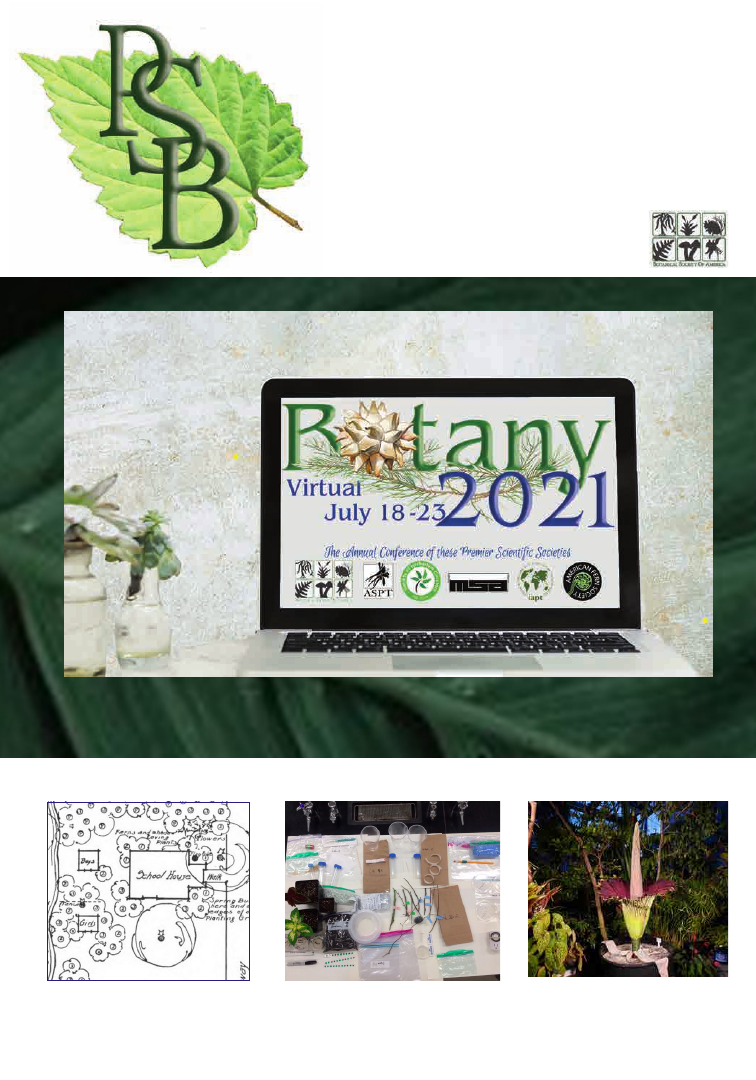
IN THIS ISSUE...
SPRING 2021 VOLUME 67 NUMBER 1
PLANT SCIENCE
BULLETIN
A PUBLICATION OF THE BOTANICAL SOCIETY OF AMERICA
Teaching a Distance Botany Laboratory.....p. 16
When a Titan Arum Blooms
During Quarantine.... p. 29
Botany with Spirit Cornell Rural
School Leaflets and Gardening....p. 4
Registration Now Open!
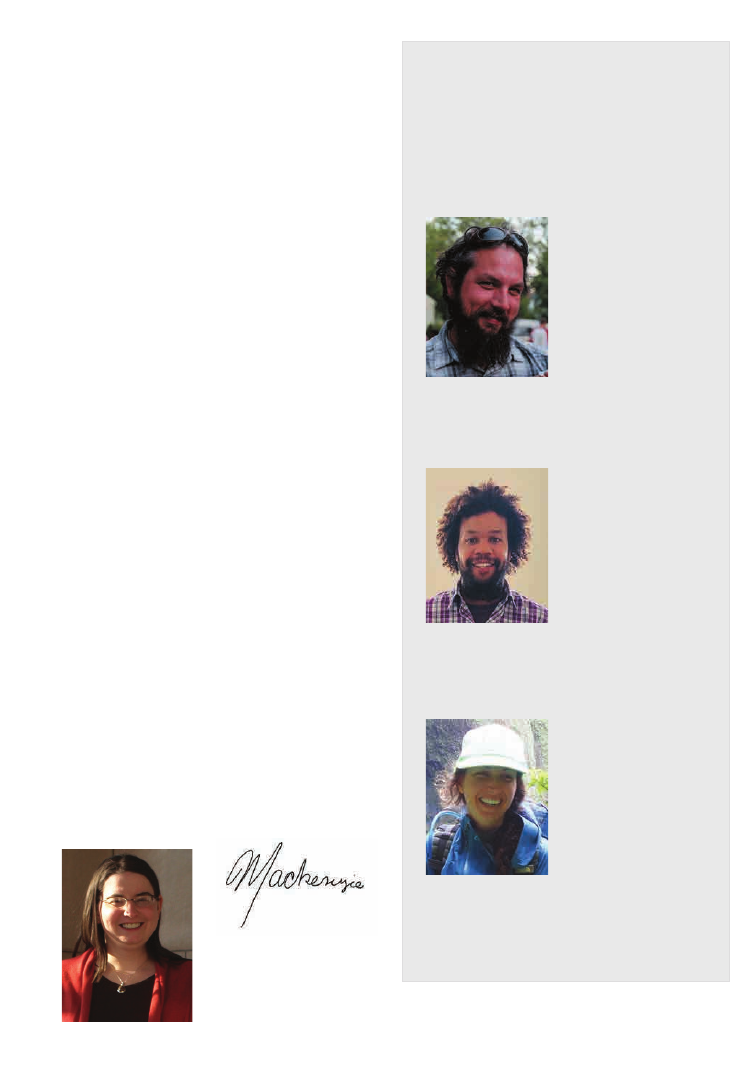
Spring 2021 Volume 67 Number 1
PLANT SCIENCE BULLETIN
Editorial Committee
Volume 67
From the Editor
David Tank
(2021)
Department of Biological
Sciences
University of Idaho
Moscow, ID 83844
dtank@uidaho.edu
James McDaniel
(2022)
Botany Department
University of Wisconsin
Madison
Madison, WI 53706
jlmcdaniel@wisc.edu
Seana K. Walsh
(2023)
National Tropical Botanical
Garden
Kalāheo, HI 96741
swalsh@ntbg.org
Greetings,
Welcome to 2021! As I write this in early
March, my institution has just released
the first official sign-up for faculty Covid
vaccinations. It is exactly one week shy of a
year since campus closed in March 2020.
Although campus essentially reopened in
July, doing my job is not the same as it was a
year ago.
As I peruse this issue of Plant Science
Bulletin, it strikes me that the articles share
a theme. They discuss how botanists of the
past and present have used the technology
of the time to share botanical knowledge
and inspire others. Although botanists have
been participating in and perfecting online
teaching and learning for decades, it is fair to
say that the pandemic has forced many events
that might have otherwise been in-person to
virtual platforms. As a community, botanists
have been able to respond in innovative ways.
Just as in the past, botanists have been able to
harness the resources available to reach broad
audiences.
I hope you enjoy these articles and find them
useful. If you have a teaching or outreach
experience that was modified due to the
pandemic and you would like to share, please
reach out to me!
Sincerely,
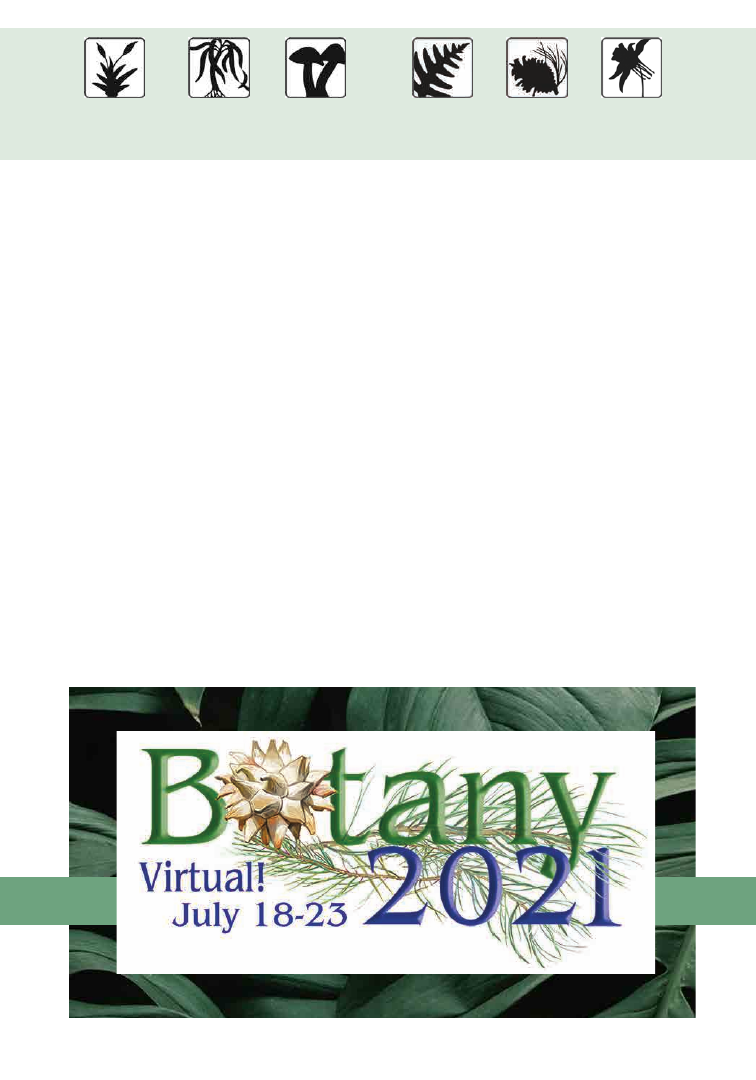
1
TABLE OF CONTENTS
SOCIETY NEWS
2020 A Year in Review ..................................................................................................................................................2
Botany 2021 - Virtual! .....................................................................................................................................................3
SPECIAL FEATURES
Botany with Spirit: Cornell Rural School Leaflets and Gardening ........................................................4
Teaching a Distance Botany Laboratory with Online, Outdoor, and Hands-On
Exercises ......................................................................................................................................................................16
When a Titan Arum Blooms During Quarantine (aka, Making a Stink Online) ...........................29
SCIENCE EDUCATION
Spring 2021 PlantingScience Session Summary ........................................................................................36
STUDENT SECTION
Roundup of Student Opportunities ......................................................................................................................39
ANNOUNCEMENTS
American Society for Gravitational & Space Research Names Asteroid
after Dr. John Kiss ...................................................................................................................................................54
BOOK REVIEWS
.................................................................................................................................................54

2
SOCIETY NEWS
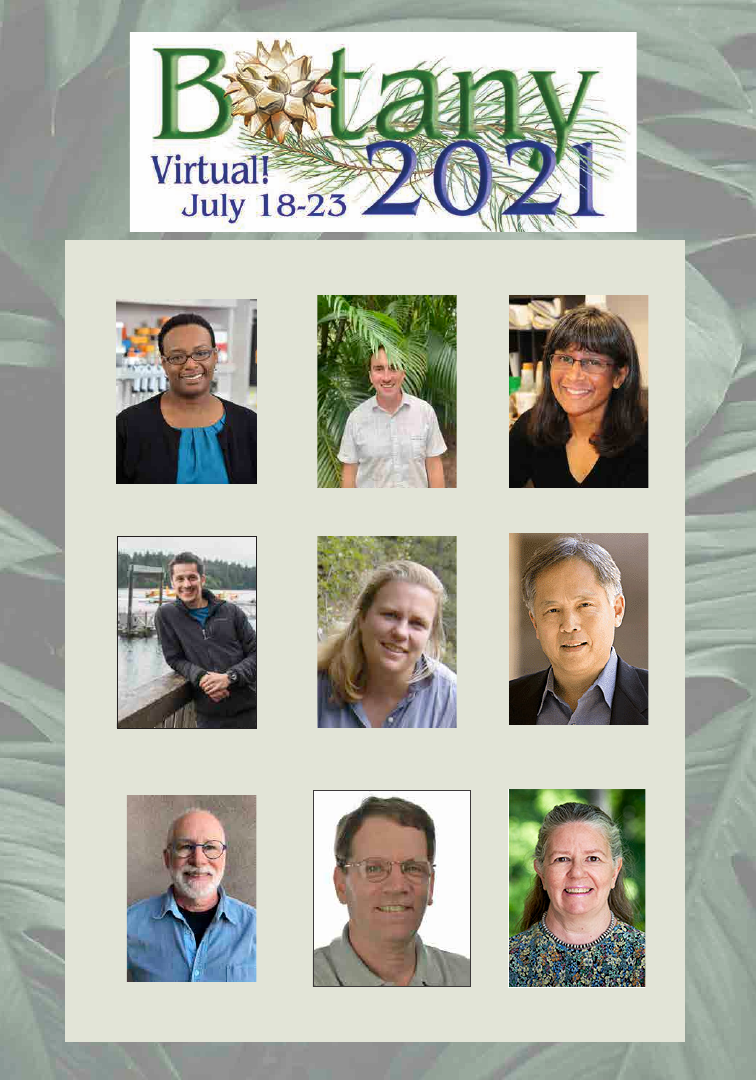
PSB 67(1) 2021
3
Beronda Montgomery
Plenary Address
Anita Sil
MSA Karling Address
Chris Muir
BSA Emerging Leader
Mario Vallejo-Marin
Annals of Botany
Address
Carolyn Ferguson
Incoming ASPT President
David Asai
Belonging in Botany
Michael Donohue
Incoming BSA President
Marc Cubeta
MSA Presidential Address
M. Alejandra Gandolfo-Nixon
Kaplan Lecture
Botany 2021 Featured Speakers

4
Nature-study is not science.
It is not knowledge. It is not facts.
It is spirit.
It is concerned with the child’s outlook on
the world.
-L. H. Bailey, 1903
SPECIAL FEATURES
By Karen Wellner
Chandler-Gilbert
Community College
Email:
karen.wellner@cgc.edu
I
n a recent Plant Science Bulletin issue, author
Karen Penders St. Clair (2019) introduced us
to several early botany instructors at Cornell
University. Several of these instructors,
namely Liberty H. Bailey, Anna B. Comstock,
Alice G. McCloskey, and John W. Spencer,
were profoundly important in making
Cornell University synonymous with that
of early-1900s nature-study education. One
of the factors that helped establish Cornell’s
nature-study program was farm kids and
Botany with Spirit:
Cornell Rural School Leaflets
and Gardening
the trouble that they seemed to be in. The
economic depression in the early 1880s
resulted in chronic low produce prices
and increased costs to farmers. As farming
communities fought against rising debt, many
farms were lost and rural migration to cities
soon followed. In New York, this migration
proved so worrisome that the state formed a
Committee for the Promotion of Agriculture.
Anna Comstock was an early committee
member who suggested that Cornell’s
Department of Agriculture develop a nature-
study program for rural schools (Doris, 2002).
Comstock and others feared that children and
teenagers moving to urban areas would soon
lose touch with nature, and along with it, an
abandonment of their appreciation for the
green world.
In the United States, the idea of studying
nature in an outdoor setting did not first
appear at Cornell, but in Chicago, essentially
at the same time that the United States was
struggling with economic depression. Teacher
educators such as John Dewey made the
University of Chicago a hub for progressive
education. One of Dewey’s ideas that quickly
took hold in the upper Midwest was the idea
of hands-on study and using the outdoors for

PSB 67(1) 2021
5
play and exploration. A colleague of Dewey’s,
Wilbur Jackman, became one of the earliest
recognized proponents of nature-study in the
early 1890s (Kohlstedt, 2008). Early nature-
study texts by Jackman (1891) and botanist
John Merle Coulter (1909), also at the
University of Chicago and later president of
the Botanical Society of America in 1896 and
1915, helped establish nature-study education’s
roots in Chicago. In addition, the 1894 Report
of the Committee of Ten on Secondary School
Studies and its subcommittee meeting at
the University of Chicago dealing with the
topic of natural history education saw its
10 members recommend nature-study for
elementary grade school children. Among
the subcommittee members were botanist
Charles E. Bessey, BSA’s second president
(1895) John M. Coulter, and nature-study
advocate Charles B. Scott from the St. Paul
school system in Minnesota. The committee
members agreed that the primary goal of
nature-study was to interest young children
in nature and to gain knowledge by hands-
on exploration in the outdoors environment
(National Education Association, 1894).
From Chicago, outdoor education spread
across the Midwest and eastern states, most
notably embraced by two Cornell University
faculty members: Bailey, a horticultural
science professor who served as the president
of BSA in 1926, and Comstock, who in
later years was awarded the title of nature
study professor. Unlike teacher programs at
Chicago and Columbia University, Bailey and
Comstock’s nature-study program targeted
rural, rather than urban, school children. This
was mainly due to the fact that Cornell was
surrounded by farmland, woods, and water—
all available resources for the many rural
school teachers and their students in western
New York. These two educators, along with
others at Cornell, were aided in 1894 and
1903 by the state’s decision to give large grants
to Cornell to establish an agriculture college,
along with funds for the hiring of new faculty,
some of whom advocated for the teaching of
agriculture and nature-study in rural schools.
Under Bailey’s guidance, the agriculture
college at Cornell University galvanized
nature-study education by gathering
naturalists, agriculturists, and educators
together to produce a myriad of teacher
workshops, student leaflets, teacher’s guides,
courses for farmers, magazines, handbooks,
and naturalist clubs. It is an understatement
to say that the nature-study movement at
Cornell was anything but prolific.
As a technically trained botanist and friend
of Coulter, Bailey distinguished between
nature-study and more systematic work in
natural history and biology. Nature-study,
Bailey argued, would lead not to new truths
but, rather, to a sympathetic attitude toward
nature. At the turn of the century, nature-
study resonated well with the public audience
and attracted such supporters as Theodore
Roosevelt, University of Iowa botanist Thomas
H. McBride, and, later, the nature writer Aldo
Leopold (Kohlstedt, 2005).
CORNELL RURAL
SCHOOL LEAFLETS
Bailey and Comstock so earnestly believed in
nature-study that they expended new energy
to launch a nature publication intended for
rural school teachers and their students.
The Cornell Rural School Leaflet (CRSL) was
published by Cornell’s College of Agriculture
from 1907 to 1959 (Fig. 1). Financed with a
New York state grant, one of the conditions
set by the state was that educational leaflets
be distributed only to New York state teachers
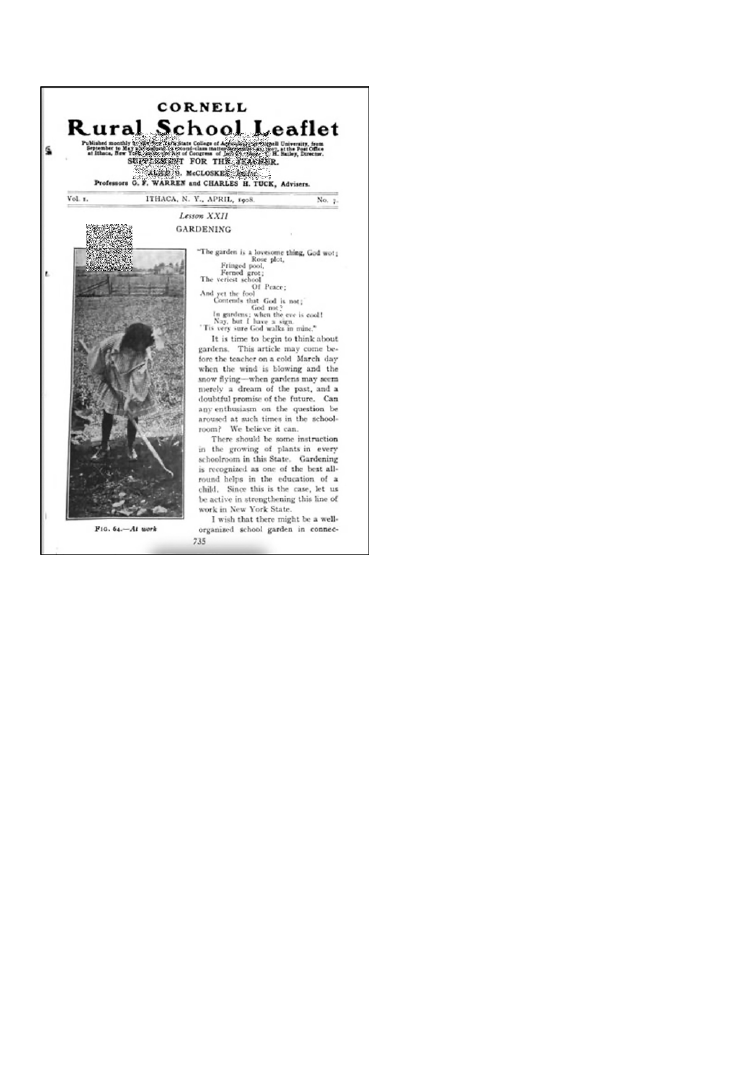
PSB 67 (1) 2021
6
and students, with the hope that children
who remained on farms and in small towns
would now study and appreciate nature and
agriculture in a local setting. Nature-study
advocates at Cornell also encouraged children
to take what they were learning home to
their parents, many of whom had a limited
educational background, to develop more
receptiveness to scientific practices and a love
of the rural environment. Bailey was certain
that nature-study could help train future
farmers and future farmer housewives to think
twice about leaving their idyllic countryside
for New York City.
The CRSL publications were of two forms:
those intended for teachers and shorter leaflets
for students. Teacher leaflets were mailed at
the beginning of the school year and provided
overviews and suggestions of how to use
nature-study with students. The teacher was
provided with a form to fill out with students’
names, which was sent back to Cornell. The
student leaflets were mailed, normally three or
four times a year, to the school teacher who
then distributed them to his or her students.
Areas of study proposed by the CRSLs ranged
from bee-keeping, raising chickens, milk-
testing, and of course, studying plants. In
examining a number of early leaflets, I found
that botany content lent itself to one of four
categories: gardens and their connection
to county, state, and Cornell agriculture
fairs; plants in their own habitats and their
ecological importance; forestry and lumber;
and problems for plants (fungal diseases and
weeds). The focus of this article is on CRSLs
and school gardens.
While leaflets and pamphlets may have
made the idea of nature-study inviting,
most rural teachers taught in a one-room
schoolhouse with different-age students (Fig.
2). These same teachers had a limited science
background and trying out something new
with such a wide variety of ages outdoors
probably made class control worrisome to
many instructors. Even teachers who took a
basic science course in progressive normal
schools were not taught the pedagogical skills
to teach nature-study (Kohlstedt, 2005). To
allay fears, the editors of CRSL published
many testimonials from successful nature-
study teachers. Some teachers expressed
their initial hesitation with nature-study, but
they provided anecdotal evidence of how
they themselves, along with their students,
Figure 1. The April 1908 Cornell Rural School
Leaflet for teachers with gardening highlighted
(p. 735).
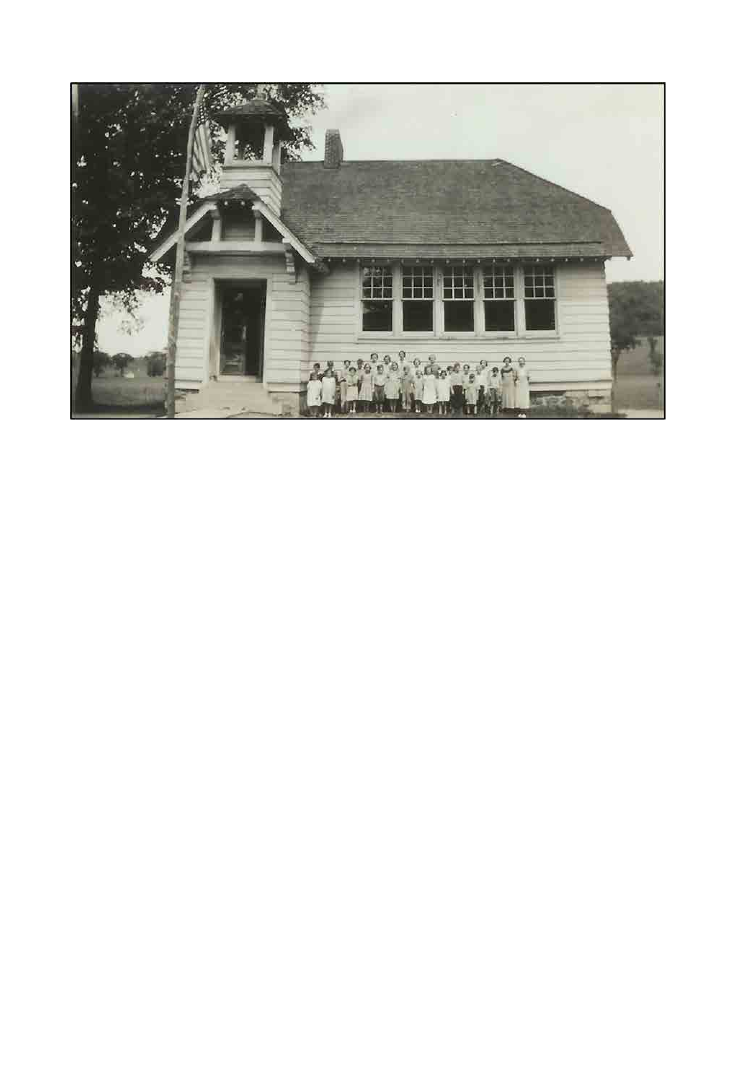
PSB 67(1) 2021
7
benefitted educationally and spiritually from
nature-study and, in particular, gardening. In
addition, teachers were encouraged to attend
Cornell’s summer teacher institutes where
they would learn how to implement nature-
study in their classrooms.
CORNELL RURAL
SCHOOL
LEAFLET
AND GARDENING
The term “nature-study” often conjures up
ideas of walking through the woods, looking
for birds, insects, trees, leaves, and flowers.
A large number of the early CRSLs, however,
were devoted to gardening. In the first
CRSL issue, sent to rural school teachers in
September 1907, Bailey exalted that gardens
were for everyone. Gardens involved students
of all ages and were used as an incentive to
reward hard work, establish school spirit, and
recognize the economic value of plants—so
that when students had their own farms, they
would use sound scientific practices to plant
and harvest their crops.
Bailey identified four types of school
gardens for teachers’ consideration. First,
the ornamental garden to make the school
grounds attractive to the community and to
develop civic-mindedness in students. Second,
the plot-garden in which students would
obtain hands-on experience with edible-
food gardening. Here, the plants chosen to
grow in the garden bridged the gap between
wild nature and domesticated learning (Fig.
3). The third garden identified by Bailey was
the problem garden, a scaled-down version
of an experimental field garden, in which
experiments could take place. The problem
garden did not have to stand alone, but could
just be a cordoned-off area in the plot garden
(Bailey, 1907). Last, there was the wild garden,
Figure 2. One-room schoolhouse in West Edmeston, Madison County, NY. This is the
type of school setting that the Cornell Rural School Leaflet targeted (date unknown,
personal collection).
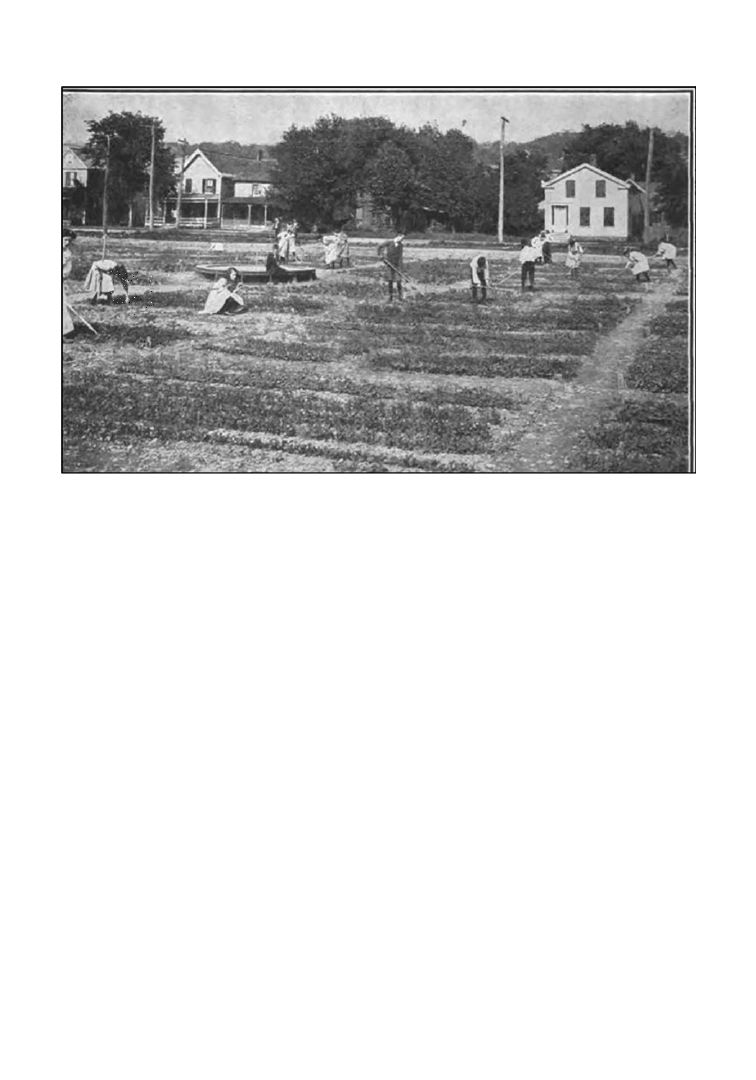
PSB 67 (1) 2021
8
an area already growing plants where children
would transplant wild and local plants in it.
Bailey instructed teachers to start slowly and
to choose just one garden to work on first. It
did not matter which type, since any school
garden was considered a laboratory of living
things.
Alice McCloskey, editor of the early nature-
study leaflets, also placed special emphasis on
school gardens in the first CRSL issues. She
claimed that the garden and garden activities
formed one of the most important features of
work in nature-study agriculture. McCloskey
was adamant that nature-study was not merely
an opportunity for rural students, but that
nature-study was an absolute right of every
rural child to “know the possibilities that lie
in intelligent work on the farm” (McCloskey,
1907, p. 5).
Like Bailey, McCloskey urged teachers to
start small and simple. The benefits would far
outweigh the initial risks since gardens offered
“inquiry, accuracy, patience, perseverance,
and courage in time of adversity” (McCloskey,
1908, p. 754). While other nature-study ideas
like dairy cows were also discussed in many
issues of the CRSLs, the school garden and the
Corn Day competition at Cornell were heavily
revisited and placed in every teacher’s edition
from 1907 through 1910.
Making a successful garden is not easy. The
CRSL provided the groundwork for teachers
with instructions on how to situate and design
a garden and offered activities that students
could do in their school gardens (Gowans,
1908). These activities, some of which
teachers could modify into experiments,
included determining the composition of soil,
investigating the capillarity of soil, growing
alfalfa under variable conditions, how deep to
Figure 3. Ithaca school plot garden. Cornell Rural School Leaflet April 1908, p. 736.
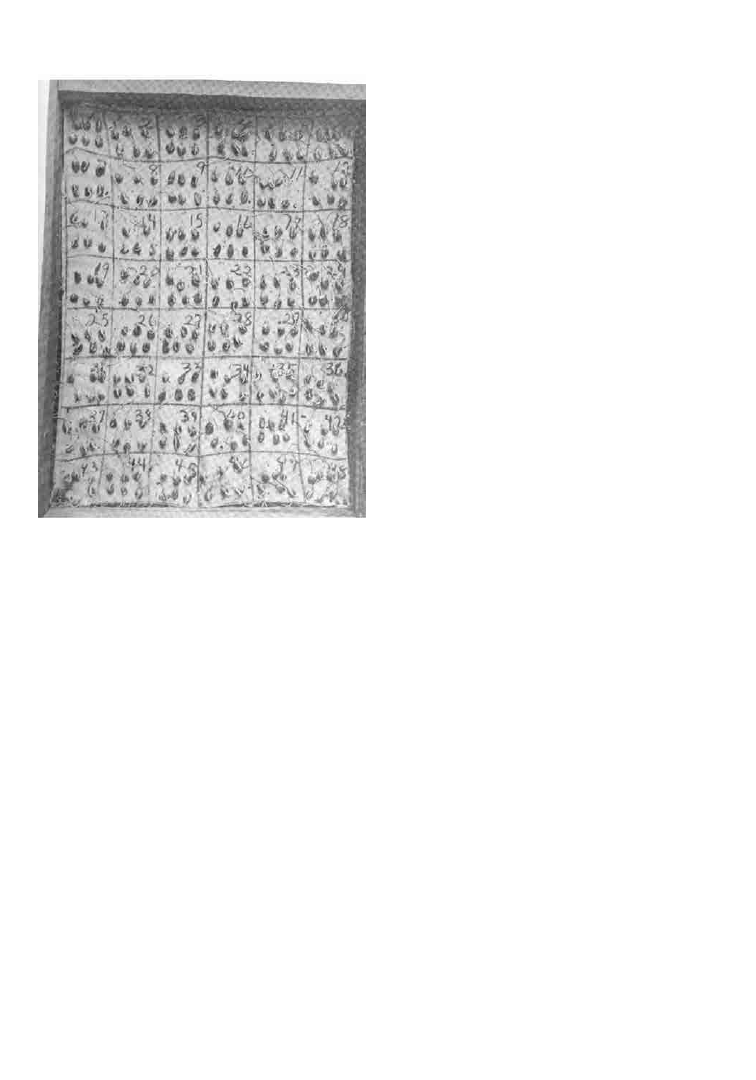
PSB 67(1) 2021
9
plant beans seeds, treating potato tubers with
formaldehyde to prevent scab, and placing
seeds in different experimental conditions
(Fig. 4).
Gardens also provided an incentive to students
in the form of awards, by entering the best of
their crops in local or state fairs. Without fail,
Corn Days, Aster Days, and Flower Days were
promoted by the CRSL editors and students
were urged to send their best entries to Farm
Days at Cornell. Many of the agriculture
competitions required that students grow
crops or flowers and develop displays outside
of the classroom. It was felt that such work
helped students assume responsibility and
develop a duty to their teachers, peers, and
parents. Added to this was the experience
that students gained by following the life
cycle of a plant and seeing it through to the
competition. This experience was holistic
because the plants were grown outside in a
field or a garden where the environment—the
impacts of the soil, rainfall, and sunny days—
were directly involved with the life cycle of the
plant.
In 1910, the state education board’s newly
released nature-study syllabus was published
in the CRSL. The previous looseness of
nature-study, with its emphasis on the study
of all things local and seasonal, now gave way
to a specified list of special plants for study,
trees for study, flowers for study, animals to
study, insects to study, birds to study, and so
on. Rural teachers soon found that they had
less control over what was taught and much
more content to cover. For example, the first
leaflet for teachers in 1907 was only 12 pages
long. The September 1911 CRSL for teachers
was an astounding 172 pages long. And none
of those pages included much talk about
school gardens or local learning. There were
a few short articles about vegetable gardens as
rumblings of war in Europe emerged, but for
the most part, it would take the country’s entry
into World War I to make gardens important
again with nature-study.
SCHOOL GARDENS,
CORNELL RURAL
SCHOOL LEAFLET, AND
WWI
As U.S. involvement in the war in Europe
intensified, so too did the concern about
food shortages at home. In 1917, the Bureau
of Education created the United States
School Garden Army. Funded by the War
Department, these gardens became known as
Figure 4. A germination box comparing dif-
ferent corn seeds in preparation for gardening
work. From Cornell Rural School Leaflet Feb-
ruary 1909, p. 143.
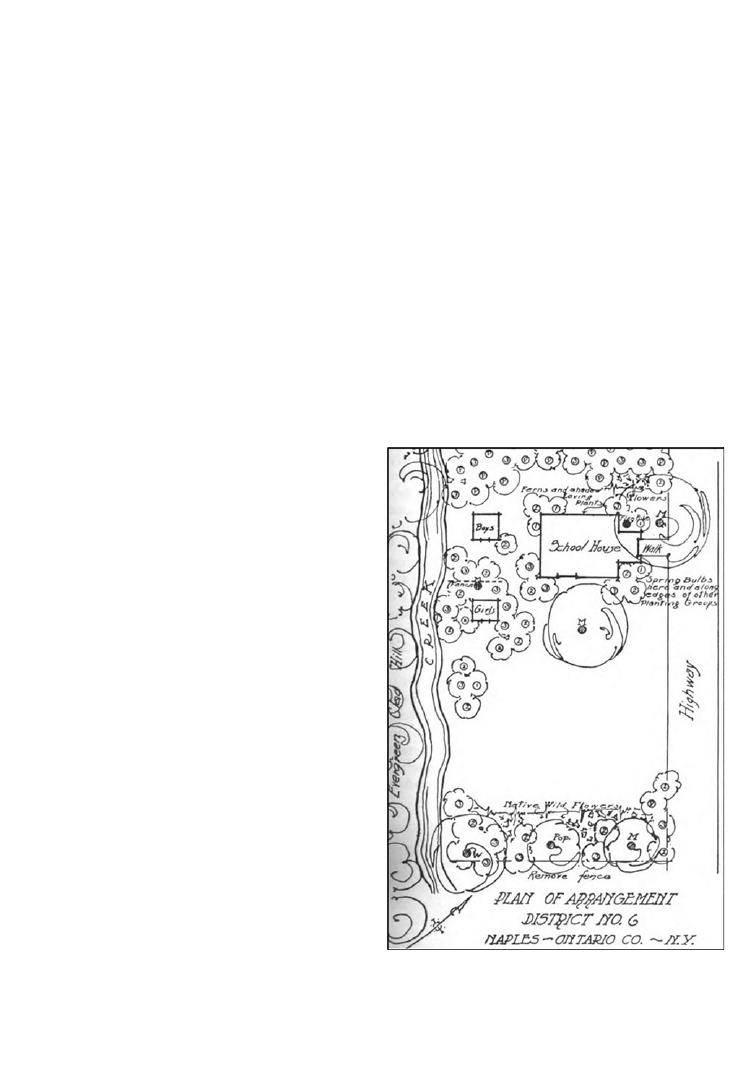
PSB 67 (1) 2021
10
victory gardens or war gardens. The School
Garden Army targeted school children to
grow food produce. President Woodrow
Wilson was a strong advocate of school
gardens, linking children’s garden work to
military patriotism. Eventually, the National
War Garden Commission was founded and
took steps to “militarize” the students. Urged
to help, students were given an insignia and
a rank, along with instructions about food
production. Not everyone, though, agreed
with the Commission’s approach. Critics
like former Harvard president Charles
Eliot believed that hyping children up with
patriotic duty was wrong. He urged Wilson
and the Commission to stop referring to
school children as soldiers—they were simply
children planting seeds (Kohlstedt, 2008).
How did the Agriculture College at Cornell
react to outside agencies now involved with
student gardens? The CRSL September 1917
issue for teachers saw its editor, Edward Tuttle,
noting that the increase in gardens in the U.S.
was due to the demand for food production.
This new garden movement presented, in
Tuttle’s words, “opportunities and many
dangers” (Tuttle, 1917, p. 282). Tuttle stressed
that children’s gardens should serve as an
educational opportunity with an education
department oversight, rather than a federal
commission. To Tuttle, the various agencies
now involved with gardens was worrisome
since they could easily manipulate children to
place more importance on production quotas
and therefore be viewed as a worker more
than an inquisitive child. As the government
became more involved with gardening, the
pedagogy of nature-study gardens disappeared
into the background.
In the same issue, a reprint of a 1908 article
by Alice McCloskey, founder and late editor
of the CRSL, was published under the title,
“Gardening with Children.” Her question of
what gardens provided students with, whether
the country was at war or peace, included
civic pride, landscape design, planting and
harvesting, and generosity with giving the
crop to neighbors and friends.
Gardens were again targeted as a prime way to
make school grounds attractive with an article
written by Cornell’s landscape architecture
professor Ralph W. Curtis (1917). A sketch of
how to properly place shrubs and a wildflower
garden for a good school ground appearance
Figure 5. Landscaping school grounds; another
use of gardens in Cornell Rural School Leaflet
November 1917, p. 299

PSB 67(1) 2021
11
was provided (Fig. 5). The use of McCloskey
and Curtis’s articles made the appeal to
teachers that gardens were multipurpose and
not solely intended as food munitions for war.
In the November 1917 issue of CRSL, teachers
were offered information on something new:
junior home projects. Although previous
CRSLs contained information about home
gardens and raising cattle and poultry on
farms, the introduction of the junior home
project reflected on the ongoing war in
Europe and production of food for home and
abroad. The CRSL again stressed the need to
place all student agricultural and domestic
science activities under the jurisdiction of the
State Department of Education, lest “selfish
exploitation of boys and girls” should continue
(Griffin, 1917, p. 326).
Students interested in home projects,
including tending to gardens, were now
required to fill out paperwork for the school
superintendent, who would communicate
with the student and his or her teacher, who
would communicate with Cornell’s College
of Agriculture staff, who would then provide
preliminary instructions to the student and
teacher. The College also sent record books
for the student to keep track of costs and
income in order for academic credit. The flow
chart shown in Figure 6 illustrates the top-
down approach to gardening during the war.
All of this regimentation certainly would have
irritated Bailey. Although Bailey retired as
Dean of the Agriculture College in 1913, he
continued to promote the idea that farmers
and children of farmers needed a nature-study
outlook, instead of just money to guide them
(Bailey, 1908).
The decline of school and home gardening
after World War I is noted by contemporary
historians Sally G. Kohlstedt and Kevin C.
Armitage. In particular, Kohlstedt (2008)
attributes the decline of gardens to a lack
of government support and a diminished
national attention to patriotic school kids.
This was most likely true for victory gardens,
but what about nature-study’s attachment
to school gardens? Did rural school gardens
also disappear? An examination of CRSLs
published before and after World War I does
show a reduction in the number of garden
articles, but this decline actually started before
the war. There are several reasons for this
decline in gardens with nature-study.
By the early 1900s, biologists were moving
from field laboratories to the more-controlled
science laboratory located inside of a
building. This move was accompanied by the
belief that science education should also
make such a migration and take on a more
rigorous approach to the teaching of science.
For example, an article published recently in
Plant Science Bulletin introduced us to botany
educator and former BSA president, William
Ganong (Sundberg, 2020). In Ganong’s book
The Teaching Botanist (1915), he faulted
nature-study instruction since it deprived the
science-minded student the opportunity to
find his or her chief interests. What Ganong
may have meant here is that students were not
exposed thoroughly enough to astronomy,
chemistry, physics, or other fields of science
at an early age. Ganong also criticized student
drawings of plants that he considered too
impressionistic and not scientifically correct.
The sentimentality that teachers expressed for
nature was also criticized. Many university
biologists believed that good science meant
objectivity, not sympathy toward plants and
animals or reciting poems about them. As
the practice of science and science education
veered toward quantification of results, critics
posed the question of how you could quantify
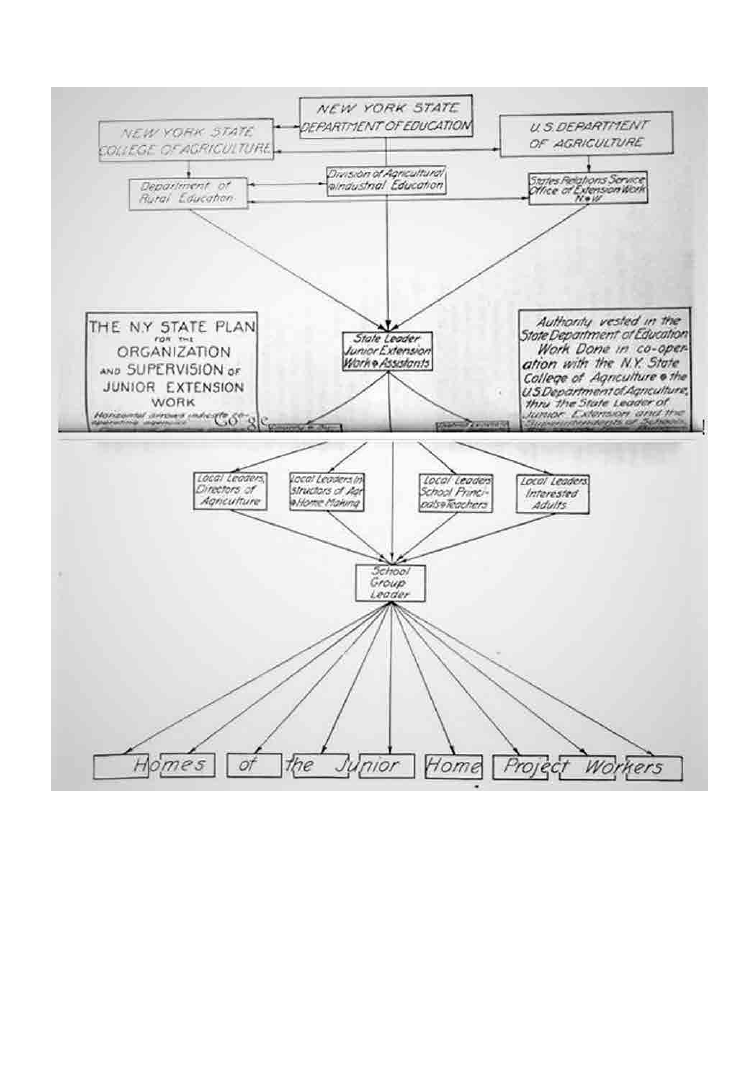
PSB 67(1) 2021
12
Figure 6. Planting gardens during WWI becomes driven by patriotism rather than inquiry.
From Cornell Rural School Leaflet November 1917, pp. 348-349.

PSB 67 (1) 2021
13
something as vague as appreciation and
respect. Other scientists were vocal about the
pedagogical rigor of nature-study and its lack
of experimental design (Armitage, 2009).
Other biologists and educators did not criticize
nature-study itself, but faulted the teachers
involved with it. It should be noted that a
majority of rural teachers were women while
their critics were men in higher education or
science occupations. Teachers were attacked
for having no understanding of nature or the
scientific method. Such teacher incompetence,
scientists and science educators argued, led to
an unscientific study of one’s surroundings
and an emotional view of nature. Buoyed
with poems and sing-songs, nature-study
seemed to lack the scientific and disciplinary
character called for by scientists starting in the
early 1900s (Beal, 1902).
Around 1914, rural education changed its
focus as state legislators called for a more
robust and vocationally focused agriculture
curriculum in rural schools (Kleibard,
2004). Nature-study critics argued that these
problems could be resolved by giving students
a solid, scientific agriculture education rather
than a romanticized study of nature that
included frolicking about in gardens. This
change in the nature-study curriculum was
followed by the 1925 Cole-Rice Law, which
provided building aid for the construction
of large centralized schools. The one-room
schoolhouse quickly became a thing of the
past, along with established connections that
nature-study advocates at Cornell had fostered
with rural school teachers. Teachers were no
longer encouraged to make decisions about
science study based on the local environment.
Outdoor field trips, collecting leaves, and
tilling the school garden were replaced by
textbooks and classroom demonstrations.
By the mid-1930s the term “nature-study” was
replaced the term “elementary school science”
(Palmer, 1957; Tolley, 1994). In the September
1932 edition of CRSL for teachers, the editor
wrote that the State Education Department
was ready to publish its tentative science
outline for elementary schools. This was
accompanied by content objectives for each
area of study, broken down for grades 1-2, 3-4,
and 5-6. In education, content objectives often
pave the way for standardized testing, which
means that teachers must meet the objectives,
often at the expense of doing anything else.
The very nature of unit tests was at odds with
Bailey’s reasons for nature-study. In Bailey’s
words, state departments wrongly viewed
examinations to be the only test of student
learning. Nature-study was intended to be so
informal that it could not possibly lend itself
to systematic examinations (Bailey, 1899).
Nonetheless, the CRSL continued throughout
the 1930s, although its focus was now on
conservation education. While forests,
animals, and soil were still a part of nature-
study, the emphasis was now on the “jobs”
that those things did for humans rather than
the development of student sympathy and
inquiry surrounding the outdoors. Cornell’s
nature-study program and field botany began
serious unraveling in the 1940s, as the call
for more efficiency and more content in
schools pushed nature-study out the door.
In the September 1940 CRSL, editor Palmer
made a plea to teachers to take their students
outdoors. He stated that science teaching was
now confined to a classroom and a textbook,
making teachers hesitant to go outside. He
offered background materials with teacher
directions for field trips that could even take
place during recess time (Palmer et al., 1940).
Some of Palmer’s suggestions included
visiting electrical powerlines and junkyards,
which seemed in sad contrast to forests and

PSB 67(1) 2021
14
gardens. In 1958 the CRSL changed its name
to the Cornell Science Leaflet. It was now
available to all students, rural or urban, for
20 cents a copy. The new Cornell publication
made it only to March, 1959 with a short
leaflet dedicated to birds. The impact of the
CRSL, however, did not end in 1959. The
leaflet spurred the publication of other like-
minded teacher publications by biological
supply companies and was a model for The
Kansas School Naturalist (1954-present) (M.
Sundberg, personal communication, January
19, 2021).
SUMMARY
Nature-study was devised to counter a loss of
rural life and the connection to the natural
world. Initially, Cornell’s nature-study
program was a combination of agriculture
and less-altered habitats for study. Plants such
as corn and beans were studied alongside
wild orchids and skunk cabbage. With such
a broad program (remember that zoology,
entomology, meteorology, agriculture, and
botany were all part of nature-study), the
Progressive Era naturalists at Cornell sought
to prepare students (and teachers) to observe,
think, predict, and plan. As school districts
became centralized and science in general
became more experimental, the science
curriculum underwent a top-down, content-
laden approach that teachers were required to
closely follow.
While critics lamented about nature-study’s
lack of inquiry, I found that the early CRSL
writers provided many garden and plant
questions for the teacher to ask of students.
Some of the questions had the potential to
lead to what we now call guided inquiry and
project-based learning. Rather than memorize
a myriad of plant parts, students were to study
the plant as a whole. For example, Bailey
(1903) provided the types of questions that
teachers could ask in the field when coming
upon dandelions: where does it grow? Do
dandelions on the lawn look like dandelions
along a roadside? As students worked
more and more with whole plants, Bailey
suggested looking at plant societies: what
plants grow together and where? In this way,
students were involved with categorizing
on their own, rather than reading about
plant categories from a text. Students were
encouraged to keep field notebooks and
gardening journals while in school and
during the long summer vacation. Of
course, songs and poems were always part
of the CRSLs and this is what naysayers
focused on. If critics had critically read the
CRSLs, coupled with the understanding
that children learn and process information
differently than adults, they most likely
would have approved many experiential
aspects of nature-study, including the spirit
of outdoor gardening.
LITERATURE CITED
Armitage, K. C. 2009. The Nature Study
Movement. The Forgotten Popularizer of
America’s Conservation Ethic. University of
Kansas Press, Lawrence, KS.
Bailey, L. H. 1899. An Effort to Help the
Farmer. Cornell University Agricultural Ex-
periment Station Bulletin 159: 1-34.
Bailey, L. H. 1903. The Nature-Study Idea
Being an Interpretation of the New School De-
velopment to put the Child in Sympathy with
Nature. Doubleday, Page & Co., New York.
Bailey, L. H. 1907. The Point of View. Cor-
nell Rural School Leaflet for Teachers 1: 1-12.

PSB 67(1) 2021
15
Bailey, L. H. 1908. The State and the Farmer.
MacMillan, New York.
Beal, W. J. 1902. What is Nature Study? Sci-
ence 16: 910-913.
Coulter, J. M., and A. J. Patterson. 1909. Prac-
tical Nature Study and Elementary Agriculture:
A Manual for the use of Teachers and Normal
Students. D. Appleton & Co., New York.
Curtis, R. W. 1917. How to Make School
Ground Attractive. Cornell Rural School Leaf-
let for Teachers 11: 294-300.
Doris, E. E. 2002. The Practice of Nature
Study: What Reformers Imagined and What
Teachers Did. PhD Dissertation, Harvard Uni-
versity, Cambridge, MA.
Ganong, W. F. 1915. The Teaching Botanist.
A Manual of Information upon Botanical In-
struction, 2nd ed. Macmillan, New York.
Gowans, E. 1908. Home Gardens. Cornell Ru-
ral School Leaflet for Teachers 11: 763-767.
Griffin, F. L. 1917. Suggestions for Organiz-
ing and Supervising Junior Home Project
Work. Cornell Rural School Leaflet for Teach-
ers 11: 325-372.
Jackman, W. S. 1891. Nature Study for the
Common Schools. Henry Holt, New York.
Kleibard, H. M. 2004. The Struggle for the
American Curriculum 1893-1958. Routledge
Falmer, New York.
Kohlstedt, S. G. 2005. Nature, Not Books:
Scientific Initiatives and the Origins of the
Nature Study Movement in the 1890s. ISIS
96: 324-352.
Kohlstedt, S. G. 2008. A Better Crop of Boys
and Girls: The School Gardening Movement,
1890-1920. History of Education Quarterly
48: 58-93.
McCloskey, A. B. 1907. Nature-Study Agri-
culture. Cornell Rural School Leaflet 1: 1.
McCloskey, A. B. 1908. Gardens. Cornell Ru-
ral School Leaflet 1: 754.
National Education Association. 1894. The
Report of the Committee of Ten on Secondary
School Studies with the Reports of the Confer-
ences arranged by the Committee. American
Book Co., New York.
Palmer, E. L. 1957. Fifty Years of Nature-
Study and the American Nature Study Soci-
ety. Nature Magazine 50: 474-480.
Palmer, E. L., E. L. Gordon, V. E. Schmidt,
and W. Thurber. 1940. Elementary School
Field Experiences in Natural Science. Cornell
School Rural Leaflet 34: 5-48.
Penders St. Clair, K. 2019. Inspirational Voic-
es in Early Botanical Education. Plant Sci-
ence Bulletin 65: 161-171.
Sundberg, M. D. 2020. “he Teaching Bota-
nist: William F. Ganong and the Botanical
Society of America. Plant Science Bulletin
66: 206-230.
Tolley, K. 1994. Study Nature, Not Books:
The Nature Study Curriculum 1891-1932.
Paper presented at the Annual Meeting of the
American Educational Research Association,
April 5-8, New Orleans.
Tuttle, E. M. 1917. Forward. Cornell Rural
School Leaflet 11: 282.

PSB 67(1) 2021
16
Teaching a Distance Botany
Laboratory with Online, Outdoor,
and Hands-On Exercises
Abstract
Even before the global pandemic accelerated the trend
toward online learning, the number of online and remote
STEM courses, including those with laboratories, had
been steadily increasing. Including botany courses with
laboratories as part of these offerings increases student
exposure to this discipline. However, it is a challenge to
create engaging remote laboratories that foster interest
and allow students to interact directly with plants. We
describe our approach to teaching a non-traditional
botany laboratory that combines a laboratory kit with
plants with outdoor and online activities. We describe
the communication strategies and laboratory exercises,
with links provided for activities and kit provisions.
Additionally, we highlight lessons and continuing
challenges in order to help other instructors create
related courses.
Key words
Biology laboratory, distance education,
laboratory kits, online laboratory,
remote learning
O
nline enrollments across disciplines
have steadily increased (Seamen et al., 2018),
with more than 30% of college students
at public and non-profit institutions in
the United States enrolled in at least some
distance education courses in 2018 (U.S.
Department of Education, National Center
for Education Statistics Fast Facts, 2019).
The shift to online learning due to the
pandemic may lead more students and
instructors to adopt and retain distance
education approaches.
Online and face-to-face (F2F) courses differ
in the students they attract. Most notably,
non-traditional students are more likely
than traditional students to enroll in online
courses, especially in STEM courses (Pontes
et al., 2010; Wladis et al., 2015a,b). Female
students are generally more likely than male
students to enroll in online courses (Shea
and Bidjerano, 2014; Wladis et al., 2015a;
U.S. Department of Education National
Center for Education Statistics Table 311.22,
2018), especially in STEM disciplines
(Wladis et al., 2015b). In contrast, Black and
Latino students are less likely to enroll in
online STEM courses (Shea and Bidjerano,
2014; Wladis et al., 2015a), particularly
after accounting for gender and non-
traditional characteristics (Wladis et al.,
2015b). Finally, students are more likely to
enroll in online courses if they live farther
from campus (Shea and Bidjerano, 2014)
or have physical disabilities (Pontes et al.,
University of South Carolina Upstate
800 University Way, Spartanburg, SC 29303
,
Katherine P. Farrah
kfarrah@uscupstate.edu
Benjamin R. Montgomery
montgo55@uscupsate.edu

PSB 67(1) 2021
17
2010; Faulconer and Gruss, 2018). These
demographic differences suggest that a mix of
online and traditional botany courses would
reach a broader group of students.
For STEM courses, including botany, it is
challenging to deliver laboratory content
that meets learning objectives without F2F
instruction. Laboratory learning objectives
may go beyond reinforcing content knowledge
from lecture and include (1) the ability to
engage in aspects of the scientific method
and communicating scientific results; (2)
developing career-readiness competencies,
including problem-solving, teamwork,
communication skills, and proficiency
with digital technology; and (3) practical
discipline-specific skills (Faulconer and Gruss,
2018). While it has been suggested that F2F
labs are central to scientific education, reviews
of studies have found that students achieve
learning objectives similarly in both F2F
and non-traditional laboratories for STEM
courses generally (Brinson, 2015) and biology
courses more specifically (Biel and Brame,
2015). It has also been suggested that online
labs are effective lower-cost alternatives to F2F
laboratories (Chirikov et al., 2020), although
a mix of both approaches can be even more
effective (Sypsas and Kalles, 2018).
Asynchronous formats better accommodate
students with scheduling conflicts due to
work, family, or limited computer access
(Harris et al., 2020), although Brinson (2015)
recommends using a mix of synchronous and
asynchronous approaches for laboratories.
Non-traditional laboratories may be taught
exclusively online or involve hands-on
activities. For labs delivered electronically,
Faulconer and Gruss (2018) distinguish
between “online labs,” which typically rely
on simulations or archived materials and
“remote laboratories,” in which students
manipulate instrumentation via computer.
These researchers suggest that hands-on
labs in which students physically interact
with supplies that students gather, retrieve
from campus, or receive through a shipment
be termed “distance laboratories,” with the
category “non-traditional laboratories”
comprising remote and distance formats.
Non-traditional laboratories can help
to achieve the discipline’s long-standing
goal of strengthening education and
communication about plants and the
economic and environmental services they
provide (Botanical Society of America, 1995)
by reaching more students and a different
subset of students. Botanical education
must overcome “plant awareness disparity”
(Parsely, 2020), a non-ableist term that
describes the condition wherein people lack
awareness, recognition, and appreciation
of plants and their roles in ecosystems and
societies (Wandersee and Schussler, 1999).
We think that letting students interact with
living plants is the best way to foster an
interest in plants, so we prefer a distance-
laboratory format when feasible. Moreover,
an advantage of distance laboratories
generally is that students are able to directly
interact with materials to have opportunities
for tangible results and sensory feedback
(Faulconer and Gruss, 2018). However, the
ability of students to acquire and maintain
plants away from campus is limited by their
disparate geographic locations, climate, and
living arrangements. Additionally, acquiring
supplies has costs, whether to the student or
the institution. Outdoor exercises are also
limited by geographic, logistic, and safety
considerations. Online laboratories based
on freely available datasets and activities
create flexibility without adding expense.

PSB 67(1) 2021
18
To address tradeoffs between distance and
online laboratories, we have adopted a hybrid
approach that mixes online and distance
laboratory approaches.
BOTANY & SOCIETY
LABORATORY
We describe here the required laboratory
for a course titled “Botany & Society,” an
asynchronous, 4-credit, general-education
course for non-science majors taught at
a southeastern regional comprehensive
university. The lecture portion of the course
follows a typical asynchronous online format,
with narrated lectures available on YouTube,
associated readings, quizzes associated with
each lecture, supplemental learning activities,
and multiple exams. Laboratory exercises,
which support the learning objectives listed
in Box 1, reinforce lecture content while
emphasizing botanical skills, critical thinking,
hypothesis testing, the scientific method, and
digital communication skills.
The laboratory, taught over either a 14-week
semester or 8-week summer semester, includes
16 exercises with a mix of online, outdoor,
indoor plant, and lab-kit based activities. Most
exercises are completed in a single assignment,
while others extend across multiple weeks.
Exercises are described below with additional
details and instructions for students provided
at tinyurl.com/onlinebotany. Assessment
is based on completion of assignments and
comprehension questions instead of lab
practicals.
Box 1
Learning objectives for Botany
& Society, a general-education,
asynchronous botany labora-
tory for non-science majors.
• Gain experience growing and ma-
nipulating plants
• Recognize features that distinguish
different plant groups
• Understand role of observations
and the scientific method to learn
about natural world
• Be able to use databases and online
tools to investigate the natural
world
• Increase proficiency in commu-
nicating science in writing and
using technology
Many exercises require live plants, safety
equipment, and other supplies, which are
provided in a laboratory kit assembled by
the instructors and either picked up by
students or shipped to them (Figure 1). The
only supplies students procure themselves
are isopropyl alcohol, a flower for dissection,
and produce for a macromolecules exercise.
Each kit contains a unique set of stickers,
which students affix to items they photograph
to ensure that the photographs they submit
are of their own work. An $80 laboratory fee
covers the cost of supplies and shipping.

PSB 67(1) 2021
19
Table 1. Laboratory exercises divided into activity type (outdoor, online, growing plants,
etc.), as well as the associated assessment method(s). Most assignments, except those sub-
mitted to Padlet, are completed using tools on Blackboard, the course learning management
system or are submitted there.
Laboratory
Exercise
Assessment
Method(s)
Laboratory
Exercise
Assessment
Method(s)
Growing and manipulating plants:
Primarily outdoor activities:
Terrariums with
Spore-bearing Plants Padlet
Leaf Morphology Quiz, Word-doc
Fern Development
Journal entries, Padlet Tree ID using Key
and iNaturalist
Pre-lab quiz, Word-doc
Coleus Cuttings &
Grafts
Pre-lab quiz, Padlet
Community Plant/
Citizen Science
Activity (also
online)
Video post to Padlet,
Journal entry
Floral Parts
Padlet
Primarily online activities:
Lab kit exercises:
Tree Rings/
Dendrochronology
Quiz
Twig ID
Quiz
Gymnosperm ID
Quiz, Journal entry
Starch Test
Quizzes, Padlet
Nutrition Sources
Journal entry
DNA Extraction
Pre-lab quiz, assign-
ment, Padlet
Phenology
Pre-lab quiz, Padlet,
Quiz
Radish Genetics
Pre-lab quiz, Padlet,
Online spreadsheet
entries, Quiz
Cooling Power of
Trees
Word-doc

PSB 67(1) 2021
20
COMMUNICATION
TECHNOLOGIES
Students perform better in non-traditional
courses when they are deeply engaged and
experience frequent high-quality interactions
with peers and instructors (Jaggers et al., 2013;
Biel and Brame, 2016; Jaggers and Xu, 2016). In
asynchronous laboratories, prompt feedback
helps students to successfully complete
exercises when they encounter obstacles
(Faulconer and Gruss, 2018). We use a variety
of tools to facilitate students’ submission of
assignments and their interactions with peers
and instructors (Table 2).
To give students flexibility in communication
options, we provide three contact methods:
email as well as phone, and text through
Google Voice, thus increasing overall rates
of communication. Courses, including
laboratories, may be enriched by using a broad
array of information and communication
technologies (Dede and Grimson, 2013; Sit
and Brudzinski, 2017). While this approach
requires spending more time teaching and
Figure 1. Photograph of contents of labora-
tory kits distributed to all students at start of
semester.
troubleshooting technology, it has two
advantages: (1) it allows flexibility to find and
adapt teaching resources appropriate to the
course learning outcomes, and (2) it allows
development of technological skills, a career-
readiness competency. Assignments and links
to other programs are organized through the
Blackboard learning management system
(LMS).
We think that students benefit from seeing
one another’s work, as they would in a F2F
laboratory. This approach has two benefits: (1)
students can self-assess and make corrections
if their results deviate from classmates’
results, and (2) viewing other’s work helps
to create community among students, which
increases student success (Harris et al., 2020).
Submissions for most assignments include
photographs or screenshots documenting
the students’ work. Padlet is our preferred
program for allowing students to share their
results, including text images and videos, with
instructors and classmates; each student’s
work is in a separate column (Figure 2). To
provide guidance, the instructor models a
successful submission in the first column.
Because students can see classmates’ work,
Padlet is only appropriate when the goal is for
students to document completion of a process
(e.g., dissection of a flower; Figure 3), or when
students have unique results from analyzing
different data sets (e.g., phenology curves,
each for a different species).
When students need to respond to questions
without the benefit of reading classmates’
responses, we require submissions directly
through the LMS.
We use tests when automated
grading for adaptive release is needed, such
as for pre-lab questions whose completion
triggers release of subsequent instructions.
We use journals for submission of text-heavy
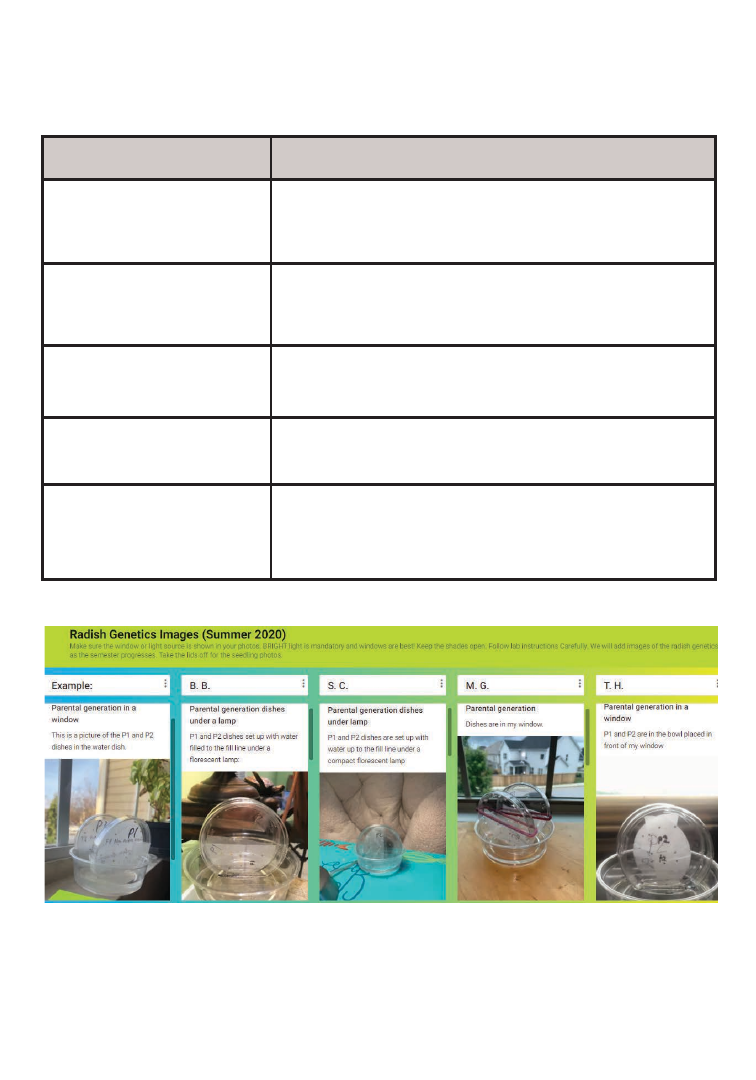
PSB 67(1) 2021
21
Figure 2. Example of Padlet online bulletin board tool used for student submissions of text,
images, and videos that are shared with classmates.
Table 2. Communication technologies employed and their primary use.
Technologies Employed
Primary Use
Blackboard (Bb) Learning
Management System
Deliver course content including announcements; admin-
ister assessments, including quizzes, journals, and assign-
ments for students to upload documents
Padlet
Students post photos, videos
, and text to share with class.
$8-per-month plan provides sufficient functionality (lim-
ited free version also available).
Flipgrid
Students post videos to share with class, thus building
community. Free plan.
Excel Online
Students share and analyze data
.
Email; Text and Phone
(Google Voice)
Individual communications

PSB 67(1) 2021
22
updates on multiweek exercises. In other cases,
we have asked students to embed images into
word-processing documents for submission,
but recent LMS updates that have simplified
uploading images make submissions into
journals more practical. We use other
technology less frequently, including FlipGrid
for ice-breaker video introductions to help
create a sense of class community and Excel
online for students to share data.
LABORATORY EXERCISES
Assignments may be divided into those that
involve growing plants, interacting with
plants outdoors, lab-kit-based activities, and
online activities (Table 1). We include three
activities where students cultivate plants
over an extended period: (1) bryophyte and
lycophyte terraria, (2) fern spores for lifecycle
observations, and (3) Coleus plants used to
make cuttings and a graft. For the Coleus
exercises, students are given two plants with
different leaf colors. They are responsible for
watering and providing adequate sunlight
or artificial light to maintain the plants. For
the grafting exercise, adapted from Readel
(2000), students graft a scion from one plant
onto the other, creating a multi-colored
Coleus (Figure 4). For the cutting exercise,
students place the leftover stem from the
grafting exercise in a cup of water to observe
adventitious root growth. In the fern lifecycle
activity, students are provided a Petri dish
pre-inoculated with spores, and they observe
growth of gametophytes and sporophytes,
with supplemental images and videos also
provided. Students ultimately transplant ferns
into soil. For the terrarium project, students
assemble replicate terrariums in disposable
plastic bowls with inverted-bowl lids.
Students transplant a moss, liverwort, and
spikemoss into each and put them into two
light environments. The paired terraria allow
comparison of how light levels affect growth
and provide redundancy (Figure 5).
Figure 3. Example of flower dissection performed by student.
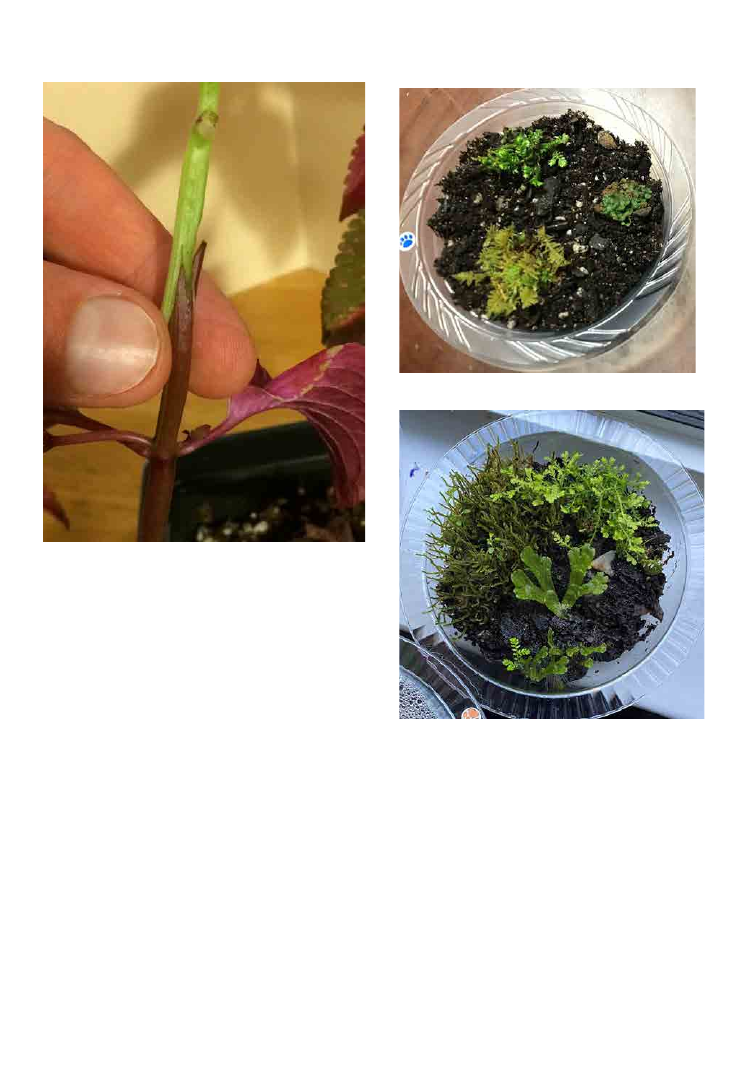
PSB 67(1) 2021
23
Figure 4. Example of Coleus grafting.
Figure 5. Photographs of terrariums grown
by students at start of semester (top) and
end of semester (bottom).
Outdoor exercises emphasize identification or
keying skills. The Leaf Morphology Laboratory
gives students hands-on experience with
botanical terminology necessary for
subsequent laboratories. Students find and
photograph a specified number of examples of
leaf complexities, basic leaf shapes, margins,
tips, and bases from outdoor plants they select.
Students add their photos to an LMS journal
and specify the relevant trait. Teaching use
of dichotomous keys is a challenge without
immediate feedback to keep students on
track. We avoid this problem by embedding
couplets into the test feature of the LMS, each
specimen with its own test and questions
introduced sequentially. Each question starts
with the correct answer to the previous
couplet and then asks students to choose
between the next two couplet choices. This
way, students always proceed to the correct
couplet. We introduce dichotomous keys
with a simple gymnosperm key and images of
several easily keyed specimen. We also require
students to find one gymnosperm, preferably
a pine, in a natural area to photograph and
identify. Students submit photographs, their
list couplet choices, and their identification.

PSB 67(1) 2021
24
In a subsequent exercise, students use a
dichotomous key to identify native trees.
They also learn how to use the iNaturalist
app for tree identification and compare the
accuracy of these two methods. Students
choose a natural area in which to photograph
and key out dicot trees using a dichotomous
key provided. Submissions include photos of
each tree identified and all choices they made
from the dichotomous key to arrive at their
identification. Students also upload photos
of the trees they have identified to iNaturalist
for identification. Finally, they check their
identifications against images on a flora
website. During the spring semester, when it
is impractical to use leaves to key deciduous
trees, we substitute a keying exercise using
winter twigs, with twigs from several species
included in the supply kit and keying based on
Stucky (2003).
Students investigate Mendelian genetics
by studying inheritance of hypocotyl
anthocyanin production in radish using kits
acquired from Carolina Biological Supply
Company. Each student is allotted four half
seed discs, each of which contains seeds from
one parental variety, or the F1 or F2 generations.
Over consecutive weeks, students germinate
each generation, photograph seedlings, score
phenotypes, and record results on a shared
Excel spreadsheet. Students make Punnett
squares to analyze patterns of inheritance.
Students practice hypothesis testing and
reinforce knowledge of macromolecules in
two exercises. First, they make a hypothesis
related to the amount of DNA in diploid rice
germ and hexaploid wheat germ, and they
test their hypothesis by extracting DNA from
both and qualitatively comparing outcomes.
Second, students make hypotheses and
predictions about the amount of starch in
onions versus potatoes and underripe versus
ripe bananas. They test these hypotheses
qualitatively by performing the iodine test for
starch.
Three online activities investigate relationships
between climate and plants. The Tree Rings/
Dendrochronology Laboratory reinforces
knowledge about how climate affects the
thickness of tree rings. Additionally, a pine tree
slice (cross section) is provided for students
to determine its age at harvest. Students also
visit the UCAR Center for Science Education
website (https://scied.ucar.edu) to read about
dendrochronology and play interactive games
that demonstrate how moisture, temperature,
and the interaction of these factors affect the
size of tree rings.
Another activity uses the Data Visualization
Tool provided by the USA National
Phenology Network (usanpn.org/usa-
national-phenology-network) for students to
create phenology curves, with each student
investigating a different species. Students then
test hypotheses about the relationship between
leaf emergence and two variables: temperature
and latitude. Finally, students predict how
climate change will affect the timing of spring
phenological events. In a third exercise, the
Cooling Benefits of Trees, students investigate
effects of trees on their home environment,
carbon sequestration, and other ecosystem
services. Students identify trees around their
residence, measure their girth, and estimate
the trees’ environmental and financial benefits
using i-Tree Design (https://design.itreetools.
org/) by using a map they construct on the
program’s interface. Also, they consider how
adding another tree could increase energy
savings.

PSB 67(1) 2021
25
Finally, students also assess the role of plants
in their diet by keeping a food journal for
one day and using the USDA website (www.
myplate.gov) to calculate how much fruit,
vegetables, grains, protein, and dairy they
consumed. The website also generates a
personalized dietary plan (MyPlate Plan)
for their daily requirements for each food
category. Students then compare their actual
diet to the recommendations and typically
find they are not eating enough plant foods.
A Community Plant Activity was recently
designed for students to volunteer at a
local garden, park, or nature center on a
plant-based project and to reflect about the
experience in a journal. An alternative online
citizen-science option was to contribute to
one of the plant biology projects at Zooinverse
(www.zooinverse.org) by digitizing hand-
written botanical specimens. Considering
the pandemic, this became the only option.
Students reflected on this experience
afterwards in a video journal. Students
reported that they found the experience of
contributing to the scientific knowledge base
especially rewarding while self-quarantining.
LESSONS
AND CHALLENGES
Lessons we have learned while teaching this
course include the following:
1. It is important to explicitly teach stu-
dents technological skills and provide an
orientation at the outset (Biel and Brame,
2016; Garman, 2012). Most Week 1 ac-
tivities are practice exercises taking pho-
tographs of plants and uploading them
to Padlet and journals in the LMS.
2. Lab kits should not be distributed
until after add–drop to avoid loss.
3. Shipping kits with live plants adds
expense and logistical challenges, so
requiring students near campus to pick
up supplies saves effort. Additionally,
instructors should have a plan for how
to accommodate students from foreign
countries or regions where live plants
cannot be shipped due to phytosani-
tary restrictions—or if accommoda-
tions cannot be made, how to prevent
students from these locations from en-
rolling.
4. Our lab activities are low risk, but
safety training should be included in
the first week and subsequent exercises
when relevant. Successful completion
of a poison-ivy–identification quiz is
required to adaptively release instruc-
tions for the first outdoor exercise.
5. Some outdoor exercises call for
students to visit natural areas. This re-
quirement could feel more challeng-
ing and pose greater risks for some
students. In practice we do not penal-
ize students who select planted speci-
men, and students have not yet raised
this issue with instructors or on course
evaluations.
6. To keep students on track with the
asynchronous modality, it is important
during complex exercises that instruc-
tors create opportunities for students
to assess their understanding (Biel and
Brame, 2016) and self-correct. Strat-
egies can include computer-graded
quizzes; adaptive release of parts of
assignments with each part beginning
with a summary of the previous part;
or multiweek assignments, with the

PSB 67(1) 2021
26
instructor providing feedback in the
interim.
7. It is important to create a welcom-
ing atmosphere and include synchro-
nous and asynchronous communica-
tion options with fast response times.
Proactive communication to non-par-
ticipatory students is beneficial.
8. Instructors should create an inclu-
sive learning environment by accom-
modating disabilities, the schedules of
non-traditional students, and dispari-
ties in access to technology, techno-
logical proficiency, and internet access
(Harris et al., 2020).
There are geographic and class-size
limitations to the course structure described
here. Geographic limitations arise in part
from shipping challenges and because
identification keys are geographically limited.
Consequently, it is helpful if most students
enrolled live within the region. The class-size
limitation arises because the asynchronous
structure leads to more time devoted to
one-on-one communication with students
than in a face-to-face laboratory. This time
commitment may be reduced by providing
clear instructions, thereby reducing need
to answer questions, with use of teaching
assistants, or by developing peer-guidance
mechanisms.
Although this online botany lab was developed
for non-majors with student success in mind,
the course is rigorous. Students get a variety
of hands-on plant experiences designed
to introduce them to botany, the scientific
method, and the beneficial roles of plants
in our lives and on Earth. By providing the
lab kit, good communication practices, and
interesting, well-planned activities, students
are primed for engagement and success.
LITERATURE CITED
Biel, R., and C. Brame. 2016. Traditional
versus online biology courses: Connecting
course design and student learning in an on-
line setting. Journal of Microbiology and Bi-
ology Education 17: 417-422.
Botanical Society of America. 1995. Botany
for the next millennium: a report from the Bo-
tanical Society of America. Columbus, OH, USA.
Brinson, J. 2015. Learning outcome achieve-
ment in non-traditional (virtual and remote)
versus traditional (hands-on) laboratories: A
review of the empirical research. Computers
& Education 87: 218-237.
Chirikov, I., T. Semenova, N. Maloshonok,
E. Bettinger, and R. F. Kizilcec. 2020. Online
education platforms scale college STEM in-
struction with equivalent learning outcomes
at lower cost. Science Advances 6: eaay5324.
Dede, C., and E. Grimson. 2013. New Tech-
nology-Based Models for Postsecondary
Learning: Conceptual Frameworks and Re-
search Agendas. Report of a National Science
Foundation-Sponsored Computing Research
Association Workshop held at MIT on Janu-
ary 9-11, 2013. Website: http://archive2.cra.
org/uploads/documents/resources/rissues/
Postseconday_Learning_NSF-CRA_report.pdf.
Faulconer, E. K., and A. B. Gruss. 2018. A
review to weigh the pros and cons of online,
remote, and distance science laboratory expe-
riences. International Review of Research in
Open and Distributed Learning 19(2): 155–
168.
Acknowledgments
We thank the University of South Carolina Upstate
Office of Distance Education for providing a stipend
for course development, students and Botany
conference workshop participants for suggestions for
course improvement, and reviewers for constructive
comments.

PSB 67(1) 2021
27
Garman, D. E. 2012. Student success in face-
to-face and online sections of biology courses at
a community college in east Tennessee (Doctor-
al dissertation). Website: http://dc.etsu.edu/
etd/1408/.
Harris, B. N., P. C. McCarthy, A. M. Wright,
H. Schutz, K. S. Boersma, S. L. Shepherd, L.
A. Manning, et al. 2020. From panic to peda-
gogy: Using online active learning to promote
inclusive instruction in ecology and evolu-
tionary biology courses and beyond. Ecology
and Evolution 10: 12581–12612.
Jaggars, S. S., N. Edgecombe, and G. W. Sta-
cey. 2013. Creating an effective online instruc-
tor presence. Columbia University: Community
College Research Center. Website: https://files.
eric.ed.gov/fulltext/ED542146.pdf.
Jaggers, S. S., and D. Xu. 2016. How do on-
line course design features influence student
performance? Computers & Education 95:
270–284.
Parsely, K. M. 2020. Plant awareness dis-
parity: A case for renaming plant blindness.
Plants, People, Planet 2: 598–601.
Pontes, M., C. Hasit, N. Pontes, P. Lewis, and
K. Siefring. 2010. Variables related to un-
dergraduate students preference for distance
education classes. Online Journal of Distance
Learning Administration 13(2): 8.
Readel, K. 2000. Grafting Coleus plants. In:
S. J. Karcher (Editor): Tested studies for labo-
ratory teaching, Volume 21, pp. 474-477. Pro-
ceedings of the 21st, Workshop/Conference
of the Association for Biology Laboratory
Education (ABLE), 509 pp.
Seamen, J. E., I. E. Allen, and J. Seaman.
2018. Grade increase: Tracking distance edu-
cation in the United States. Report by Babson
Survey Research Group. Website: http://www.
onlinelearningsurvey.com/highered.html.
Shea, P., and T. Bidjerano. 2014. Does online
learning impede degree completion? A na-
tional study of community college students.
Computers & Education 75: 103e111.
Sit, S. M., and M. R. Brudzinski. 2017. Cre-
ation and assessment of an active e-Learning
introductory geology course. Journal of Sci-
ence Education and Technology 26: 629–645.
Stucky, J. M. 2003. Winter twig keys to com-
mon, native, fully deciduous trees and pha-
nerophyte shrubs of the North Carolina East-
ern Peidmont. Vulpia 2: 23-42.
Sypsas, A., and D. Kalles. 2018. Virtual Labo-
ratories in Biology, Biotechnology and Chem-
istry education: A Literature Review. PCI '18:
22nd Pan-Hellenic Conference on Informat-
ics, Athens, Greece.
U.S. Department of Education, National
Center for Education Statistics. 2018. Table
311.22: Number and percentage of under-
graduate students enrolled in distance educa-
tion or online classes and degree programs, by
selected characteristics: Selected years, 2003-
04 through 2015-16. In U.S. Department of
Education, National Center for Education
Statistics (Ed.), Digest of Education Statistics
(2018 ed.). Website: https://nces.ed.gov/pro-
grams/digest/d18/tables/dt18_311.22.asp.
U.S. Department of Education, National Cen-
ter for Education Statistics. 2019. Fast Facts
– Distance Learning. Website: https://nces.
ed.gov/fastfacts/display.asp?id=80.
Wandersee, J. H., and E. E. Schussler. 1999.
Preventing plant blindness. American Biology
Teacher 61: 84-86.
Wladis, C., A. C. Hachey, and K. M. Conway.
2015a. The representation of minority, fe-
male, and non-traditional STEM majors in the
online environment at community colleges: A
nationally representative study. Community
College Review 43(1): 89e114.

PSB 67(1) 2021
28
Wladis, C., A. C. Hachey, K. Conway. 2015b. Which STEM majors enroll in online courses,
and why should we care? The impact of ethnicity, gender, and non-traditional student charac-
teristics. Computers & Education 87: 285–308.
FROM THE
PSB
ARCHIVES
60 years ago
:
Ralph E. Cleland discusses how to encourage graduate work in Botany:
“Second, I would advise them that the best way to prepare at the undergraduate level for graduate work
in science is to obtain as broad an education as possible. I would urge them to gain a rich background
in the humanities and social sciences, to emphasize especially the arts of writing and speaking, and to
acquire a good grounding in foreign language (preferably in two languages). Overemphasis on science
at the undergraduate level leads to the development of high grade mechanics. We need scholars, not
mere technicians, in the field of science. Given comparable abilities, the graduate student in botany
who has a broad education is much to be preferred to the person who has overspecialized in his chosen
field as an undergraduate at the expense of a liberal education.”
Cleland, Ralph E. 1961. “Supply and Demand in Relation to the Ph.D.” PSB 7(1): 1-2
50 years ago
William L. Stern further discusses graduate training, citing the Cleland 1961 paper.
“In reviewing some of the recent literature resulting from attempts to improve the training of botany
graduate students to teach, and while examining early issues of
Plant Science Bulletin
(e.g., Miller,
1955; Cleland, 1961), on the one hand I was struck by the inventiveness and imagination of college
teachers in devising complicated methods to train graduate students to teach, and on the other hand
by the absence, or near absence, of suggestions about who, specifically, will carry out these various
training methods.
. . .
However meritorious the several plans for teaching teaching assistants to teach, none will work well unless
the teacher-trainer is recognized and rewarded for his efforts, rather than penalized for them, as seems to
be the case in so many institutions of higher learning. This fact must be brought forcefully to the attention
of university administrators. Acceptance of this reality must progress hand-in-hand, or even better, it
must precede efforts to improve the training of graduate teaching assistants in the pedagogical process.”
Stern, William L. 1971. ”Responsibilities of Universities to Provide Trained Botanists for Undergradu-
ate Education” PSB 17(1): 2-3.
40 years ago
“Shoals Marine Laboratory; Appledore Island, Isles of Shoals, Maine is offering two courses that might
be of interest to readers: Adaptation in Marine Organisms and Field Phycology. Shoals Marine Lab-
oratory is a cooperative filed station of Cornell University and The University of New Hampshire.”
--Summer Courses PSB 27(2): 16.
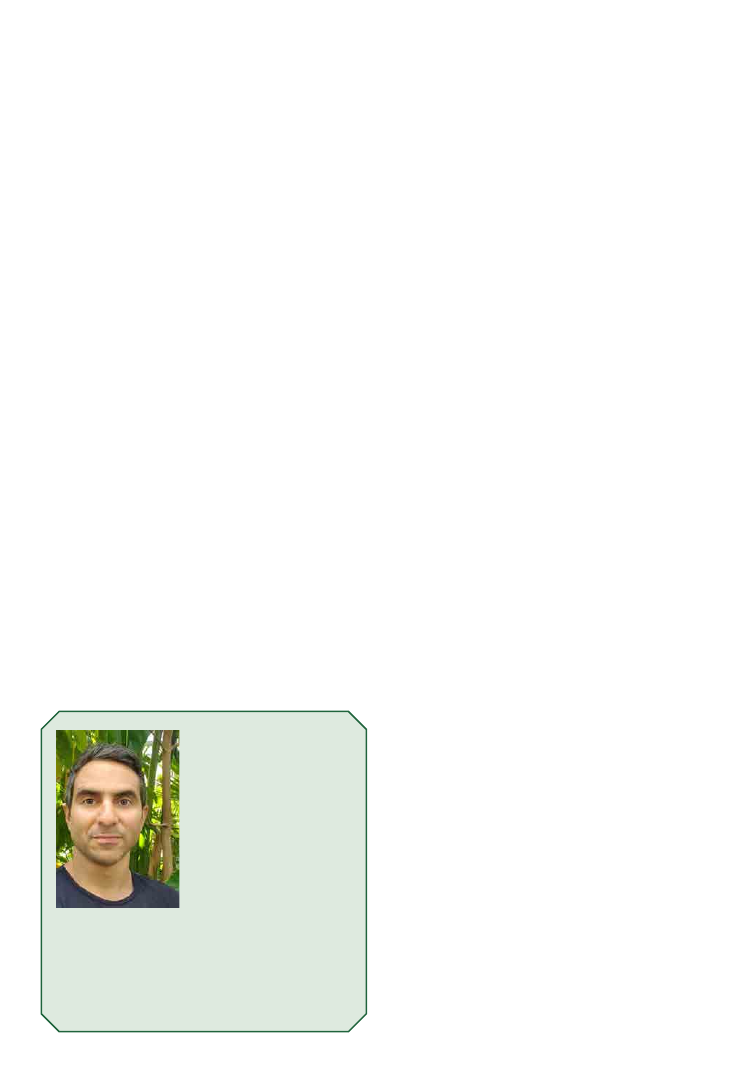
PSB 67(1) 2021
29
T
his past May and June, 2020, during the
early COVID-19 quarantines, at the height
of the virus outbreak in New York City, our
collection’s Amorphophallus titanum (aka,
Titan Arum, Corpse Plant) decided it was
going to send up its first bloom (Figures
1–4). The following is a brief recounting of
that event, along with a few observations and
lessons learned along the way.
OF ALL THE TIMES
In 2006, The Brooklyn Botanic Garden’s
(BBG’s) A. titanum specimen “Baby” sent up
the first recorded bloom in NYC in nearly 70
years. It was an event met with great public
celebration and media coverage throughout
the city, and it brought widespread fascination
Sited on the roof of one of the original academic
halls at Barnard College, The Arthur Ross Green-
house is a plant conservatory of 2,000 ft² under
glass, with dedicated space for faculty research
and student projects.
When a Titan Arum Blooms
During Quarantine
(aka, Making a Stink Online)
with the plant into public consciousness. A
number of years after the event, the garden
decided to develop a new crop of titanums.
Ours came from that crop, as an inter-
conservatory gift of goodwill. Upon arrival
at our greenhouse, it was a humble, young,
3-inch corm weighing about a pound. For
the last eight years we’ve been cultivating it,
with great affection, patience, and aspirations.
Only a lucky few ever get to see these plants
bloom in the native wilds of central Sumatra;
the rest of us botanists and plant lovers must
bring about a bloom ex situ if we’re ever to
bear witness to its singular presence. For an
institutional greenhouse, blooming events
such as these are prime opportunities to
engage a wide public audience and bring
attention to a host of relevant issues. We
hoped that we could hold our own festive on-
site event to inspire others, as the BBG event
had inspired us. We were looking forward to
the opportunity to enthrall both our campus
and the local community in the wonder of the
Titan’s bloom.
As most readers here likely already know, the
blooming of A. titanum in a conservatory
setting is no longer the uncommon event it
once was. Today, it is not as momentous an
occasion as when Kew Gardens bloomed the
first in cultivation in 1889, or when The New
York Botanical Garden bloomed their first in
1937. As seed availability and horticultural
knowledge have proliferated, mature
specimens and their inflorescences have
By Nick Gershberg
Greenhouse Manager
The Arthur Ross
Greenhouse at
Barnard College,
New York, NY

PSB 67(1) 2021
30
Figure 1. ‘Berani’ (Indonesian for “Bold”), ap-
proximately 10 to 12 years old, blooming for
the first time, May/June 2020.
Figure 2. Detail within the spathe.
Figure 3. From the ground up.
Figure 4. Overhead view.

PSB 67(1) 2021
31
become staples in conservatory. Nonetheless,
it is still a superlative event in the botanical
world, and the blooming at Barnard is still an
important and long-anticipated event for our
community.
Any team that has successfully brought an A.
titanum to bloom, or achieved a similarly rare
botanical event, understands this sentiment.
Beyond the sheer excitement of the occasion,
a corpse plant blooming is evidence that a
greenhouse is doing a solid job of providing
care 365 days of the year. Beyond being a
point of pride (clearly), it also comes with a
certain sense of relief, which may feel familiar
to growers reading along. On the long road to
a bloom, any number of things can happen
(e.g., one cold night, a few days of too much or
too little moisture, a random hapless accident)
and years of cultivation can be voided before
one has even realized it has happened. So for
many of us, being able to enjoy the tangible
product of a capable team of horticulturists is
a welcome occasion.
Each time one of these plants blooms, it’s an
opportunity for a greenhouse to put its best
foot forward and make the most of the outreach
potential of these “megaflora” events. At the
very center of any conservatory’s mission lies
the message of stewardship. While the plant
effortlessly does the work of drawing public
interest (among the beetles and flies), the story
of its lengthy cultivation inherently reinforces
the notion that stewardship takes more
than just good intentions and wholesome
aspirations. It demands hard work, dedication,
knowledge, and patience.
But nature is on its own timeline. Despite
our best intended interventions as growers, it
more often than not shows little concern for
our ends. And, famously, these titans tend to
keep a particularly unpredictable schedule. It
was only on the final day of our quarantine
preparation, just before the “stay at home”
orders were issued in New York State, that our
plant began to emerge from a long dormancy
period. As much as we’d hoped for a bloom
for so many years, we would have been
content with just another majestic leaf this
time around. So, weeks later, when there was
no doubt that our plant had begun to bloom
in the midst of the nationwide quarantine, it
was frustrating and a bit of a disappointment.
There was no way we could safely receive
visitors at our facility. Not even our student
worker staff, who had been instrumental in
plant’s the daily cultivation, was allowed on
campus at that stage.
As it happens, all was not lost. It turns out folks
are quite fond of the internet. And despite
the setback, we were intent on sharing the
bloom with as much of our community and
beyond as we possibly could. First, in a matter
of a few days, we prepared a livestream of the
plant, which was posted on YouTube (Figure
5). Often just a supplement to the in-person
experience, a live stream feed for this bloom
would be our community’s primary window
into the greenhouse. Initially, I was surprised
at how much technical knowhow was
involved in setting up the various elements
of the stream. But, largely thanks to the help
of an impromptu, remote collaboration of
our college’s IT and digital media staff, we
were soon able to broadcast 24/7. In addition,
using the greenhouse’s existing Instagram
account (@barnardgreenhouse), we staged
a public naming contest (as is the custom),
updated and informed our audience with
regular posts, and used “Instagram Live”
as an impromptu platform for interacting
directly with the public. Finally, a few days
after the inflorescence waned, we created
a beautiful time-lapse of the 48 hours of
opening and closing, which has proven a
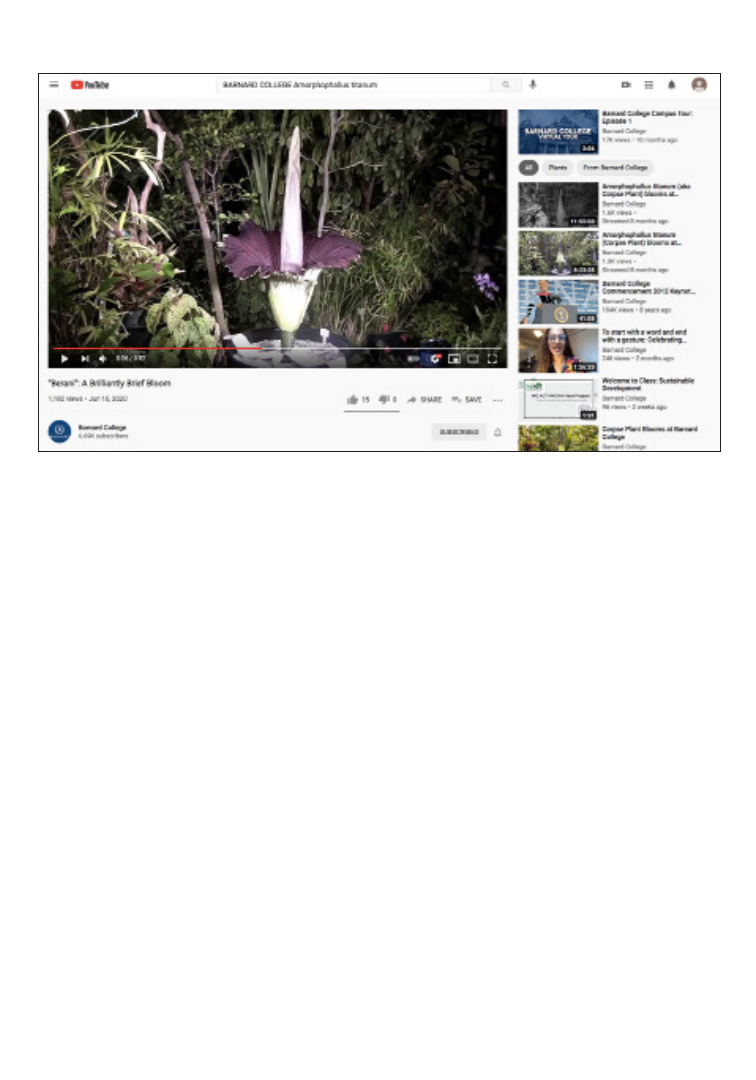
PSB 67(1) 2021
32
cherished memento. In retrospect, thanks to
the staggering connectivity of the internet, it’s
possible that we reached a much larger, more
diverse audience than if we only had an on-site
event. Without a doubt, it was an object lesson
in the potential that digital and social media
offer for science and education outreach.
MAKING THE BEST,
OF THE BEST
As a conservatory, fostering science literacy
and educational outreach is a large part of
our mission. When visitors come to the
greenhouse, it is our job to elicit the “spark”
of interest in the plants we house and to create
the momentum that will generate further
interest and desire for more knowledge. We
try our best to provide our guests with clear,
factual, thoughtfully contextualized, and
relevant information. Greenhouse curators
routinely rely on an array of charismatic plants
to facilitate conversations with visitors. It’s
important to remember that we’re speaking
to audiences with a diversity of interest.
Some of our guests are of course already very
interested in plants and are connoisseurs in
their own right. Others are less so, and some
are not initially interested at all. When young
children come to the greenhouse, after an
initial introduction, we usually begin by asking
whether they like ice cream. Even if they’re not
particularly interested in the plants, they are
definitely interested in chocolate and vanilla!
So we show them our vanilla orchid vine, and
our cacao trees. When burgeoning scientists
come, we point out the fascinating potential
for biotechnology that plants such as cacao
possess, and discuss how our particular plants
were grown from tissue culture for potential
commercial use. And if it eats insects, moves
rapidly—or both—it is sure to engage a crowd.
Figure 5. Screenshot from YouTube.

PSB 67(1) 2021
33
It’s long been known that the use of charismatic
flora and fauna is a highly effective tool
in science outreach, and it provides great
opportunities to cleverly introduce more
sophistication into the scientific vernacular.
For example, a key point we emphasized
from the start of our coverage is that what
people were witnessing was not the world’s
largest flower, but instead the world’s largest
unbranched inflorescence, or single structure
containing many dozens or hundreds of
individual flowers. Throughout the two to
three weeks of the ongoing event, we were
able to introduce many more concepts, of
greater nuance and sophistication, from topics
including tropical biogeography, systematics
and taxonomy, ethnobotany, morphology,
pollination and reproductive ecology, and
conservation biology. We were also able
to bring attention to the history of often
exploitive colonialist aspects of “discovering”
any tropical plant taxa, and to affirm the
importance of local guides and indigenous
knowledge, both historical and current.
Over the years, we’ve come to appreciate that
there are myriad cultural connections with
almost all of our taxa, making them interesting
subjects for classes in sociology, history,
literature, etc. In that sense, we’ve promoted
the greenhouse collection as a resource for
most, if not all of the other departments at
the college, on some level. Figure 6 shows
an example of one of the interdisciplinary
connections we made during the corpse plant
blooming.
IMPROVISE, ADAPT,
OVERCOME
In this digital age online media is now the
mainstream, and certainly the norm among
our student body. The Titan Arum blooming
event affirmed that as educators, we need to
embrace this online trend. Moreover, that
means not just using the preferred platforms
of our student audience, but also adapting
to the pace they set. That’s not necessarily an
easy proposition, as education and advocacy
have to keep up and maintain relevancy in
the midst of nearly constant stimulation.
We must continually strive to provide high-
quality content, in an eloquent manner,
often in a way that is interdisciplinary and
cross cultural. Given the urgency to start an
engaged awareness of the natural world early,
it is our goal to reach as wide an audience as
possible. By establishing these connections
using modern platforms, we can fulfill this job
of raising awareness, encouraging scholarship,
fostering a committed sense of stewardship,
and promoting informed action. Hopefully,
if we can connect on common ground with
broad appeal, we will help create a truly open
and robust entry point for the STEM pipeline,
available to the widest possible range of
individuals.
There were some hurdles to clear in creating
our online event. The main lesson we learned
is that it’s of vital importance to have a
working familiarity with the setup and gear
involved, and to practice to gain proficiency.
To my surprise, no one person or department
on our campus was familiar with the soup-
to-nuts process of setting up a live stream
for public viewing. I had to enlist the help
of about a dozen individuals, across several
departments, to make it work—and under
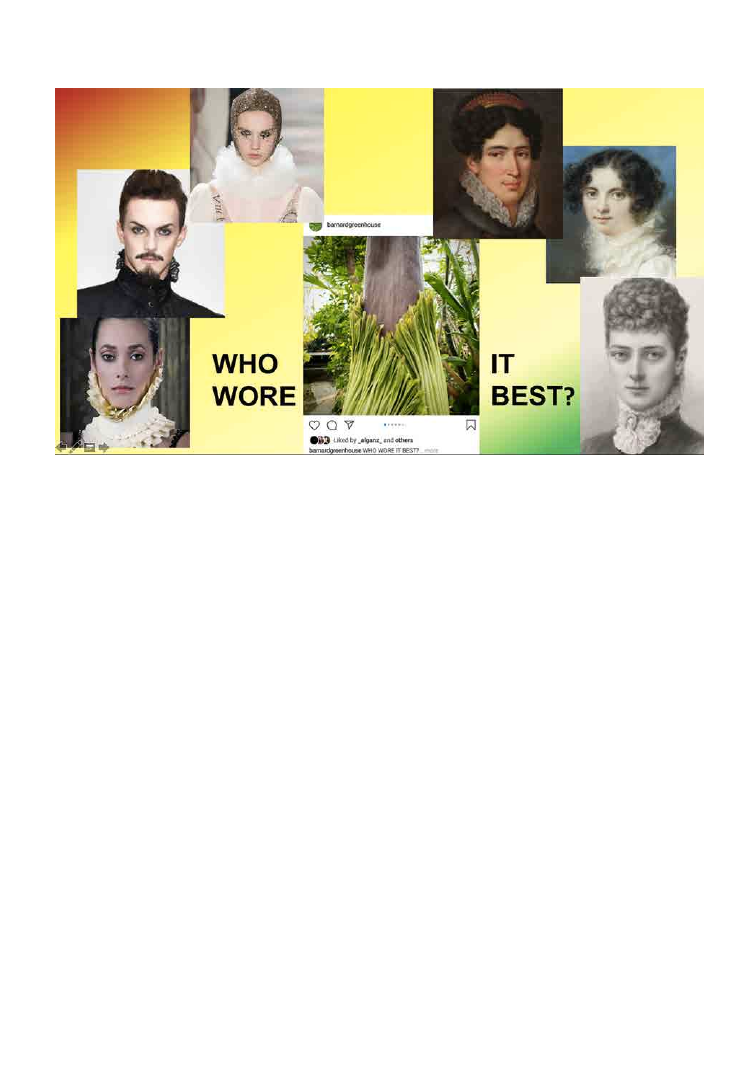
PSB 67(1) 2021
34
quite unusual circumstances since almost
nobody was actually on campus. It may have
seemed like a fairly basic operation, given the
ubiquity of live streaming lately, but in actual
fact, it was seldom needed, so the process
took some effort to bring to bear. It’s advisable
to build these skills and interdepartmental
relationships early, so that all of the
components are effectively ready to go.
Fortunately, the fact that we had already
cultivated a social media follower base meant
that, when we had exciting, ephemeral
content, there was someone to share it with.
While we did of course use the college’s
existing traditional media outlets, they were
somewhat static by comparison and lacked the
innately interactive quality of social media.
Just as with the live stream hardware setup,
though, online platforms take time to develop
well. As a relative social media novice myself,
learning to craft content that’s at the standard
of our in-person visitor experience, and that
has a comparable “voice,” has taken time. A
big thanks goes to a number of our greenhouse
student worker staff, who put time in over the
course of the last few years to help cultivate an
engaging and worthwhile platform. Creating
more immersive informational hubs like
websites can be extremely time-consuming
as well and are subject to a host of technical
issues. Our own site has been a long work
in progress and is a high priority as the
management and purposeful utilization of
data continues to pave new paths in science.
So it makes sense to view not only developing
content, but also the means to disseminate it,
as an ongoing process.
In the last year, this concept of a hybrid model
for outreach and institutional engagement
has, by sheer necessity, taken a huge leap
forward. If anything, though, the process has
just been accelerated by circumstance, as there
has long been a need to close the gap between
“real world” and online scholarly resources.
Figure 6. Interdisciplinary connections: “Who wore it best?”

PSB 67(1) 2021
35
In cultivating on-site and online content
synergistically, ideally, each one serves as a
follow-up resource for the other. Whether
you’re a small institutional greenhouse with
a modest collection like ours at Barnard
College, or a large, world-class institution,
there exists great potential to enhance the user
experienceand provide access to more diverse
audiences, with nearly instant pathways for
cultivating meaningful content.
LOOKING BACK
I’d like to take a moment to acknowledge
that, in addition to happening during the
quarantine lockdowns, this bloom event
converged with a time of unprecedented social
upheaval. The nation, and the entire Barnard
community, were outraged and heartbroken
over the murder of George Floyd, Jr. and
were activated in the ubiquitous decrying of
systemic violence against Black Americans. As
the protests and national dialogue emerged as
the events of true importance at that moment,
how we proceeded was intently focused on not
overshadowing them. Furthermore, our own
community was already in a state of coping
with the recent devastating death of a student.
So we must remember that whenever these
celebrated events occur, they occur necessarily
in the human context of everything else going
on at the time. We hope, at the very least, that
our event was uplifting in some small way, in
the face of these truly serious, important, and
deeply personal matters.
Now that our plant has returned to dormancy,
we hope that the traditionally mounted
pressing of the full inflorescence we have
successfully made will be a tangible memento
that students can marvel at in person upon
their return. But we look forward to pursuing
our outreach role online as well, as best we can,
with all the latest tools at our disposal. Looking
back at 2020, a year of highs and lows, I’m
ever more grateful our plant provided us an
opportunity to focus on something positive,
that brought our community together for a
short while in mutual admiration. If the study
of plants teaches us anything, it is that nature
persists and finds ways to adapt even in the
most unlikely of environments. Hopefully we
can continue to reflect this lesson, into 2021
and beyond.

36
SCIENCE EDUCATION
By Dr. Catrina Adams,
Education Director
Dr. Jodi Creasap Gee,
Education Technology
Manager
With the addition of a new, pandemic-
friendly module—the Tree-Mendous
Benefits of Trees (https://plantingscience.
org/benefitsoftrees)—and the continued
popularity of the Wonder of Seeds module, we
have a large spring session with 28 groups! The
participating schools range from in-person to
hybrid to remote learning schedules, and we
are thrilled and grateful to these teachers for
bringing their students to the platform. We
are also seeing new mentors signing up and
quickly being assigned to teams. Students and
mentors were busy introducing themselves
and coming up with research projects.
Spring 2021 PlantingScience
Session Summary
MENTORS URGENTLY
NEEDED FOR NEW
TREE-MENDOUS BENE-
FITS OF TREES MODULE
Seven of the 28 PlantingScience groups are
using the new module, thus creating an urgent
rush in demand for mentors who are willing
to mentor for this module. The 32 mentors
who have updated their profiles are swamped!
If you or someone you know might like to
mentor middle- and high-school students as
they work through this fun module, please
update your profile at https://plantingscience.
org/login or register to be a mentor on
PlantingScience at https://plantingscience.
org/register now!
TEACHING REMOTELY
WITH PLANTINGSCIENCE
Between the fall and spring sessions, we
surveyed PlantingScience teachers and
developed a new resource: Remote Learning
Tips (https://plantingscience.org/psteachers/
remotelearningtips). This resource can help
teachers determine which module might
work best and how to make it work in their
classes, be they remote, hybrid, or in-person.
We hope it provides useful guidance for all of
our teachers.
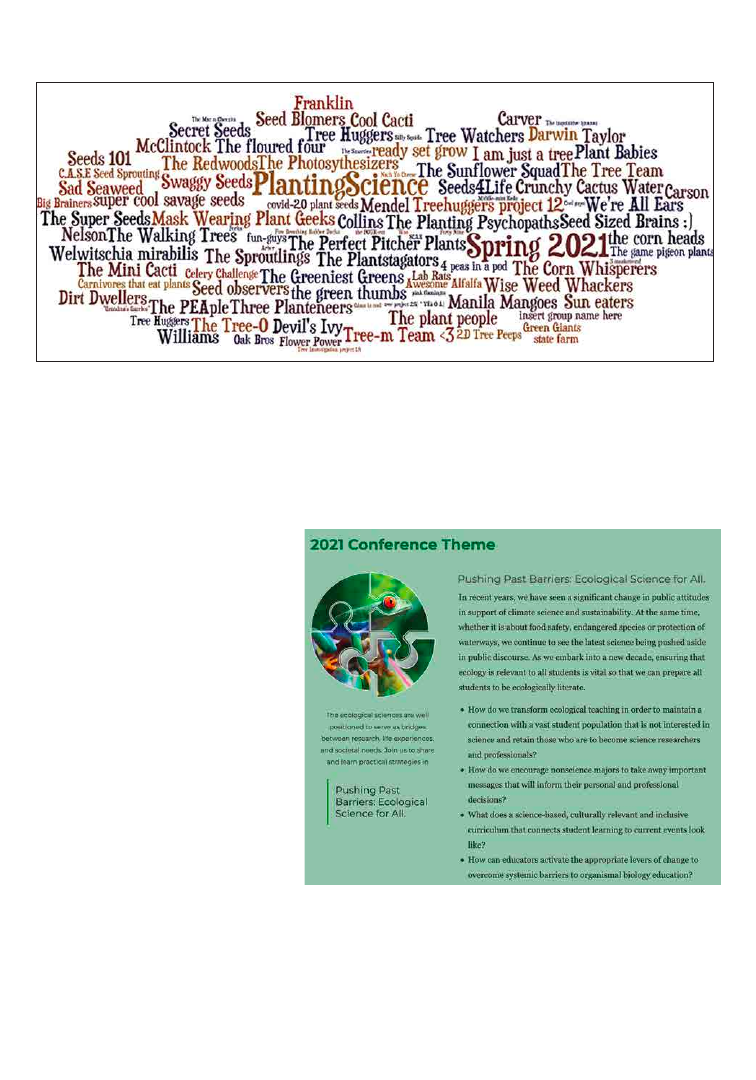
PSB 67(1) 2021
37
THE 7TH LIFE
DISCOVERY
CONFERENCE
The 7th Life Discovery: Doing
Science Conference will be held
next October in Estes Park, CO,
from Sept 30-Oct 2, 2021 (public
health conditions permitting). The
theme is “Pushing Past Barriers:
Ecological Science for All.” We are
still seeking education share fair
proposals if you are interested in
presenting ideas in development.
We would love to have a larger
BSA presence at the conference.
This small (approximately 150
attendees) conference includes
many opportunities to discuss
important topics in biology
education and network with others
passionate about teaching. Check
out the conference website for more
information: http://www.esa.org/ldc.
Student team names have been especially creative for the PlantingScience Spring 2021 Session.
Can you pick a favorite?
Please join us at the 7
th
Life Discovery: Doing Science
Biology Education Conference

PSB 67 (1) 2021
38
NEW PLANTS ARE COOL TOO!
EPISODE NOW AVAILABLE
Check out the latest episode of Plants are Cool, Too!, and please help amplify the reach of this
botany outreach resource by sharing with your colleagues and students: https://www.youtube.
com/watch?v=Y1zNfODhM4o.
“Highlighting one of the coolest and most ambitious projects in the history of rare species
conservation, this episode (“Team Schiedea”) takes us to Kaua’i, Hawai’i, where a group of
passionate plant people are working to save some of the rarest plants on the archipelago—and
tell us why we need a new generation of biodiversity lovers to help battle the extinction crisis.”

39
STUDENT SECTION
By Shelly Gaynor and Imeña Valdes
BSA Student Representatives
Roundup of Student Opportunities
It’s that time of the semester where you start to compile every opportunity you want to apply
to into one list. To make this easier for you, we have compiled a list of all the opportunities we
know about. Even if the deadline of this application cycle has passed for this academic year,
make sure to check by the end of this year for the next application cycle.
Below, we have
divided
these into
categories for easy browsing that include the following: BSA Grants and Awards,
Fellowsh
ip, Research Awards,
Broader Impacts, Short Courses and Workshops, Job Hunting
,
and ways that may help you to travel to Botany 2021. At the end of the student section, we
included recommended reading for future leaders.
Of course, all the grants and awards information will also be announced and reminded via
the BSA social media, so make sure to follow us on Facebook (Botanical Society of America),
Twitter (
;@Botanical_
), and Instagram (
;@botanicalsocietyofamerica
) and stay updated! Also
feel free to reach out to your BSA student representatives, Shelly (michellegaynor@ufl.edu)
and Imeña (imenavaldes2020@u.northwestern.edu), if you have questions about the listed
opportunities, or any questions or comments about BSA.

PSB 67(1) 2021
40
BSA GRANTS AND AWARDS
Here we list a number of grants and awards offered by BSA this year, and make sure to pay
attention to the deadlines. All the BSA awards are open to its members, and students of any
career stage and any nationality are encouraged to apply.
Donald R. Kaplan Award in Comparative Morphology
Amount: $10,000
Deadline: March 15th
Purpose: Research Funds
More info: https://botany.org/home/awards/awards-for-students/kaplancomparativemorhpology.html
BSA Graduate Student Research Awards & the J. S. Karling Award
Amount: $1,500
Deadline: March 15th
Purpose: Research Funds
More info: https://botany.org/home/awards/awards-for-students/
BSA Graduate Student Research Awards Given by Sections
Amount: $500
Deadline: Mid.-March
Purpose: Research Funds
More info: https://botany.org/home/awards/awards-for-students/
BSA Undergraduate Student Research Awards
Amount: $200
Deadline: Mid.-March
Purpose: Research Funds
More info: https://botany.org/home/awards/awards-for-students/
BSA Young Botanist Award
Amount: NA
Deadline: Mid-March
Purpose: Recognition
More info: https://botany.org/home/awards/awards-for-students/bsayoungbotanistawards.html
American Association of University Women (AAUW) Dissertation Fellowship
Amount: $20,000
Deadline: Nov. 1st
Nationality/Affiliation requirement: Must be a female U.S. citizen, national, or permanent resident
Purpose: Dissertation Fellowships offset a scholar’s living expenses while she completes her dissertation.
The fellowship must be used for the final year of writing the dissertation. Applicants must have completed all
course work, passed all preliminary examinations, and received approval for their research proposals or plans
by the preceding November.
More info: https://www.aauw.org/what-we-do/educational-funding-and-awards/american-fellowships/
FELLOWSHIPS
Fellowships fund you during your graduate or postdoctoral work. Here we summarize some of
the available fellowships that could be applicable to your graduate or postdoctoral work.

PSB 67(1) 2021
41
American Association of University Women (AAUW) International Fellowship
Amount: $18,000 - $30,000
Deadline: Nov. 15th
Nationality/Affiliation requirement: Have citizenship in a country other than the U.S. or possession of a
nonimmigrant visa if residing in the U.S.
Purpose: International Fellowships are awarded for full-time study or research in the United States to women
who are not U.S. citizens or permanent residents. Both graduate and postgraduate studies at accredited U.S.
institutions are supported.
More info: www.aauw.org/what-we-do/educational-funding-and-awards/international-fellowships/if-application/
Research Fellowships/Awards from the Arnold Arboretum
Amount: Up to $10,000
Deadline: Feb. 1st
Nationality/Affiliation requirement: Fellowships differ in requirements.
Purpose: Multiple awards and/or fellowships are offered for undergraduate and graduate students with topics
that focus on Asian tropical forest biology and comparative biology of woody plants.
More info: www.arboretum.harvard.edu/research/fellowships/
Banting Postdoctoral Fellowships
Amount: $70,000 per year
Deadline: Unknown for 2021
Nationality/Affiliation requirement: Open to Canadian citizens and permanent residents of Canada.
Purpose: To promote research in Canada and Canadian scholars abroad.
More info: https://banting.fellowships-bourses.gc.ca/en/home-accueil.html
Burroughs Wellcome Fund: Career Awards at the Scientific Interface
Amount: $500,000 over five years
Deadline: Jan. 8th
Nationality/Affiliation requirement: Open to U.S. and Canadian citizens, permanent residents, and tempo-
rary residents.
Purpose: To bridge advanced postdoctoral training and the first three years of faculty service. Research bridg-
ing computational and biological approaches; PhD typically in chem, physics, math, etc.
More info: https://www.bwfund.org/grant-programs/interfaces-science/career-awards-scientific-interface
CIC Smithsonian Institution Fellowship
Amount: $40,000 for one year
Deadline: Unknown for 2021
Nationality/Affiliation requirement: Only students currently enrolled in one of the Big Ten Academic Alli-
ance member universities are eligible.
Purpose: To support research in residence at Smithsonian Institution facilities. All fields of study that are
actively pursued by the museums and research organizations of the Smithsonian Institution are eligible.
More info: http://www.btaa.org/resources-for/students/smithsonian-fellowship

PSB 67(1) 2021
42
Ford Foundation Fellowship Programs
Amount: $27,000 - $50,000 for 1-3 years
Deadline: Dec. 2021
Nationality/Affiliation requirement: All U.S. citizens, U.S. nationals, and U.S. permanent residents (holders of
a Permanent Resident Card), as well as individuals granted deferred action status under the DACA Program.
Purpose: Three fellowship types are offered: Predoctoral, Dissertation, and Postdoctoral. The Ford Founda-
tion seeks to increase the diversity of the nation’s college and university faculties.
More info: http://sites.nationalacademies.org/pga/fordfellowships/index.htm
Fulbright U.S. Student Program
Amount: Variable
Deadline: Spring 2021
Nationality/Affiliation requirement: Must be citizens or nationals of the U.S. at the time of application;
permanent residents are not eligible.
Purpose: Covers transportation and living expenses in the host country. Tuition and school-related fees cov-
ered in some countries.
More info: http://us.fulbrightonline.org/about/types-of-awards/study-research
National Science Foundation Graduate Research Fellowship Program (NSF GRFP)
Amount: $34,000 per year + tuition aid
Deadline: October.
Nationality/Affiliation requirement: Must be a U.S. citizen, national, or permanent resident.
Purpose: Support outstanding graduate students in NSF-supported disciplines who are pursuing research-
based Master’s and doctoral degrees at accredited U.S. institutions.
More info: https://www.nsfgrfp.org/
National Science Foundation: Earth Sciences Postdoctoral Fellowships
Amount: Varies
Deadline: September 8th.
Nationality/Affiliation requirement: Must be a U.S. citizen, national, or permanent resident.
Purpose: Earth science research including geobiology and paleobiology; current theme: “issues relating to
scale”.
More info: https://www.nsf.gov/funding/pgm_summ.jsp?pims_id=503144&org=NSF
Postdoctoral Research Fellowships in Biology (PRFB)
Amount: Varies
Deadline: Varies
Nationality/Affiliation requirement: All U.S. citizens, U.S. nationals, and U.S. permanent residents.
Purpose: The Directorate for Biological Sciences (BIO) awards Postdoctoral Research Fellowships in Biology
(PRFB) to recent recipients of the doctoral degree for research and training in selected areas supported by BIO
and with special goals for human resource development in biology. The fellowships encourage independence
at an early stage of the research career to permit Fellows to pursue their research and training goals in the
most appropriate research locations regardless of the availability of funding for the Fellows at that site.
More info: https://www.jsps.go.jp/english/e-fellow/index.html

PSB 67(1) 2021
43
Schlumberger Foundation Faculty for the Future Fellowship
Amount: Up to $50,000 per year
Deadline: Unknown for 2021
Nationality/Affiliation requirement: Applicant has to be a woman from developing/emerging economies.
Purpose: The program’s long-term goal is to generate conditions that result in more women pursuing scien-
tific careers by lowering the barriers women face when entering STEM disciplines, thus reducing the gender
gap. Faculty for the Future Fellows are expected to return to their home countries after completion of their
studies to contribute to economic, social, and technological advancement by strengthening the STEM teaching
and research faculties of their home institutions.
More info: https://www.facultyforthefuture.net/content/about-faculty-future-program
American Society of Plant Taxonomists Graduate Student Grants
Amount: Up to $1,500
Deadline: March 1st
Nationality/Affiliation requirement: Must be a member of the society.
Purpose: To fund Masters and doctoral students to conduct fieldwork, herbarium studies, and/or laboratory
research in any area of plant systematics.
More info: https://www.aspt.net/awards#.X_yT-5NKhsY
Awards from New England Botanical Club
Amount: Up to $3,000
Deadline: February 1st
Nationality/Affiliation requirement: None.
Purpose: To encourage botanical research in the New England region.
More info: http://www.rhodora.org/awards/graduate.html
Company of Biologists: Travelling Fellowships
Amount: Up to £2,500
Deadline: March, May, Aug., Oct., of each year
Nationality/Affiliation requirement: Award cannot be paid to those in areas that have sanctions, embargoes,
or other political trade restrictions put in place by the United Nations, the EU, or the UK.
Purpose: Lab visits to work with collaborators; research theme must be covered by Company of Biologists
journals.
More info: https://www.biologists.com/travelling-fellowships/
RESEARCH AWARDS
In addition to those we list here, check out local societies (e.g., Florida Native Plant Society,
Southern Appalachian Plant Society, Washington Native Plant Society Grant, Montana Native
Plant Society Grant, Nevada Native Plant Society Margaret Williams Research Grant, Colorado
Native Plant Society John W. Marr Research Grant, Arctic Institute of NA Grants-in-Aid
Program, etc.).

PSB 67(1) 2021
44
Evolutionary, Ecological, or Conservation Genomics (EECG) Research Award
Amount: Up to $6,000
Deadline: Unknown for 2021
Nationality/Affiliation requirement: Must be a member of the society.
Purpose: Priority for funding will be given to proposals that address genome-scale questions, or ecologi-
cal, evolutionary, and conservation genetics questions that are best addressed using genomic approaches in a
hypothesis-testing framework.
More info: https://www.theaga.org/eecg-awards.php
Garden Club of America Scholarship
Amount: $1,000 - $8,000
Deadline: Dec. 1st, 31st; Jan. 15th, 31st; Feb. 1st,
2nd, 5th; Jul. 1st
Nationality/Affiliation requirement: U.S. citizens and permanent residents who are enrolled in a U.S.-based
institution.
Purpose: To encourage research focused on systematics; projects of a more general or educational nature will
also be considered, provided that they include a strong systematics component. Offers a total of 28 merit-
based scholarships and fellowships in 12 areas related to conservation, ecology, horticulture, and pollinator
research.
More info: www.gcamerica.org/scholarships
Grants from the Wetland Foundation
Amount: Up to $1,600
Deadline: Dec. 18th
Nationality/Affiliation requirement: Any student currently enrolled full-time at an academic institution in the U.S.
Purpose: To support wetland education and research.
More info: http://thewetlandfoundation.org/grants/
Herb Society of America Research Grant
Amount: $5,000
Deadline: Mar. 31st
Nationality/Affiliation requirement: Only U.S. residents may apply.
Purpose: This grant is for the research of the horticultural, scientific, and/or social use of herbs throughout
history.
More info: https://www.herbsociety.org/explore/grants-scholarships/grant-details.html
International Association for Plant Taxonomy Research Grant
Amount: Up to $2,000
Deadline: Feb. 28th
Nationality/Affiliation requirement: None.
Purpose: To fund students and young investigators preferably for travel to institutions, laboratory investiga-
tions, or fieldwork.
More info: https://www.iaptglobal.org/grants

PSB 67(1) 2021
45
Lewis and Clark Fund for Exploration
Amount: Up to $5,000
Deadline: Nov.
Nationality/Affiliation requirement: U.S. citizens and residents wishing to carry out research anywhere in
the world. Foreign applicants must either be based at a U.S. institution or plan to carry out their work in the U.S.
Purpose: To fund field exploration in various fields.
More info: https://www.amphilsoc.org/grants/lewis-and-clark-fund-exploration-and-field-research
National Geographic Young Explorers Grants
Amount: Up to $5,000
Deadline: Unknown for 2021
Nationality/Affiliation requirement: None.
Purpose: Support research, conservation, and exploration-related projects consistent with National Geo-
graphic’s existing grant programs. In addition, this program provides increased funding opportunities for
fieldwork in 18 Northeast and Southeast Asian countries.
More info: https://www.nationalgeographic.org/grants/grant-opportunities/
P.E.O. Scholar Award
Amount: $20,000
Deadline: Between Aug. 20 and Nov. 20
Nationality/Affiliation requirement: Must be a citizen or legal permanent resident of the U.S. or Canada.
Purpose: To encourage research focused on systematics, also projects of a more general or educational nature
will also be considered, provided that they include a strong systematics component.
More info: https://www.peointernational.org/psa-eligibility-requirements
Richard Evans Schultes Research Award
Amount: Up to $2,500
Deadline: Mar. 30th
Nationality/Affiliation requirement: Must be a member of the society.
Purpose: To help defray the costs of fieldwork on a topic related to economic botany for students who are
members of the Society for Economic Botany.
More info: http://www.econbot.org/index.php?module=content&type=user&func=view&pid=50
Sigma Xi Grants-in-Aid of Research
Amount: Up to $1,000
Deadline: Mar. 15th; Oct. 1st
Nationality/Affiliation requirement: Preference will be given to members of the society.
Purpose: To encourage close working relationships between students and mentors, this program promotes
scientific excellence and achievement through hands-on learning.
More info: www.sigmaxi.org/programs/grants-in-aid

PSB 67(1) 2021
46
Society for Herbarium Curators Student Research Awards
Amount: $500 or $250
Deadline: Feb. 1st
Nationality/Affiliation requirement: Must be a member of the society.
Purpose: To provide funds for graduate or undergraduate students conducting research related to herbarium
resources.
More info: http://www.herbariumcurators.org/awards
Society for Integrative and Comparative Biology Grant-in-Aid of Research (GAIR)
Amount: Up to $1,000
Deadline: Fall 2021
Nationality/Affiliation requirement: Must be a member of the society.
Purpose: For graduate students in support of their research in the fields of integrative and comparative biology.
More info: https://sicb.burkclients.com/grants/giarinfo.php
Society for Integrative and Comparative Biology
Fellowship of Graduate Student Travel (FGST)
Amount: Up to $2,000
Deadline: Fall 2021
Nationality/Affiliation requirement: Must be a member of the society.
Purpose: For graduate students for travel and other expenses at distant research laboratories, museums, or
field sites.
More info: https://sicb.burkclients.com/grants/fgstinfo.php
Society for the Study of Evolution Grants
Amount: $2,500 - $3,500
Deadline: Varies
Nationality/Affiliation requirement: Must be a member of the society.
Purpose: This society has a range of grants that service students pursuing evolutionary research.
More info: http://www.evolutionsociety.org/content/society-awards-and-prizes/graduate-research-excellence-
grants.html
Society of Systematic Biologist Graduate Student Research Award
Amount: $1,000 - $3,000
Deadline: Fall 2021
Nationality/Affiliation requirement: Must be a member of the society.
Purpose: To assist graduate students conducting research in systematics.
More info: https://www.systbio.org/graduate-student-research-awards.html

PSB 67(1) 2021
47
The Councils of the Linnaean Society and the Systematics Association:
Systematics Research Fund
Amount: £500 - £1,500
Deadline: Feb. 15th
Nationality/Affiliation requirement: None.
Purpose: To encourage research focused on systematics; projects of a more general or educational nature will
also be considered, provided that they include a strong systematics component.
More info: https://systass.org/grants-and-awards/srf/
The Exploration Fund Grant
Amount: $500 - $5,000
Deadline: Unknown for 2021
Nationality/Affiliation requirement: Grant does not support proposals for work being conducted in China
or by Chinese citizens
Purpose: To encourage research focused on systematics; projects of a more general or educational nature will
also be considered, provided that they include a strong systematics component.
More info: https://explorers.org/expeditions/funding/expedition_grants
The Mohamed Bin Zayed Species Conservation Fund
Amount: Up to $25,000
Deadline: Oct. 31st and Feb. 28th
Nationality/Affiliation requirement: Temporary shift due to COVID-19 to not include applications from
international NGOs, government-related entities, universities, and other academic institutions.
Purpose: To support conservationists based in all parts of the world dealing with plant and animal species.
More info: https://www.speciesconservation.org/grants/
Torrey Botanical Society Student Fellowship Award
Amount: $2,500
Deadline: Jan. 15th
Nationality/Affiliation requirement: Must be a member of the society.
Purpose: The Torrey Botanical Society supports student research in botanical research.
More info: https://www.torreybotanical.org/grants-awards/torrey-botanical-society-grad-student-research-
fellowship/

PSB 67 (1) 2021
48
PlantingScience
What is it: A learning community where scientists provide online mentorship to student teams
as they design and think through their own inquiry projects.
What you can do: A learning community where scientists provide online mentorship to student teams
as they design and think through their own inquiry projects.
More info: www.plantingscience.org/
Science Olympiad
What is it: Competitions are like academic track meets, consisting of a series of 23 team events
in each division (middle school or high school). Each year, a portion of the events
are rotated to reflect the ever-changing nature of genetics, earth science, chemistry,
anatomy, physics, geology, mechanical engineering, and technology.
What you can do: Mentor local students in person on a variety of science and engineering-oriented
topics and skills;help organize and run competitions
More info: www.soinc.org/
Local Arboretums, Parks, Museums, and Herbaria
What is it: These institutions often depend on volunteers to donate their time and expertise to
help people of all ages enjoy their collections and grounds. They may already have
programs in place that allow you to lead tours or interact with visitors at special
events, so that you can share your interests and passion.
What you can do: Lead tours; help organize and run events.
More info: Look up local parks/arboretums/museums/herbaria online, or inquire at visitors’
centers.
BROADER IMPACT OPPORTUNITIES
Sharing your passion for plants and science with a wide range of audiences will help develop
speaking skills as well as help you reconnect with why you decided to go to grad school after all,
and they can add weight to your CV and resume as well. This is only a short list, but there are
many more opportunities you can look into (e.g., Girls Who Code, Girls Scouts, Boy Scouts,
etc.).

PSB 67(1) 2021
49
SHORT COURSES AND WORKSHOPS
These are a great way to learn new research skills, which can also be added to your CV or
resume. Due to COVID-19, many have been cancelled. We provide the names and website links
for a few short courses and workshops that have received very good feedback from their past
participants.
•
Summer Short Course at the Arnold Arboretum (https://www.arboretum.harvard.edu/education/summer-
short-course/ )
•
Tropical Plant Systematics (https://tropicalstudies.org/course/tropical-plant-systematic/)
•
Frontiers and Techniques in Plant Science (https://meetings.cshl.edu/courses.aspx?course=C-
PLAN&year=20)
•
Annual Workshops hosted by evomics.org ( http://evomics.org/workshops/)
•
Annual Workshop in Evolutionary Biology in Guarda (http://www.evolution.unibas.ch/teaching/guarda/
index.htm)
•
The Bee Course (https://www.thebeecourse.org/)
•
Tropical Field Biology (https://araceae.wixsite.com/tropical-botany?fbclid=IwAR0_Tb29smQG8rTK0wLB-
89vekRkO70N6qZZZuLFEw4BpeRWK66RED51ChrU)
WHAT’S NEXT:
LOOKING FOR A JOB IN PLANT SCIENCES?
Before you complete your degree, or if you are looking to switch jobs, it is important to consider
your next step—whether it be finding a PI and lab to work in for continuing your education,
finding a
postdoctoral
research opportunity, or finding a job that suits your goals and skills.
Finding out about jobs often happens through personal contacts, but there are great online
resources as well.
Internship Opportunities
Interning is important to gain experience, to help you figure out what type of research or
field you want a career in, and to network with those who are in it. This also doesn’t always
have to be done in a volunteer format. There are many different paid internships to apply
for the summer, with many of the deadlines in December or early next year. Many botanical
gardens, arboretums, and museums offer internship opportunities during the summer, or
even throughout the year, so make sure to check the job opportunities of their websites. Here
we have a few examples of sites that you can search for internships:
•
Botanical Society of America: jobs.botany.org
•
Research experiences for undergraduates (REU): https://www.nsf.gov/crssprgm/reu/reu_search.jsp
•
Internships offered by The Future Park Leaders of Emerging Change: https://www.futureparkleaders.org/
•
Internships offered by the Organization for Tropical Studies (OTS) research station in Costa Rica: https://
tropicalstudies.org/portfolio/internships/
•
Internship opportunities at the Smithsonian: https://www.smithsonianofi.com/internship-opportunities/
•
Fall internship program offered by the National Tropical Botanical Garden: https://ntbg.org/education/
college
•
Summer internship offered at the Chicago Botanic Garden (REU): https://pbcinternships.org/
•
Internship offered at Montgomery Botanical Center: (https://www.montgomerybotanical.org/research/
education/#interns)

PSB 67 (1) 2021
50
Graduate/Post-graduate opportunities
These types of jobs are easily searchable on the “EvolDir” website under “PostDocs” and
“GradStudentPositions”. Click the icon, and listings will pop up in a list from the newest
to the oldest. This site shows positions from across the biological sciences, but it is a great
option for plant evolutionary biologists. If you are interested in more of the ecology side of
research, make sure to check out “ecolog”. Contact people from the university/college that
you’re interested in to ask for more information.
•
EvolDir: http://life.mcmaster.ca/cgi-bin/my_wrap/brian/evoldir/Jobs/
•
Ecolog: https://www.conservationjobboard.com/category/ecology-jobs
Academic Teaching Positions
Check the BSA website, click on the “Careers/Jobs” tab, and you can select the “Post-doctoral,
Fellowship, and Career Opportunities” link to see a current list of a variety of job postings. The
BSA website is a great resource for one-stop-shopping for careers and other opportunities in a
variety of botanical sciences. Another good resource for finding jobs (including postdoctoral
opportunities) can be found through AAAS, at the Science Careers site.
•
Botanical Society of America: jobs.botany.org
•
AAAS Science Careers: jobs.sciencecareers.org/jobs/botany-plant-science
Government Positions and Non-Academic Jobs
Searches for government jobs can begin at usajobs.gov and americajobs.com. A good
resource for non-academic jobs is the Conservation Job Board; this site allows you to search
within various fields by state and is updated regularly. Networking sites like LinkedIn and
ResearchGate will help you connect with and organize your professional contacts, so be sure
to keep your profile pages updated and polished!
•
Government positions: www.usajobs.gov and www.americajobs.com
•
Conservation Job Board: www.conservationjobboard.com/category/botany-jobs
Use your University!
Many academic institutions have offices that focus on helping alumni succeed after
graduation. Check with your department or institution for resources on job announcements,
workshops focused on personal development (such as CV/resume writing or getting a
teaching certificate), and networking opportunities. Since Botany 2019, we started to offer
CV/resume-reviewing booths for students to have their CV/resume viewed and commented
on by professionals. More information regarding the schedules for Botany 2021 will come out
soon, so stay tuned!

PSB 67(1) 2021
51
Use your University!
Check out your university’s funding for conference travel. Often universities have small
internal grants for students (both undergraduate and graduate) to present at a conference. Due
dates and amounts may vary by university. Botany is always a great networking opportunity,
definitely an easy conference to justify.
BSA Student Travel Awards
Including TRIARCH “Botanical Images” Student Travel Award and
Awards Given by Sections
Amount: Variable
Deadline: Mar.-Apr.
Purpose: Travel to the confer-
ence
More info: https://botany.org/home/awards/travel-awards-for-students/
You can also research out to your section leaders to ask about awards they are offering this year! BSA travel
awards include: Pteridological Section & American Fern Society Student Travel Awards, TRIARCH “Botanical
Images” Student Travel Award, Vernon I. Cheadle Student Travel Awards, Developmental & Structural Section
Student Travel Awards, Ecological Section Student Travel Awards, Economic Botany Section Student Travel
Award, and the Genetics Section Student Travel Awards. These are all due on April 10th.
Botany 2021 Travel Grants for Presenters from Developing Nations
Amount: $1,000
Deadline: Mar. 15th
Purpose: Travel to the confer-
ence
More info: https://botany.org/home/awards/developing-nations-travel-grants.html
GRANTS WILL HELP YOU TRAVEL TO BOTANY 2021
We would love to see you at Botany 2021! If Botany 2021 is in person, we outlined funding
opportunities to help you afford attending.
SOCIETY TRAVEL AWARDS:
Both BSA and ASPT offer travel grants for Botany 2021. BSA travel grants are due April 10th.
ASPT has a travel grant lottery that is normally announced in March.

PSB 67(1) 2021
52
PLANTS Grant
Amount: Variable
Deadline: Mar. 1st
Purpose: Cover costs of travel, registration, food, and accommodation at the conference.
More info: https://botany.org/home/awards/travel-awards-for-students/plants-grants.html
If you have never been to Botany, check out the PLANTS grant through BSA. The goal of this program is
to enhance diversity at the Botany Conferences. If you receive this grant, the cost of the conference is fully
covered, you get paired with a mentor to help you navigate the conference, and you’ll be able to participate
in networking and professional development opportunities. Check out more about the PLANTS program at
https://botany.org/home/awards/travel-awards-for-students/plants-grants.html. (BSA student rep Imeña
received this grant in 2015, so feel free to contact her if you have any questions!)
BSA Student and PostDoc Travel Award
Amount: $500
Deadline: Apr. 10
Purpose: Travel to the
conference
More info: https://botany.org/home/awards/travel-awards-for-students/grad_postdoc_travel.html
Bio REU Travel Grant (Rocky Mountain Biological Laboratory)
Amount: Up to $2,000
Deadline: At least 1 month prior to the conference
Purpose: To present your REU research at a conference.
More info: Have you participated in an NSF-REU (National Science Foundation Research Experience for
Undergraduate) within the past three years? If so, you can request up to $2,000 to present your REU research
at a conference through the Rocky Mountain Biological Laboratory Bio REU travel grant (https://www.rmbl.
org/students/bio-reu-travel-grant/). You have to apply at least one month prior to the conference, and the
total cost of the conference will be fully reimbursed after the conference. One of the current BSA student reps,
Shelly, was funded through this program for presenting her work at Botany 2017, so feel free to contact her if
you have any questions.
PP Systems Travel Grant
Amount: up to $1,000
Deadline: Unknown for 2021
Purpose: To present research using the CIRAS-3 Portable Photosynthesis System at a conference.
More info: Does your research utilize the CIRAS-3 Portable Photosynthesis System from PP Systems? And
are you active on social media (“via your own lab blog, Twitter, etc.” )? If so, you could apply for up to $1,000
to attend a conference or workshop through PP Systems (https://ppsystems.com/innovators-travel-award/).
BSA student member Rebekka Davis (University of Central Florida) received this grant to attend Botany 2019.
See her video here (https://www.youtube.com/watch?v=j2_Uj3pcLyI&feature=youtu.be).
EXTERNAL AWARDS

PSB 67(1) 2021
53
OTHER OPPORTUNITIES
Through BSA, there are many ways for students to have discounts on their registration. To have
your registration reimbursed, you can volunteer with BSA at the conference. Keep a look out
for emails from BSA soliciting volunteer sign-up; these emails will be closer to the conference.
If you are part of the Planting Science team, you can get half-off registration for the Botany
conferences with a code that is distributed by the Planting Science team. BSA Student Chapter
members will also receive a small discount on registration; just make sure to select that you are
a chapter member during registering.
PAPERS TO READ FOR FUTURE LEADERS
As we continue in our careers, we hope to see the academic culture shift to be healthier and
more inclusive. Below are a few papers we think you should read if you hope to lead. We hope
to continue to recommend “Papers to Read for Future Leaders” to BSA Student members, if you
have papers you would like us to include please share it with us via this google form: https://
tinyurl.com/y5dp8r4m.
•
Baker, K., M. P. Eichhorn, and M. Griffiths. 2019. Decolonizing field ecology. Biotropica 51: 288–292.
•
Chaudhary, V. B., and A. A. Berhe. 2020. Ten simple rules for building an antiracist lab. PLOS Computa-
tional Biology 16: e1008210.
•
Emery, N. C., E. K. Bledsoe, A. O. Hasley, and C. D. Eaton. 2021. Cultivating inclusive instructional and
research environments in ecology and evolutionary science. Ecology and Evolution 11: 1480-1491.
•
Gewin, V. 2021. How to include Indigenous researchers and their knowledge. Nature 589: 315-317.
•
MacKenzie, C. M., S. Kuebbing, R. S. Barak, M. Bletz, J. Dudney, B. M. McGill, M. A. Nocco, T. Young, and
R. K. Tonietto. 2019. We do not want to “cure plant blindness” we want to grow plant love. Plants, People,
Planet 1: 139-141.
º
“Full disclosure: this is my paper. That said, an inclusive and equitable future in botany includes how
we talk about our botanical research—and our love for plants in general—with broader audiences.
Stop using ableist metaphors to describe underappreciation, unawareness, and/or ambivalence to-
wards plants!” - Dr. Caitlin McDonough MacKenzie (Colby College)
•
Parsley, K. M. 2020. Plant awareness disparity: A case for renaming plant blindness. Plants, People, Planet 2:
598–601.
º
“This is an important issue in Botany education. I feel that if you are a teacher you should understand
literature surrounding ‘Plant awareness disparity.’ As educators, we need to be as politically correct as
possible.” - Lydia Tressel (University of Texas at Austin)
•
Schell, C. J., C. Guy, D. S. Shelton, S. C. Campbell-Staton, B. A. Sealey, D. N. Lee, and N. C. Harris. 2020.
Recreating Wakanda by promoting Black excellence in ecology and evolution. Nature Ecology & Evolution
4: 1285-1287.
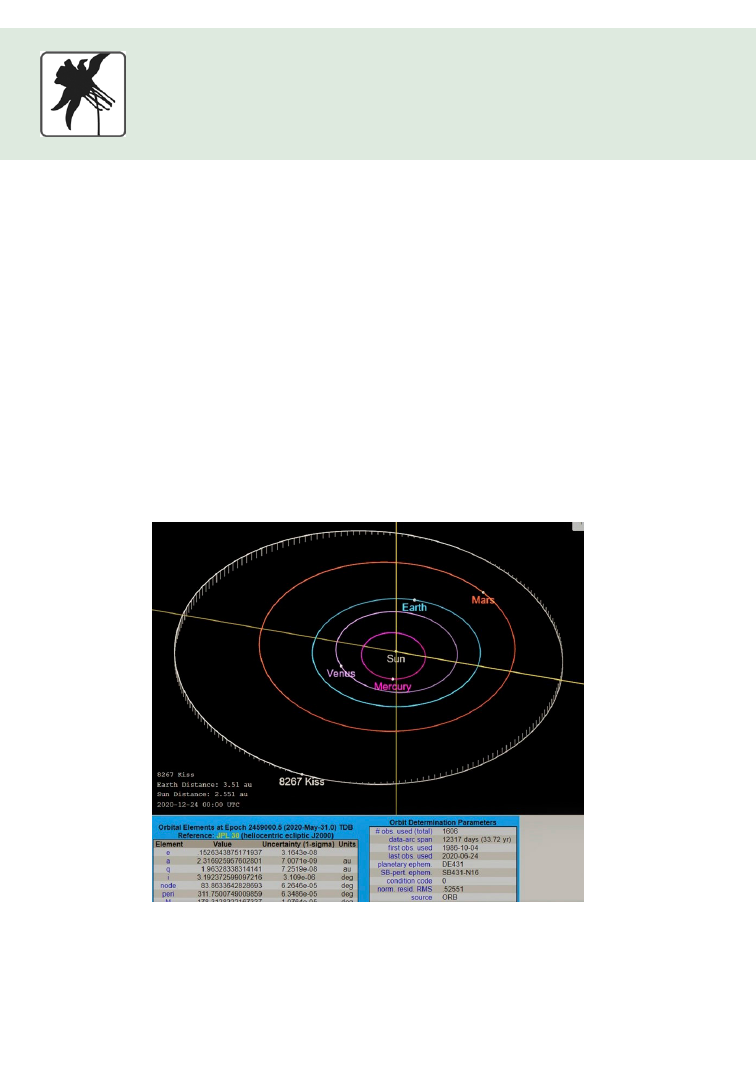
54
ANNOUNCEMENTS
AMERICAN SOCIETY FOR GRAVITATIONAL &
SPACE RESEARCH NAMES ASTEROID
AFTER DR. JOHN KISS
Congratulations to Dr. John Kiss (University of North Carolina, Greensboro), who has been awarded the COSPAR
International Cooperation Medal for distinguished contributions to space science and work that has contributed
significantly to the promotion of international scientific cooperation; he receives this with Dr. F. Javier Medina
of Spain. Along with the medal is the Kiss asteroid (#8267)! Dr. Kiss and Dr. Medina have both been active in
international spaceflight research for more than two decades during which they studied the growth and development
of plants under microgravity in spaceflight. Both served as principal investigators for a joint spaceflight project
named Seedling Growth (SG) where Kiss was funded by NASA and Medina by ESA and the Spanish National
Research Agency to conduct studies on board the International Space Station. The Awards ceremony took place
during the 43rd COSPAR Scientific Assembly in January 2021 in Australia.
-From a statement by the American Society for Gravitational & Space Research
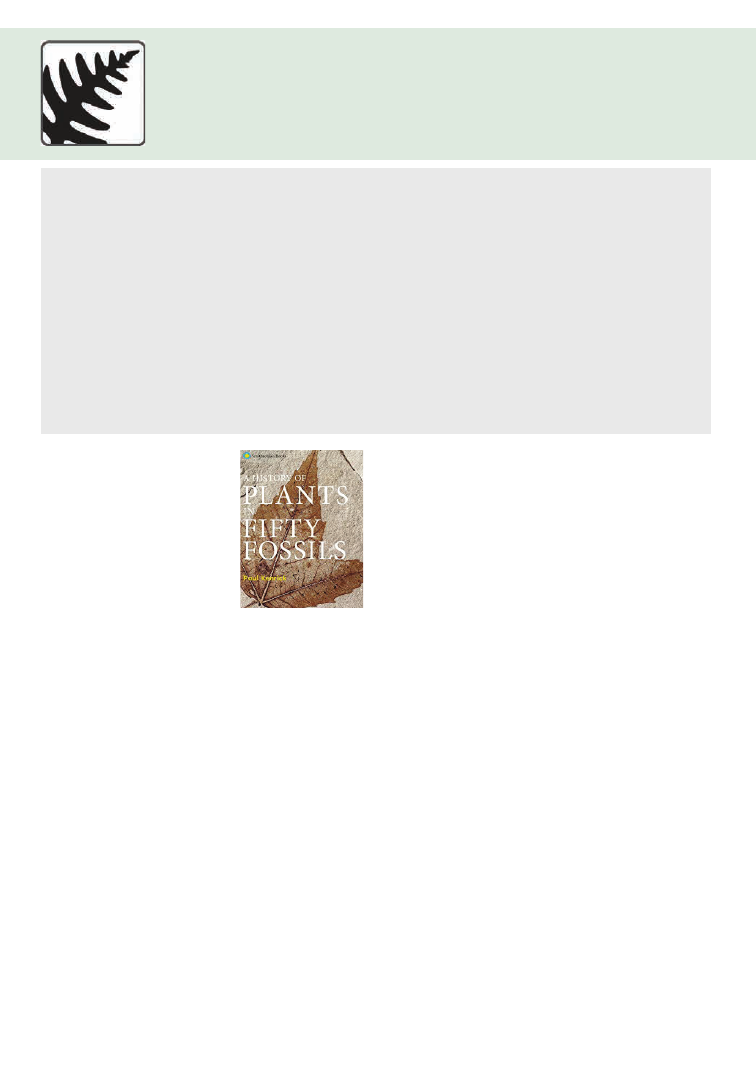
55
A History of Plants in Fifty Fossils
Berries
Botanicum Medicinale: A Modern Herbal of Medicinal Plants
Endophytes for a Growing World
Herbarium: The Quest to Preserve and Classify the World’s Plants
Name that flower - The Identification of Flowering Plants
Orchids of Romania
Population, Agriculture, and Biodiversity: Problems and Prospects
Saffron: A Global History
The Comstocks of Cornell
The Theory of Evolution - Principles, Concepts, and Assumptions
Wildflowers of the Adirondacks
BOOK REVIEWS
A History of Plants in
Fifty Fossils
By Paul Kenrick
2020. ISBN-13: 978-
1588346711
US$18.89, 160 pp.
Smithsonian Books
A History of Plants in Fifty
Fossils, by research scientist
Paul Kenrick, is a beautiful work produced
by Smithsonian Books. The book is a basic
botanical text, evolutionary biology narrative,
and geological work all under one cover. The
stunning photography drips from the pages of
this information-dense publication. I chose
this book because of my admiration for my
friend, Karl Niklas, professor emeritus at
Cornell University. Karl is a pure educator. The
sense of excitement I felt watching Karl teach
is the same sense of enjoyment I received from
reading Kenrick’s beautiful book. “It’s not
easy being a plant.” (Kenrick, p. 5) is the first
sentence to the “Introduction,” and is a section
that should be considered required reading for
any introductory botanical or horticultural
course. If your botanical sensibilities don’t
tingle with anticipation right from the onset
of this first sentence, then put the book down.
Otherwise, read on!
The author has such a delicate mastery of
description that when he bids the reader to
“imagine,” one does just that. One gets an
unmistakable feeling of incredulity to read
of the preservation of plant tissues, which
are transformed over millennia into fragile
compounds, that collectively maintain their
strength through time and decomposition
to reveal their secrets. Kenrick’s masterful
storytelling of a single cell adapting to its
environment to evolve, then adapt again, in a
repeated process of growing and strengthening
and straightening toward sun on stalk, and
with open canopy, is unlike much of what I
ever read or learned about these processes. It’s
refreshing and engaging.
The secrets of a rock that was once upon a
time a lithe tree (here Kenrick writes of the
Eospermatopteris), or an insect captured for
all time in its amber cocoon, astonishes with
their secrets as one learns of the expansive
and pliant adaptations of all of these venerable
fossils. Plants, and the animals that ate them, all

PSB 67(1) 2021
56
developed and evolved specialties through the
ages to ensure their individual and, by default,
collective survival. These adaptations may be
seen in the fossils of seed dispersal, pollen
preserved within the guts of amber-embedded
insects, and coprolites (viz., fossilized feces—
if that’s a new word for you as it was for me)
of early herbivores. Kenrick weaves his tale
of plant evolution through seed, fern, and
tree cone describing the “living fossil” lineage
of the modern horsetail (Equisetum) to the
possible food (the Cycads) of the dinosaurs.
I love the beautiful fan-like shape of the
Ginkgo biloba leaf. It is elegant and simple.
The leaves shimmer together and have for
several millennia, imitating an ancient dance
contrived in its country of origin. Long before
the steps were choreographed, the Ginkgo’s
ancestor established its geological history.
Reading this history is akin to creating a plait
between the cords of climate, seed dispersal
tactics, and geography. According to Kenrick,
Ginkgo has been found on every continent,
including Antarctica (Kenrick, p. 80). All
terra firma has had this beautiful tree rooted
in its worldly soil. Ancient winds once blew
through the fossilized leaves much as our
zephyrs of today swirl about our Ginkgos.
What a thrilling connection to our botanical
past!
We are time travelers in Kenrick’s ship,
and with him at the helm we are vividly
transported in our mind’s eye to the very base
of the trees of the fossils he describes. I was
transported to, once again, stand before the
Metasequoia glyptostroboides in residence at
the Cornell Botanic Garden in Ithaca, NY. To
read Kenrick’s history of the dawn redwood,
once thought extinct yet pulled from the
brink, gives one a thrill of association with
the efforts of early botanists. We may all stand
before this magnificent tree because of these
conscientious scientists, and through Kenrick
we realize the significance of the magnitude of
these efforts.
Interspersed with the fossilized plants and
plant structures are basic, yet elegant, botanical
explanations of the principles of xylem,
stomata, photosynthesis, decomposition,
crystallization, and botanical rebirth and
extinction. Kenrick’s remark that “...extinction
appears to be the ultimate fate of all species”
is a haunting phrase that punctuates a
section where the reader won’t find much
comfort in the pointed descriptions of mass
extinction and changing ecosystems. For all
the academic jollification of this wonderful
book, Kenrick masterfully, and soberingly,
reminds the reader that understanding the
violent extinctions of the past, through these
botanical casts, will contextually impress upon
the consciousness of our humane influences
and impacts on our delicate world.
In the sections following the significant
words of extinction is the 13-million-year-
old fossilized leaf of an Acer trilobatum found
in a volcanic crater. This photograph gave
me pause for the renewal, and regrowth, of
adaptation and plant diversity from pole-to-
pole and in-between. The leaves that senesce
in our autumnal months are strikingly
similar to this ancestor. The organized veg of
an Antarctic fossil, and the contrary messy
clumping of deciduous leaves in a Saharan
sample, fed my curiosity about regrowth from
extinction—what a different place the Earth
was with not only a green Antarctic, but a
green Sahara as well! Kenrick reminds the
reader that “by their presence alone, plants
can transform their habitats” (p. 100)—and
ours as well.
This wonderful book ends with an image index
of the 51 specimens exampled and discussed
throughout. For any cartographers, there
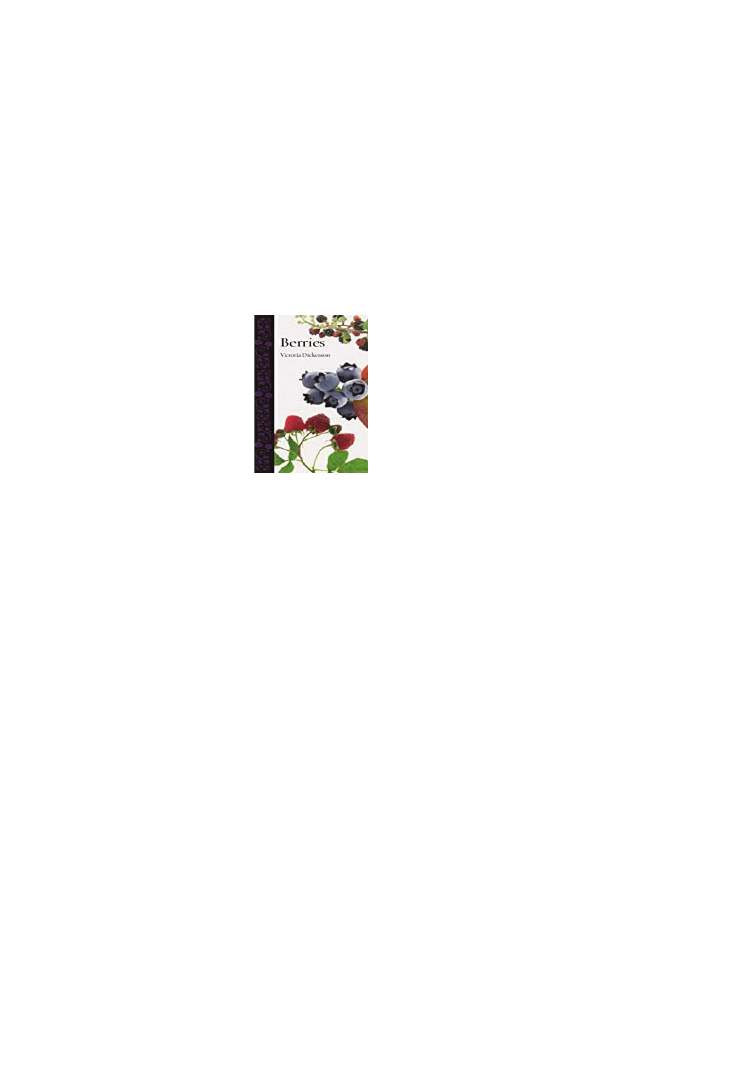
PSB 67(1) 2021
57
are maps of the Earth through time, and the
“gneiss guys” among botanists will appreciate
the succinct geological time scale. Through
his surreptitious tutelage, Paul Kenrick leads
us on an evolutionary journey to ourselves
and of the symbiotic relationship we have
with the botanica in our world.
–Karen Penders St. Clair, Ph.D.
Berries
Victoria Dickenson
2020. ISBN: 9781789141931
$27.00; £16.00 (Hardcover); 208
pp.
Reaktion Books, Ltd., London,
UK, distributed by University of
Chicago Press, Chicago, IL.
Victoria Dickenson, Adjunct Professor,
Rare Books and Special Collections, McGill
University, explored multiple library and
museum collections to prepare a delightfully
illustrated historical review of berries.
Her familiarity with archival resources is
demonstrated through charming creations
by the famous: Hieronymus Bosch, Lewis
Hine, Hokusai, Winslow Homer, Dorothea
Lange, and unknown (e.g., the frescoes of
Pompeii, buoyed by poetry and prose of
eminent modern writers: Emerson, Jefferson,
Shakespeare, Thoreau, Tolstoy; and ancient:
Aesop, Ovid, Pliny the Elder, Virgil).
Dickenson opens with an essential definition
of terms because her book is about culinary
berries, distinct from the strict botanical
definition of berries, those fleshy fruits without
a stone (pit) produced from a single flower
containing one ovary. Berries so defined
include grapes, currants, peppers, tomatoes,
cucumbers, eggplants, and bananas, but
exclude certain fruits that meet the culinary
definition of berries (e.g., strawberries and
raspberries). The latter culinary berries are
aggregate or compound fruits containing seeds
from different ovaries of a single flower, with
the individual “fruitlets” joined together at
maturity to form the complete fruit. Examples
of aggregate fruits commonly called “berries”
include members of the genus Rubus, such
as blackberry and raspberry. Multiple fruits
are the fruits of two or more multiple flowers
that are merged or packed closely together.
As mentioned in a previous review (Bedigian,
2020), the mulberry is a berry-like example of
a multiple fruit; it develops from a cluster of
tiny separate flowers that become compressed
as they develop into fruit. Strawberry is the
aggregate of seed-like achenes, actually the
“fruits,” derived from an aggregate of ovaries;
the fleshy part develops from the receptacle.
Here, Dickenson includes among berries all
small, bright-colored, edible fruit lacking a pit.
A breadth of subjects is incorporated here.
Frugivore bats, birds, reptiles, and insects are
all stars. We must beware the snake in the
grass when searching for strawberries. Berries
often figure in legends and may symbolize
love as well as betrayal, as with the strawberry
fields in Ingmar Bergman’s archetypal
classic 1957 film Wild Strawberries. Cedar
waxwings are almost exclusively fruit eaters;
consequently, they have large livers to deal
with their occasionally alcoholic repasts, and
their extendible throats hold large quantities
of berries, including species toxic to humans.
This was evident during an icy January in
University City MO, when a rush of wings
and reedy calls caught my ear. Turning to
the window, I observed a huge flock of cedar
waxwings that had located the handsome holly
grove in my yard. Over the course of two days,
they plucked the poisonous fruit, leaving the
branches bare of berries.

PSB 67(1) 2021
58
Generous attention is given to gathering
tools, such as berry combs constructed of
wood or, along the Pacific Northwest, salmon
backbone. A special one is made of steam-
curved wood, with the seam bound by a tough
walrus thong, and an ivory handle. Contrast
those with modest Crisco and coffee cans
whose wire handles were carefully wrapped to
prevent callouses.
Child labor, upon which the United States
relied as the industry grew in the period
following the Civil War, is reviewed in the
section about cultivating. Human rights are
foremost in documenting production; much
was borne on the backs of countrywomen.
Dickenson depicts Italian immigrants from
Philadelphia, Syrians from Boston, and Poles
and black Portuguese ‘Bravas’ who picked
cranberries in Massachusetts, Wisconsin and
New Jersey.
Horticultural varieties are many, and efforts to
make a better berry favoring size, flavor, and
productivity were sought. Dickenson reports
in a colorful quote that the blackberry has
been called “a primitive thug that has been
turning parts of the northern hemisphere into
off-limit areas since well before the last Ice Age
began, some thirty-five thousand years ago
(Jonathan Roberts, The Origins of Fruit and
Vegetables),” complaining about brambles.
Jams and jellies offer an ancient technology
for preserving the harvest, which gave way to
the production of “Factory Fruit.”
In recent years, their distinctive chemical
constituents led to considerable consumption
of berries (and the leaves of some species), in a
natural pharmacopeia. Berries are recognized
as superfruits for their polyphenol contents.
Hydroponic cultivation of strawberries
saves back-breaking stoop labor during
harvest. A Japanese researcher’s innovation
in the 1990s—thin nutrient films made of
hydrogel—“provides everything a growing
strawberry needs, resulting in increased yields
of very clean berries.” However, Dickenson
closes with a cautionary note about “industry’s
increased reliance on plasticulture, pesticides,
fertilizers, irrigation and chiefly female labor.”
The design of this well-bound book is
attractive, featuring a vivid cover photo and
signature endpapers—here, the deep purple
hue of blackberry pie. Standard features of
the Botanical series are included: a brief
timeline, reference notes to each chapter, a
select bibliography, a list of associations and
websites, and a five-page Index. Readers with
an interest in nutrition and food trends, as
well as horticultural history, will find this
volume full of gems. This book is a spectacular
success. The illustrations are botanically and
culturally relevant and allow the reader to
happily wander amidst splendidly curated
details.
LITERATURE CITED
Bedigian, D. 2020. An extended commentary about
Mulberry by Peter Coles. Plant Science Bulletin 66(2):
145-150.
–Dorothea Bedigian, Research Associate, Mis-
souri Botanical Garden, St. Louis, Missouri,
USA

PSB 67(1) 2021
59
Botanicum Medicinale:
A Modern Herbal of Me-
dicinal Plants
Catherine Whitlock
2020. ISBN: 978-0262044479
$29.95 (hardcover); 224 pp.
MIT Press, Cambridge, MA
I have a rudimentary
understanding of herbal medicinals and
know something of the soothing properties
of chamomile for nerves, and of aloe for
burns. Wouldn’t one consider pineapple, or
papaya, a fruit? Cinnamon, or cardamom,
spices? Autumn crocus and Lily-of-the-
Valley, flowers? Yet, in Catherine Whitlock’s
Botanicum Medicinale: A Modern Herbal
of Medicinal Plants (2020), all of these and
more fall into an additional herbal medicinal
category. Whitlock’s book is an interesting
read of the common, and not so common,
plants carefully chosen for her purposes of
education and discussion of a traditional form
of therapeutics.
The book’s focus is on educating the reader on
herbal medicine by making use of any plant
part, (i.e., root, bark, leaf, flower, or fruit).
Whitlock chose 100 plants to feature based on
historical use or modern medical research—
all from diverse habitats. Many plants may be
familiar to readers depending on where they
grew up, or currently live, while the converse
is also true. Cotton (Gossypium hirsutum)
and the May apple (Podophyllum peltatum)
are very familiar to me as the chamomile
mentioned above because I live in a temperate
climate. However, this is very different from
the Indian Snakeroot (Rauvolfia serpentina)
and Han Fang Ji (Stephania tetrandra),
which are either native to the tropics (the
aforementioned) or to China (the latter), and
neither of which I’ve visited. This interesting
geographical representation of species is one
facet that reflects from each herbal to make
this work a book of discovery and enjoyment.
A discussion of the “unbroken tradition
of herbalism” (p. 9) includes Ayurvedic
and Chinese herbal medicine followed by
European, then later American, traditional
restorative botanicals. This is not an extensive
section, but rather a base for the author to
lead into her basic discussions of the plant
chemistry of flavonoids (antioxidants found
in brightly colored fruits and vegetables),
alkaloids (think: bitter taste), or glycosides
(a sugar component combined with a non-
sugar component). Whitlock is not laying an
intricate biochemical foundation, but rather
continuing her discussion for the layman.
This is one of the reasons why this book is
so enjoyable—it allows readers with varying
degrees of proficiency to be entertained, or
enticed, or both.
Botanicum Medicinale is encyclopedic in its
layout. The introductory material is followed
by the plant synopsi, and there are five essays
inserted for further commentary on garlic
(Allium sativum), marijuana (Cannabis
sativa), turmeric (Curcuma longa), opium
poppy (Papaver somniferum), and yew (Taxus
spp.). The detailed alphabetized contents and
index, combined with the comprehensive
“Actions of Plants” chart and glossary, ensure
that you will find your plant (if it is one of the
esteemed 100!).
Whitlock capsulized the breadth of botanical
medicinals for her book by choosing select
plants, each beautifully illustrated and
inclusive of each selection’s name (common
and scientific), key uses, medicinal uses,
habitat and harvest, and, importantly,
“Cautionary Notes.” This last section
emphasizes drug interactions herbals may
have with prescription medication, as well
as notes on allergic reactions and potential
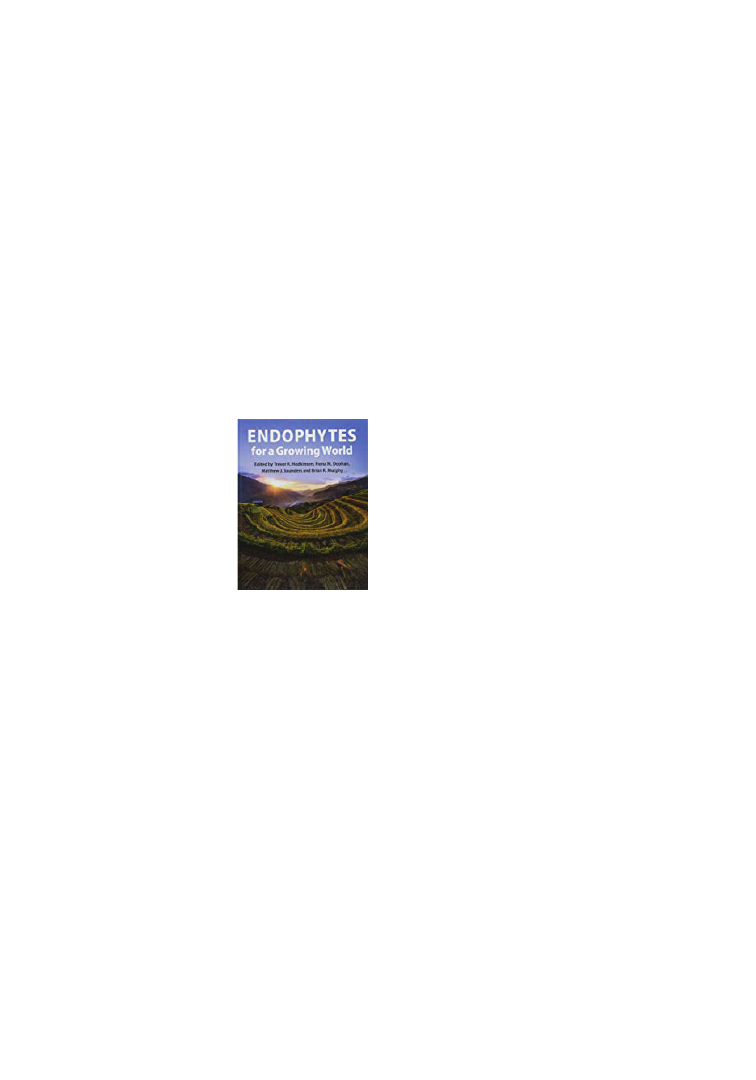
PSB 67(1) 2021
60
toxicity of their own accord. I believe that
this is very smart on Whitlock’s part, for
this interesting, and visually appealing, work
draws the reader in quickly and almost self-
servingly.
Whitlock has provided us with a gateway into
a specialized garden that has been selectively
accessed over the centuries. This book is
not a medical treatise, but rather a botanical
sampling of an ancient mastery thousands of
years old including its uses, and associated
folklore, without being prescriptive.
–Karen Penders St. Clair, Ph.D.
Endophytes for a Grow-
ing World, 1st Edition
by Trevor R. Hodkinson (Edi-
tor), Fiona M. Doohan (Editor),
Matthew J. Saunders (Editor),
Brian R. Murphy (Editor)
2019;
ISBN-10: 1108471765;
ISBN-13: 978-1108471763
US$140.00 (Hardcover), 444 pp.
Cambridge University Press
An endophyte is an endosymbiotic organism
that lives within a plant. Typically, these life
forms are bacteria and fungi. Endophytes for
a Growing World is based on an international
conference held in Ireland in 2017 and is a
series of interesting review articles (that were
peer-reviewed) on basic and applied aspects
of endophytes in plants. There are a total of 56
contributing authors who represent a strong
group of international scientists in the field.
Every chapter has an extensive list of
references that are up to date as of 2018–2019.
The reviews contain line diagrams and half-
tone images, and the center of the book has
selected color plates for the various chapters.
The first chapter is a comprehensive
introduction to endophytes, and it is clear
that the definition of the term itself is unclear!
Throughout the book, while consensus among
scientists exists on definitions, there also are
some variations on the theme. For instance,
some researchers prefer the definition of an
endophyte as being beneficial or neutral for
the plant. Other workers see endophytes as
on a continuum from beneficial to neutral
to pathogenic. A further complication is that
mycorrhizal fungi have a distinct scientific
literature but can be considered endophytes
in a broad definition of the term (Dauzart et
al., 2016; Genre et al., 2020).
Part II of the book consists of six chapters on
the role of endophytes in biotic and abiotic
stress resistance in plants. For instance, one
review considers the use of some groups of
fungi as biological control agents to prevent
plant disease in order to improve crop
production. The authors point out that some
fungi are endophytes in one situation but
can be pathogenic in other cases. Another
chapter reviews the use of endophytic fungi
as a biological control mechanism in barley
diseases.
Part III considers the community ecology
of endophytes in five chapters. For example,
chapter 10 summarizes the ecology of bacterial
endophytes in plant leaf tissue. Another
chapter in this section considers using a
meta-omics approach to study the endophytic
bacterial communities in Brassica napus
(oilseed rape), an agriculturally important
plant.
Part IV includes three chapters and provides
an interesting perspective on using endophytes
as a potential source of novel biomolecules
for applications in industry and medicine.
One chapter examines the use of endophytic
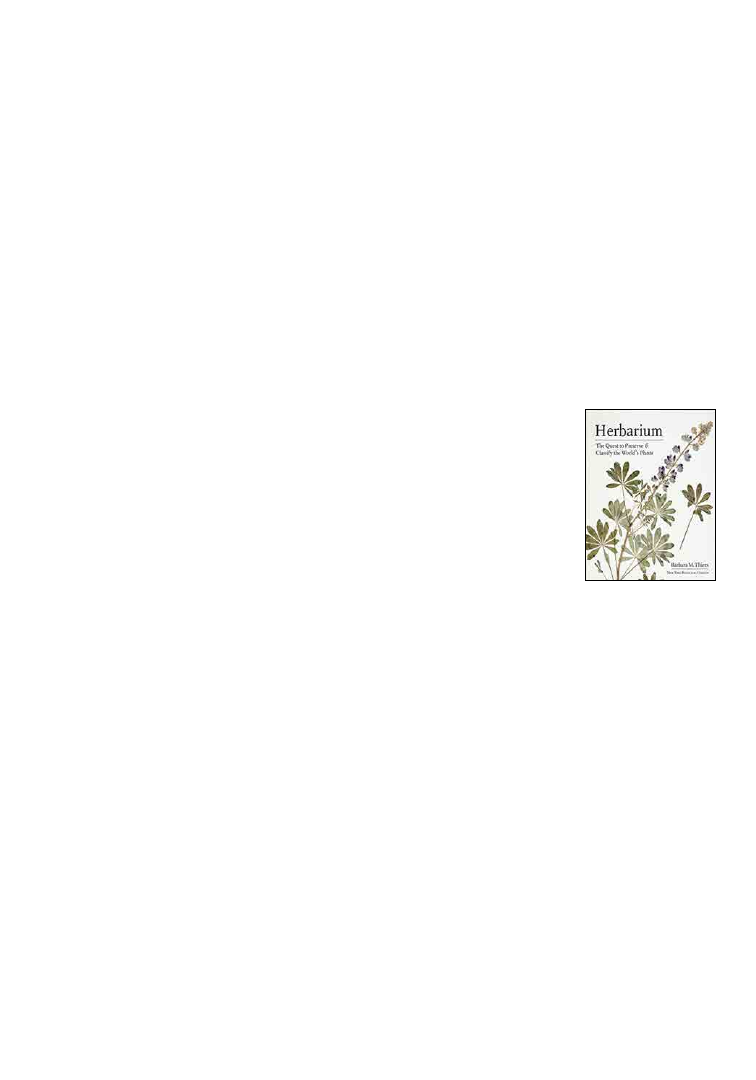
PSB 67 (1) 2021
61
fungi as a source of bioactive compounds. The
authors point out that while plants have long
been used as natural products to treat human
disease, there has been an increased effort in
drug discovery using endophytes. The story
of the discovery of the cancer treatment drug
Taxol from an endophytic fungus in Pacific
yew trees is given as a prominent example of
the potential of endophytes in drug discovery.
The last section (Part V) focuses on the
application of endophytes in crop production
and has three chapters. A particularly
interesting review considers endophytic
bacteria that promote growth of agricultural
plants and that have been used in field trials in
Europe. Part of the impetus for this research
is that the European Union has increased
restrictions on chemical use in farming
throughout the continent. This author takes an
interesting approach in considering political
factors as well as looking at the basic biology
of these approaches.
This book provides a wealth of up-to-date
information on the biology of endophytes
and their host plants. While I have done
some research on mycorrhizal fungi in ferns
and in flowering plants (Swatzell et al., 1996;
Lionheart et al., 2018), this book certainly has
broadened my horizons. It will be a welcome
addition and could be used in advanced classes
in plant physiology, medical botany, and
horticulture. As such, it is more suitable for
advanced undergraduates, graduate students,
and professionals.
LITERATURE CITED
Dauzart A. J. C., J. P. Vandenbrink, and J. Z. Kiss. 2016.
The effects of clinorotation on the host plant, Medicago
truncatula, and its microbial symbionts. Frontiers in
Astronomy and Space Sciences 3: 3.
Genre, A., L. Lanfranco, S. Perotto, and P. Bonfante.
2020. Unique and common traits in mycorrhizal sym-
bioses. Nature Reviews Microbiology 18: 649-660.
Lionheart G., J. P. Vandenbrink, J. D. Hoeksema, and
J. Z. Kiss. 2018. The impact of simulated microgravity
on the growth of different genotypes of the model plant
Medicago truncatula. Microgravity Science and Tech-
nology 30: 491–502.
Swatzell L. J., M. J. Powell, and J. Z. Kiss. 1996. The
relationship of endophytic fungi to the gametophyte
of the fern Schizaea pusilla. International Journal of
Plant Sciences 157: 53-62.
–John Z. Kiss, Department of Biology, Univer-
sity of North Carolina–Greensboro, Greens-
boro, North Carolina, USA
Herbarium: The Quest
to Preserve and Classify
the World’s Plants
Barbara M. Thiers
2020. ISBN: 9781604699302;
ebook: 9781643260525
US$40.00 (Hardcover); 304 pp.
Timber Press, Portland, OR.
Herbarium delivers an
expert’s perspective with an entertaining
account about systematically arranged
collections of dried plant specimens amassed
for scientific study. The reader is taken on
a journey through the history of botanical
collecting, led by an author knowledgeable
about its many facets. Barbara Thiers—
director of the William and Lynda Steere
Herbarium at the New York Botanical Garden
(NYBG), President of the American Society
of Plant Taxonomists (2020-2021), and past-
president of the Society for the Preservation
of Natural History Collections—is perfectly
positioned to introduce the general reader to
the particulars and purposes of an herbarium.
Thiers is responsible for overseeing the
NYBG’s 7.9 million collections of algae,
bryophytes, fungi, and vascular plants, and
the staff who manage these collections. As

PSB 67 (1) 2021
62
editor of Index Herbariorum, the guide to
the world’s approximately 3300 herbaria,
Thiers has applied information technology
to herbarium management and to increasing
access to specimen-based data for the scientific
community. These interests have led to the
searchable database of digitized herbarium
specimens (4.5 million so far, with 400,000
added each year), comprising the Steere
Virtual Herbarium.
Thiers’ purpose in writing the book is stated
as (1) an introduction to herbaria for natural
history enthusiasts and for colleagues to share
with students, staff, and institutional leaders;
(2) to show the wide range of circumstances
under which specimens have been gathered
and handled after collection; and (3) to
engender appreciation for the institutions that
made a commitment to preserve specimens in
perpetuity.
The impetus for the establishment of herbaria
was the number of new plant species coming
into Europe during the Age of Exploration.
It was nearly impossible to keep plants alive
on long sea voyages, so seeds and dried
specimens often became the Europeans’ first
introduction to unknown plant species. Italian
physician/professor Luca Ghini (b.1490)
advanced the study of plant medicine and
created the first herbarium—a book filled
with pressed specimens of plants, glued onto
the pages alongside annotations about the
plant’s features, the circumstances behind its
collection, its known medical properties, and
other facts. “If handled carefully and kept
protected from moisture, insects, and light,
a dried plant specimen could be preserved in
this manner indefinitely.”
A synopsis of the contributions of major plant
collectors follows, such as William Dampier,
an English explorer, pirate, and navigator who
became the first Englishman to explore parts
of what is today Australia, as well as the first
person to circumnavigate the world three times.
Running through the book are examples of
the fact that this is a world dominated by men.
Those who subsidized the missions—ship
captains and high-ranking officials—took
a dim view of women. A remarkable brave
and determined pioneer of plant exploration
whose experiences piqued my curiosity is
Jeanne Baret, who accompanied naturalist
Philibert Commerson. Disguised as a man
on the 1676–1679 French expedition of L.A.
de Bougainville as his valet, Baret kept her
identity hidden from all but Commerson for
many months. Baret proved herself capable of
demanding manual labor. She was invaluable in
assisting Commerson as his slogger, collecting
botanical specimens when Commerson’s
health had failed, although she received no
acknowledgement as collector. Baret also
organized his collection and papers, of which
he was neglectful, and ultimately became the
first woman to circumnavigate the globe.
Although Thiers relied on Ridley (2011) in
retelling Baret’s role, some, including Gimson
(2014), Helferich (2011), Knapp (2011),
and Lack (2012), have questioned Ridley’s
speculations; perhaps some of their concerns
were overlooked. Dunsmore’s 2002 biography
seems to be more factual but is presently
unavailable in bookshops; only six copies
exist in the United States, at the Library of
Congress and universities. Reviewer Philippa
Jamieson wrote: “[Dunsmore] outlines the
historical context, and details life on board an
eighteenth-century sailing ship: the cramped
conditions, rats, dwindling supplies, scurvy.
He has been assiduous in his research; the
book includes diary excerpts, footnotes, an
index and bibliography.”

PSB 67 (1) 2021
63
A major dilemma for many herbaria surfaces
in Thiers’ effective and cautionary description
about the plight of the Lewis and Clark
herbarium: “The specimens follow the same
sorry trajectory of those by early European
explorations—the specimens were gathered
and preserved with great effort through
the course of a difficult journey, only to be
forgotten and neglected later, due to the
weakness of the scientific infrastructure.”
A debated preference amongst taxonomists
figures in Thiers’ description of Rafinesque’s
penchant as an extreme splitter, who based
new species on slight variations in leaf shape
or size, or flower color; thus, most of his
species names are now disregarded.
Herbarium is intended, according to the
author’s preface, to provide context for
readers lacking knowledge about historic
plant explorations or herbaria. Thiers tracks
the evolving discipline of plant taxonomy,
including the practical roles that herbarium
specimens play, e.g., now enabling research
using genomics tools, that may even provide
information about extinct species. Naturally,
readers will assess the book as it relates to
their specific disciplines. For this reader, it
seems that the information researchers glean
from herbaria deserves more emphasis: (1)
labels hold significant indigenous knowledge
about medical, edible, fiber, and ritual uses
of plants (Von Reis and Lipp, 1982; Bedigian
2004a, 2004b, 2013a, 2018; Nesbitt 2014); (2)
a major source for species discovery (e.g.,
Bedigian, 2013b); (3) vernacular names help
to trace trade (Bedigian, 2004a) or (4) confirm
occurrence at a specific location (Bedigian,
2011); and (5) facilitate an understanding of
how climate data (heat, drought and insect
outbreaks, extreme rainfall patterns) are
affecting species composition, or adaptations
to new environments.
The range of topics covered depict social
and geographic, as well as botanical, history.
Herbarium is a useful resource for students,
educators, and natural history enthusiasts with
an appetite for travelogues and the history of
plant exploration. This well-bound, profusely
illustrated hardback belongs in every library
with any focus on biology. Thiers’ style is
easy to read; specialist terms are defined.
It’s a hefty book with attractive moss green
cover and bright yellow endpapers. Thiers
presents a useful introduction that assembles
a series of significant events in the history of
plant collecting and the people who made it
happen, correlated with world affairs. Those
vivid stories bring specimens to life.
LITERATURE CITED
Bedigian, D. 2004a. Importance of botanical data to
historical research on Africa. In: Philips, J. E. (Ed.).
Writing African History: Methods and Sources, pp.
152-168. Rochester University Press, NY.
Bedigian, D. 2004b. Slimy leaves and oily seeds: Dis-
tribution and use of wild relatives of sesame in Africa.
Economic Botany 58: S3–S33.
Bedigian, D. 2011. Sesame cultivation and irrigation
in the Kingdom of Urartu (Ararat), Armenian High-
lands, and its aftermath: major agricultural innovation.
In: Bedigian, D (Ed.). Sesame: the genus Sesamum.
Medicinal and Aromatic Plants - Industrial Profiles se-
ries, pp. 367-388. CRC Press, Taylor & Francis Group,
Boca Raton, FL.
Bedigian, D. 2013a. African origins of sesame culti-
vation in the Americas. In: Voeks, R., and J. Rashford
(Eds.). African Ethnobotany in the Americas, pp. 67-
120. Springer, NY.
Bedigian, D. 2013b. Ecogeography and taxonomy of
Rogeria J. Gay ex Delile (Pedaliaceae).
Webbia:
Journal of Plant Taxonomy and Geography 68: 103-
126.
Bedigian, D. 2018. Feeding the forgotten: Wild and
cultivated Ceratotheca and Sesamum (Pedaliaceae)
that nourish and provide remedies in Africa. Economic
Botany 72: 496-542.

PSB 67 (1) 2021
64
Dunmore, J. 2002. Monsieur Baret: First Woman
Around the World, 1766-68. Heritage Press, Auckland,
New Zealand. Website: https://www.goodreads.com/
book/show/12762139-monsieur-baret.
Gimson, M. 2014. Comment. Response posted in Nug-
gets from the Archives on March 12, 2014 by Elizabeth
Kiernan. Website: https://www.nybg.org/blogs/sci-
ence-talk/2014/03/the-amazing-feat-of-jeanne-baret/.
Helferich, G. 2011. Incredible voyage. Wall Street
Journal 24 January. A 11.
Knapp, S. 2011. The plantswoman who dressed as a
boy. Nature 470: 36-37.
Lack, H. W. 2012. The discovery, naming and typi-
fication of Bougainvillea spectabilis (Nyctaginaceae).
Willdenowia 42: 117-126.
Nesbitt, M. 2014. Use of herbarium specimens in eth-
nobotany. In: Salick, J, K. Konchar, and M. Nesbitt.
(Eds.) Curating Biocultural Collections: A Handbook,
Chapter 22. Royal Botanic Gardens Kew, Richmond,
Surrey, UK.
Ridley, G. 2011. The Discovery of Jeanne Baret: A
Story of Science, the High Seas, and the First Woman
to Circumnavigate the Globe. Broadway Books, NY.
Von Reis, S., and F. J. Lipp. 1982. New Plant Sources
for Drugs and Foods from the New York Botanical
Garden Herbarium. Harvard University Press, Cam-
bridge MA.
–Dorothea Bedigian, Research Associate, Mis-
souri Botanical Garden, St. Louis, Missouri,
USA
Name That Flower: The
Identification of Flower-
ing Plants, ed. 3
By Ian Clarke and Helen Lee
2019. ISBN: 9780522876048
US$39.99; 374 pp.
Melbourne University Press
“What is the importance
of naming flowers?” one
might ask. In fact, I was asked this same
question very early in my career. I remember
sitting in an introductory systematics class
as a first-year undergraduate student at
the University of São Paulo in Brazil. My
instructor at the time was Dr. Renato de
Mello-Silva, a bright and inspiring botany
professor and herbarium curator in my
institution. He, unpretentiously, asked the
class a simple question after presenting a
picture of a tree: “What’s the name of this
tree?” Nobody knew. He continued by saying
that if you cannot name that tree, it simply
does not exist. He explained that as long as
biologists do not name and describe species,
no one could accurately study and refer to
them. That powerful line has been stuck in my
memory since that day, and the book Name
That Flower reminded of me that moment.
The introductory chapter provides the readers
with a background on land plant evolution;
it discusses the historical relevance of
plants and emphasizes their economic value
throughout human history. It also covers the
overall organization of the book and some
essential pieces of information on how to use
the book. Chapter 2 describes very objectively
the structure of flowers without omitting
crucial details and exemplifies the
concepts
with great illustrations. Although this chapter
is very technical and detailed, it is also very
pleasant to read.
The remaining chapters of the book are
focused on describing the major land plant

PSB 67(1) 2021
65
families that are
common to southeastern
Australia
. Helpfully, the authors included a
key morphological trait that is easy to spot for
every family.
The plates are especially visually
appealing; the images are detail-rich and
provide different angles and points of view
of the flower parts.
The book also contains a
brief key for identifying plant species
, focused
on identifying the species illustrated on the
plates.
The book proposes a traditional approach
to plant identification in which the reader
should be outdoors with tweezers and scalpels
dissecting a flower to run a dichotomic
key. But the authors also acknowledge the
wonders of recent advances in technology
in which books and guides can be accessed
online, the pictures can be magnified, the keys
can be interactive, and museums and herbaria
can be visited remotely from everywhere.
The concepts and skills that one could obtain
from this book are easily transposable to other
books or keys that cover plant species from
any other region in the world. I consider the
chapters on morphology and the stunning
illustrations especially relevant. In summary,
I definitely recommend this book for casual
plant enthusiasts and professionals alike.
–Aline Rodrigues de Queiroz, MS, Biochem-
istry Department, University of Nebraska-
Lincoln
Orchids of Romania
Nora De Angelli and Dan
Anghellescu
2020. ISBN: 978-973-0-32586-7
US$75.00 (Hardcover); 300 pp.
Snagov
Beautiful books containing
good descriptions and
excellent photograph of spectacular tropical
orchids are common. Much less common
are similar books that deal with temperate
climate orchids, which are mostly terrestrial,
small, and often not attention grabbing. This
book (full disclosure: the authors sent me a
copy, graced with a flattering inscription, as a
gift) belongs to the latter category.
A problem with temperate climate orchids
is that their flowers are mostly small, even
if they’re as beautiful as their large tropical
cousins. Because of that, they are hard to
notice even in their natural habitats, and
they’re not easy to see and appreciate. The
authors overcame this problem by using
macro photography (with Nikon and Canon
cameras and lenses; my lifelong experience
and bias are that Micro Nikkor lenses are
hard to beat) and the relatively new technique
of photo stacking. This technique consists
of combining many images (sometimes as
many as 100) in a single photograph to obtain
greater depth of field, which decreases as
magnification increases. Examples of this are
the anther details on pages 177 and 181, and
flower and labellum details on pages 257, 261,
263, and 283. (This information was provided
via email by the first author.)
The photographs are very sharp; the ones on
pages 22 and 182 and inside the front and back
covers are spectacular. Most photographs are
properly cropped to emphasize the orchid.
The background of those that are not cropped

PSB 67(1) 2021
66
is: (1) just enough out of focus to create
pleasant bokeh resulting in photographs that
are artistic but still draw attention to the
orchid, or (2) informative regarding habitats
and other plants near the orchid.
In addition to photographs of orchids only
(flowers, inflorescences, plants, habitats),
there are also images of visitors (pollinators,
robbers, predators, visitors who came to rest or
feed, and ones who just happen to be there). On
page 10, six interesting photographs illustrate
the pollination sequence of Cypripedium
calceolus by a solitary female Lasioglossum
bee. In Asia and tropical America, predatory
spiders associate with orchid flowers, mimic
them, or hide near/in them to prey on
pollinators. (I saw one in the Bogor Botanical
Gardens in Indonesia; its web was very hard
to see, and my student there at the time, the
late Djunaidi Gandawijaja, had to squirt a fine
mist of water on it to make possible a now long-
lost photograph.) Some Romanian spiders
also prey on orchid visitors. A yellow spider
waiting for small insects was photographed
on the same color pouch of C. calceolus (p.
10). A butterfly on an Anacamptis palustris
is oblivious to a hard-to-see spider, which
was probably stalking it (p. 47) and may have
made a meal of it since the photograph was
taken. On page 255, a crab spider on Neottia
ovata feasts on a garden chafer.
Altogether, the photographs create a
magnificently illustrated, visually attractive,
and botanically instructive book—a rare
and very welcome combination. A drawback
is that the photographs do not contain size
indications either as a magnification factor
(the usual “×” followed by a number in the
caption) or a scale bar on the image. Size
indications are especially important in this
case because the orchids are small and some
are magnified in the photographs.
Descriptions of genera and species are
sufficient to acquaint readers with the
taxon, which is being described without
including many of the boring, and sometimes
numbing, terms favored by taxonomists. The
meanings and/or origins of generic, specific,
and varietal epithets are always explained.
Where appropriate, legends, mythological
information, usage details, and historical data
are also included. All are clear and easy to
read. A problem with the descriptions is that
information about size and dimensions is not
included. It should have been.
The origin of the term “orchid” is usually
attributed to the ancient Greek, so-called
Father of Botany, Theophrastus (371–287 BC)
who saw a similarity between mammalian
testicles (orchis or, as listed in the book, orkhis,
a spelling I saw for the first time; I do not
know which is correct). There is even a story
of goat sperm that fell to the ground during
copulation and fermented into orchids.
Most authors (including myself) usually just
repeat these stories. Not the authors of this
book. They tell a little-known (by me, also)
story, the Myth of Orchis. It is of Orchis, the
son of a satyr and a nymph, who attempted
to rape a Dionysus (the Greek god of wine)
favorite. Angered by this, the Maenads, female
followers of Dionysus, tore him apart. Orchis’
father begged the gods to revive him, but they
refused; instead, they transformed his testicles
into the root tubers of an orchid, which was
first called Satyrion and later became known
as Orchis.
Enough literature is listed in the References
and Bibliography to allow those who are
interested in further reading to do so. I am
especially pleased that papers by A. Fuch and
H. Ziegenspeck are cited. These two friends
(at least one of them was a pharmacist, if
memory serves correctly) studied German

PSB 67(1) 2021
67
native orchids extensively and published very
long and detailed papers (largely forgotten at
present) in the mid-1900s in the Botanisches
Archiv and its Beihefte. When Fuchs died,
Ziegenspeck wrote a touching obituary of
his friend and continued to work by himself
for a while. However, I was disappointed not
to see in the References and Bibliography
Bertil Kullenberg’s seminal work on
pseudocopulation and ultraviolet reflection
images of Ophrys. His ultraviolet reflection
images may well be the first application
to orchids of this type of photography. M.
Pouyanne, president of the court in Sidi-
Bel-Abes in Algeria, who first described
pseudocopulation in Ophrys speculum in
1916, is cited.
An interesting feature for those interested in
both orchids and postage stamps is on pages
296-297: Photographs of Romanian postage
stamps that feature orchids. Many countries
(including the United States) publish postage
stamps that bear photographs of native
orchids, but few local-orchid flora books
mention them.
The last page of the book contains two
photographs of the kind one does not generally
see in orchid books. One photograph is of
the author and her very handsome Belgian
Malinois (spelled in the book as Malionois)
dog, Ringo. The other is of Ringo alone. He,
according to the author “is probably the only
orchidolois (sic) Beligian Malionois (sic) in the
world.” Probably so. As a dog lover, I welcome
what may well be the first acknowledged
canine orchidologist and look forward to
many more. Why not? Orchids have been
connected with dogs in the English language
for a long time. In describing Ophelia’s
garland in Hamlet, Shakespeare refers to
“long purples”—probably Orchis mascula,
which has the “grosser” name “dog stones”
because its roots are shaped like testicles (the
use of “stones” to mean “testicles” is ancient
according to the Oxford English Dictionary).
I was disappointed to note that the book
has no index. A large (a heavy 300 pages
measuring 28.5 cm H × 23.5 cm W × 2.3 cm
thick), complex, diverse, informative, and
meticulously produced book like this one
should have a very detailed, extensive, and
comprehensive index.
Altogether this is a beautiful and interesting
book that presents temperate climate European
orchids excellently in text and photographs. It
would be appropriate in general botany and/
or orchid specialists’ libraries (I am certainly
glad to have it in mine), and/or to grace
any coffee table. Romanian consulates and
embassies should have it in their waiting and/
or reception rooms because it may attract
visitors who are interested in orchids.
–Joseph Arditti, Professor of Biology Emeritus,
University of California, Irvine
Population, Agriculture,
and Biodiversity: Prob-
lems and Prospects
J. Perry Gustafson, Peter H.
Raven, and Paul R. Ehrlich
(eds.) 2020.
ISBN: 978-0-8262-2202-2
US$45.00 (Hardcover),
398 pp.
University of Missouri Press,
Columbia, MO
Since the recognition of Planetary Boundaries
(Rockström et al., 2009), we have had a tool
to evaluate human impact on the biosphere.
What usually goes unsaid, however, is
brought to the forefront by the editors in their
introduction. There is a single underlying
cause for all of these existential problems: “If
our goal is environmental stability, we really

PSB 67(1) 2021
68
need to limit population growth” (p. 2). The
editors go on to summarize the problems and
approach of the book as they introduce the
topics that will be covered in the subsequent
15 essays. In the next 30 years, agricultural
productivity will have to increase by 2.5%
to 3% to feed the estimated 9 to 10 billion
people, yet agricultural production currently
contributes about 21% of greenhouse gases
and nearly 40% of the methane, contributing
to climate change. Between 500 and 2000 L
of water, as well as large amounts of chemical
fertilizers, pesticides, and herbicides, are
necessary to produce 1 kg of grain, half
of which is fed to animals, while runoff
and percolation contaminate surface and
groundwater. Biodiversity is lost as croplands
replace forest and grassland. All of these
intricate relationships are addressed in this
volume, and while many are familiar to our
professional community, the authors and
editors have done a good job of integrating
the complexity in a way that can be presented
to the general public. What I found especially
useful was the integration of the agricultural,
economic, and social perspectives throughout
the book, not just in specific chapters.
Paul and Anne Ehrlich set the stage in the
first chapter with an overview of the current
state of the problem with considerations of
how the interconnection of human nutrition,
the environment, economics, resources, and
politics affects and is affected by population
growth. I found the most encouraging
chapter to be Nina Federoff’s treatment of the
possibilities and probabilities of feeding 10
billion people. She begins with a brief history
of agriculture, from crop domestication
through crop improvement by breeding, the
mechanization of agriculture, and the Green
Revolution. This segues into a series of sections
describing molecular genetic modification
of crops and technological innovations in
production as tools to do more with less.
She is enthusiastic about the possibilities,
but realistic about the cultural pushback and
need for more effective education. Success
will “require both cultural changes in how
we view food and substantial increases in
educational level worldwide, both of which
present challenges as great as that posed by
the necessary technological advances” (p. 55).
Specific problems impinging on agricultural
production, and their possible solutions,
are the focus of the next 10 chapters. These
include the role of trade, climate change,
tropical deforestation, increasing yield in
grain crops, physiological breeding, wild
ancestors and breeding, genome engineering
techniques, insecticide, fungicide and
herbicide resistance, and water. A new, and
particularly appropriate, concept for me was
that of “wicked problems,“ introduced in
the chapter “Feeding a world in the wake of
climate changes and resource constraints.” As
defined by Batie (2008), “…wicked problems
tend to be intractable and elusive because
they are influenced by many dynamic social
and political factors as well as biophysical
complexities.” This book is ultimately a case
study of the wicked problems that must be
solved in the next half-century.
The final three chapters focus on loss
of biodiversity: the impact of livestock,
agriculture, and pollution in the environment,
and direct impacts of agriculture on
biodiversity. I particularly liked Pimm’s
treatment of extinction in the last chapter.
His approach is reminiscent of The World
According to Pimm (2001), where he uses
real, but simplified (rounded), data to
calculate concrete values to illustrate theory.
In the sections on “How fast are species
going extinct” and “How fast should they
go extinct,” he introduces the concept of
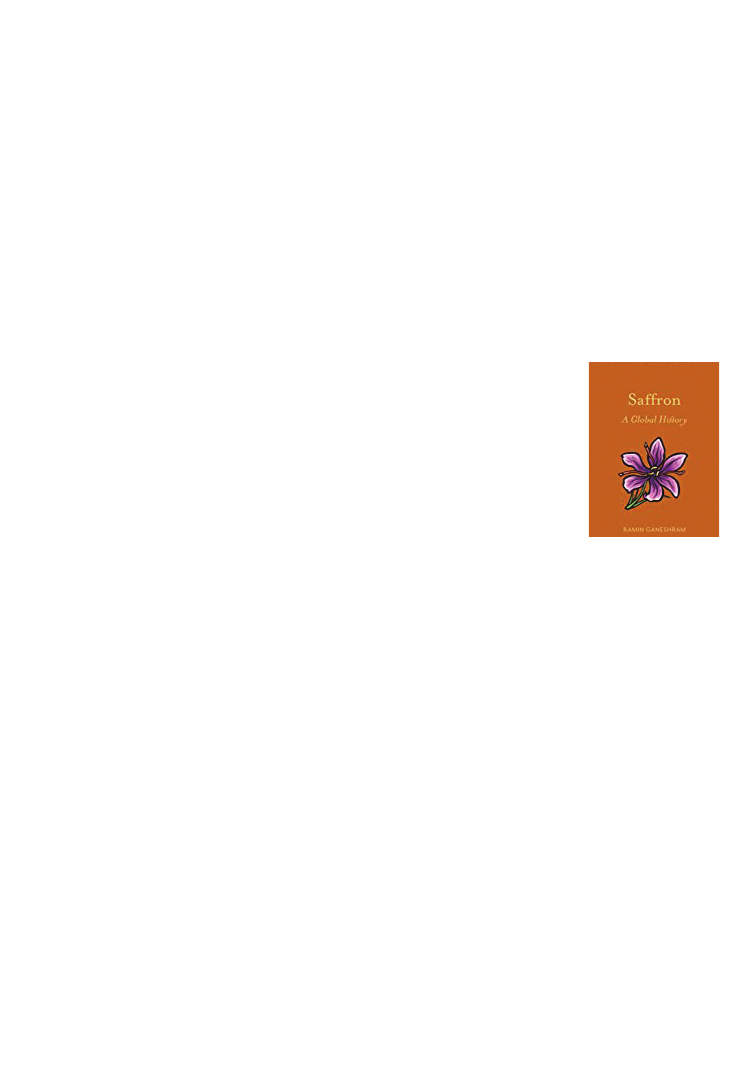
PSB 67(1) 2021
69
Saffron: A Global History
Ramin Ganeshram
2020; ISBN 9781789143300
US$19.95 (Hardcover),
142 pp.
Reaktion Books, London
Saffron, by food writer and
professional chef Ramin
Ganeshram, is a new
addition to Reaktion Books’ Edibles series.
Targeted to epicures, Ganeshram promotes
the “preciousness of saffron,” literally worth
its weight in gold. As with other books in this
series, this book does not exceed 150 pages in
length, resulting in a short summary rather
than a comprehensive reference work.
Keeping to its subtitle, Saffron is organized
into short chapters titled: “Origin and Early
Cultivation,” “Ancient World and Silk Road,”
“Medieval and Renaissance Eras,” “North
America and Caribbean,” “Arts and Medicine,”
“Modern Market,” and “A Saffron Primer.”
Although it includes attributes of a scholarly
book: select references, a brief bibliography,
and succinct index, the target audience for
this book is not an academic reader. Instead,
the audience may range from foodies to
laypersons interested in a history of globally
consumed foodstuffs.
extinctions per million species-years (E/MSY)
with an example from the birds he knows well.
Thirteen of the 1230 species of birds known in
1900 were extinct by 1980. This cohort of 1230
species, over an 80-year period, accumulated
about 98,400 years, so the extinction rate is
13 × 10
6
/ 98,400 = 132 extinctions/million
species years. Calculation of the background
rate is more complex, but the result is <1 E/
MSY (~0.1 E/MSY). Where do extinctions
occur, where is biodiversity high, where do
we find agricultural lands, and what happens
when these collide are the questions addressed
in the remainder of the chapter.
Many of the 45 figures and 15 tables, distributed
among two thirds of the chapters, will be
useful for teachers. Derek Byerlee’s chapter
on agriculture and tropical deforestation is
particularly useful as he compares the trends
in plant oil and livestock production over time
and by region as well as how they are affected by
market supply and demand, commodity value,
state policies, local initiatives, and individuals’
participation. Equally comprehensive is the
multi-authored chapter on livestock impact
on biodiversity. A projected 20% increase in
meat, eggs, and fish production in the next 30
years was not surprising, but I was not aware
that milk production was more than twice
the total of all of the above in 1980 and is still
projected to be 20% more than the total of
meats, eggs, and fish in 2050. The book is full
of little gems of information I will add to class
notes for several of my courses. If you teach
general education, you will want this book on
your shelf and in the school library. Several
of the chapters, by themselves or in groups,
could be the scaffold for a graduate research
seminar. I recommend it very highly.
LITERATURE CITED
Batie, S. S. 2008. Wicked problems and applied eco-
nomics. American Journal of Agricultural Economics
90: 1176-1191.
Pimm, S. L. 2001. The world according to Pimm: a
scientist audits the earth. McGraw-Hill.
Rockström, J., W. Steffen, K. Noone, Å. Persson, F. S.
Chapin III, E. F. Lambin, T. M. Lenton, et al. 2009. A
safe operating space for humanity. Nature 461: 472-475.
–Marshall D. Sundberg, Roe R. Cross Professor
of Biology, Emporia State University, Emporia,
KS.

PSB 67(1) 2021
70
Ganeshram offers a brief overview of the
biology of the plant—its origin, varieties, and
production—and then shows how saffron
became a global commodity. She shows
varying roles that saffron plays in different
countries, citing a variety of festivals, myths,
and practices, brightening the chapters
with anecdotes and details about numerous
preparations using saffron. As saffron is the
most expensive agricultural commodity in the
world, it ranks among the most adulterated
food items internationally. The reason for
its hefty price is its labor-intensive harvest,
which cannot be automated. Saffron is revered
for its medicinal properties to enhance libido,
boost mood, and improve memory, along
with numerous treatments that have been
investigated in controlled studies (Mousavi
and Bathaie, 2011; Poma et al., 2012;
Christodoulou, 2015; Hosseini et al., 2018;
Cardone et al., 2020).
As regards antiquity, Ganeshram relies
heavily on Day (2011) and Dewan’s (2015)
thoroughly documented research for her
Introduction. Notwithstanding, she writes (p.
9) that “Saffron traces can be found in cave art
in Mesopotamia dating back at least 50,000
years,” a claim of momentous significance, if
correct. Unfortunately, she cites no publication
attesting to this fact, and my own searches for
confirmation found none. One would have
to infer that saffron was used as a pigment
for cave art by Neanderthals, many centuries
before the earliest date (6th–5th millennium
BCE) for Sumerian civilizations. The next
question is, would water soluble saffron
pigment persist for 50,000 years?
Adding to the confusion, the book’s back cover
also postulates: “Traces of saffron can be found
in 50,000-year-old cave art of Mesopotamia.”
Ganeshram may be referring to an image
illustrating a woman collecting saffron stigmas
designated “Saffron Gatherer” from the
excavation of the Bronze Age Minoan town
Akrotiri on the island of Santorini, Greece.
Sometime between 2,000 and 1,600 BC, the
Minoans arrived in Santorini and settled in
Akrotiri. Its strategic location enabled that
Minoan city to develop with public buildings,
streets, stone houses, markets, and even
a sewage system. The frescoes of Akrotiri
are renowned for their vivid colors and
beautifully preserved depictions. Ganeshram
appears to conflate Mesopotamian with
Minoan or Mycenean civilizations, which are
entirely distinct geographically, temporally,
and culturally.
Most cave paintings date to the Upper
Paleolithic, which begins ca. 40,000 BC in the
Near East. Prior to this period, Neanderthals
were the inhabitants of this area, although
cave art is not associated with them (Shipley
and Kindscher, 2016). The most famous
Mesopotamian site is probably Shanidar Cave
in Iran (Sommer, 1999).
Paleolithic artists seem to have used two
main colors, although others have been found
in some cave art. The dominant two are red
(which tends to be iron oxide: natural hematite
or heated goethite) and black (charcoal or
manganese oxides) (Siddall, 2018). What is the
likelihood of saffron pigment surviving 50,000
years? Saffron pigment is primarily produced
by crocin (chemical composition: C
44
H
64
O
24
)
(Bathaie et al., 2014), one of the few naturally
occurring carotenoids, and is easily soluble
in water. This water solubility is one of the
reasons for its widely preferred application as
a colorant in food and medicine. Therefore, its
persistence for 50,000 years on impermeable
rock seems doubtful.
Admittedly, this is the first in Reaktion
Books’ Edibles series that I have read; it may
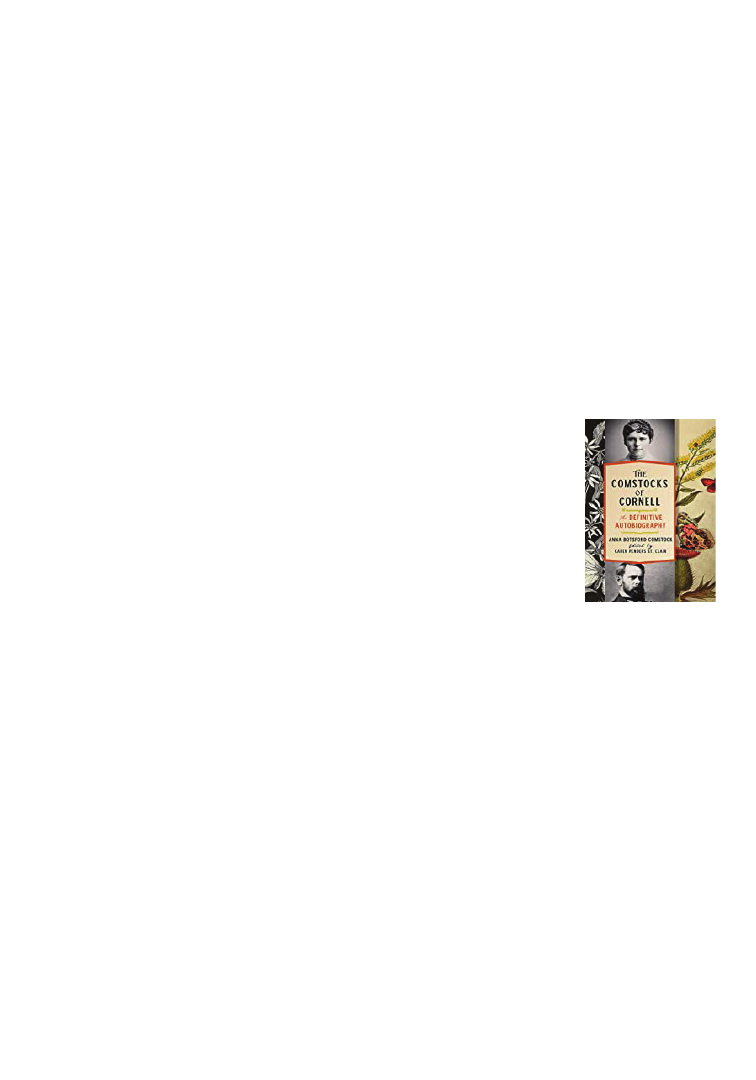
PSB 67(1) 2021
71
serve some general interest, but I hesitate to
recommend this book to librarians or students.
Their Botanicals series seems to be directed to
more serious readers, written by authors who,
in most cases, are experts in their fields.
Overall, the book introduces the long history
of saffron and the many ways in which cultures
have valued saffron as a spice and a symbol.
It is an accessible resource, nicely illustrated
with 48 color plates; of particular note,
these include botanical prints, the frescoes
of ancient Santorini, Mogul-era miniatures,
saffron-hued robes of Buddhist monks, and
photographs of recipes starring saffron.
Twenty pages of recipes close the book.
LITERATURE CITED
Bathaie, S. Z., A. Farajzade, and R. Hoshyar. 2014. A
review of the chemistry and uses of crocins and cro-
cetin, the carotenoid natural dyes in saffron, with par-
ticular emphasis on applications as colorants including
their use as biological stains. Biotechnic & Histochem-
istry 89: 401–411.
Cardone, L., D. Castronuovoa, M. Pernio, N. Cicco,
and V. Candido. 2020. Saffron (Crocus sativus L.), the
king of spices: An overview. Scientia Horticulturae
272: 109560.
Christodoulou, E., N. P. E. Kadoglou, N. Kostomitso-
poulos, and G. Valsamia. 2015. Saffron: A natural prod-
uct with potential pharmaceutical applications. Journal
of Pharmacy and Pharmacology 67: 1634–1649.
Day, J. 2011. Counting threads. Saffron in Aegean
Bronze Age writing and society. Oxford Journal of Ar-
chaeology 30: 369–391.
Dewan, R. 2015. Bronze Age flower power: The Mi-
noan use and social significance of saffron and Crocus
flowers. Chronika 5: 42–55.
Hosseini, A., B. M. Razavi, and H. Hosseinzadeh.
2018. Saffron (Crocus sativus) petal as a new pharma-
cological target: A review. Iranian Journal of Basic
Medical Sciences 21: 1091–1099.
Mousavi, S. Z., and S. V. Bathaie. 2011. Historical
uses of saffron: Identifying potential new avenues for
modern research. Avicenna Journal of Phytomedicine
1: 57–66.
Poma, A., G. Fontecchio, G. Carlucci, and G. Chi-
chiriccò. 2012. Anti-inflammatory properties of drugs
from saffron crocus. Anti-Inflammatory & Anti-Allergy
Agents in Medicinal Chemistry 11: 1–15.
Shipley, G. P., and K. Kindscher. 2016. Evidence for
the paleoethnobotany of the Neanderthal: a review of
the literature. Scientifica Article ID 8927654.
Siddall, R. 2018. Mineral pigments in archaeology:
their analysis and the range of available. Minerals 8:
201.
Sommer, J. D. 1999. The Shanidar IV ‘Flower Burial’:
A re-evaluation of Neanderthal burial ritual. Cam-
bridge Archaeological Journal 9: 127–129.
–Dorothea Bedigian, Research Associate, Mis-
souri Botanical Garden, St. Louis, Missouri, USA
The Comstocks of
Cornell: The Definitive
Autobiography
Anna Botsford Comstock
(Editor: Karen Penders St.
Clair)
2020.
ISBN: 9781501716270
US$39.95 (hardcover); 532 pp.
Comstock Publishing, Cornell
University Press
What if you realize that a published
autobiography is noticeably different from the
manuscript that the autobiography is based on?
If you have a penchant for naturalist educator
Anna Botsford Comstock, who in this case
wrote the manuscript, and you are a doctoral
candidate at Cornell University, you might
give thought to restoring and reconstructing
Anna Comstock’s voice in its entirety. Karen
Penders St. Clair did just that with her newly
edited publication, The Comstocks of Cornell:
The Definitive Autobiography. Her work to
revise and update Anna Comstock’s diaries
took five years of archival research and a
patient, sentence-by-sentence comparisons
of Anna’s original manuscript to that of an
autobiography published in 1953. The result
is a noticeably longer text and a grand look at

PSB 67(1) 2021
72
how biologists and biology educators worked,
long before the arrival of electron microscopes
and genome sequencing.
Who were the Comstocks? John Henry
Comstock founded Cornell’s entomology
department in 1876. His wife, Anna, worked
alongside him, supplying many illustrations
for his publications. Anna later became a
nature-study professor in charge of summer
institutes for teachers and writing for a myriad
of Cornell’s nature-study publications. The
Comstocks were instrumental in founding
the Comstock Publishing Company in 1892,
mainly to publish their own books. One of
these books, the Manual of the Study of Insects
(1895), essentially put John Henry, the writer,
and Anna, the illustrator, on the map.
As a relatively self-taught artist, and a good
one at that, Anna worked with water color and
pen-and-ink mediums before learning wood
engraving to provide illustrations for the
Comstock’s publications. Anna is best known
for writing the Handbook of Nature-Study for
Teachers and Parents (1911). While teaching
and illustrating, Anna also started a diary of
sort in 1914 and continued documenting her
life at Cornell through the late 1920s. Before
her death in 1930, she typed her diaries and
her husband’s biography into a manuscript
suitable for publication. Upon John Henry’s
death in 1931, all of the Comstock’s papers
were transferred to a new owner, Glenn
Herrick, an entomology professor at Cornell
and Anna’s cousin.
Herrick saw fit to publish Anna’s manuscript,
and friends of the Comstocks urged Herrick
to publish Anna’s autobiography in its entirety.
Their sentiments did little to influence Herrick
or Woodford Patterson, director of Cornell
University Press. Patterson did not think
Anna’s manuscript was scholarly enough and
he saw no future for its publication unless
the manuscript was heavily edited with a
focus on academic work. Herrick seized upon
Patterson’s suggestions (which were much in
line with his own) and, acting as the book’s
primary editor, removed nearly 215 pages
of Anna’s manuscript along with changing
Anna’s language and tone.
The archived manuscript that Penders St.
Clair worked from was the heavily marked-
up manuscript used by Herrick and Patterson.
In some cases, whole pages and chapters
were absent. In particular, Chapter 14’s focus
on nature-study education was missing. The
discipline that Anna is most known for while
she taught at Cornell is apparently lost and
explains why you might be disappointed in
seeing so little discussed about nature-study
in Anna’s own words.
The new autobiography consists of 20 chapters
and includes a rededication with Anna
Comstock placed front and center. Penders St.
Clair opens with an introductory explanation
of her editing process and the changes that she
made to the 1953 text. Each chapter includes
a short introduction written by the editor. In
doing so, Penders St. Clair allows her voice
to be heard along with Anna’s. The first three
chapters of the book deal with John Henry’s
childhood and arrival at Cornell. Chapter
4 revolves around Anna’s early childhood
through her early 20s when she became a
student at Cornell. Anna grew up in Otto,
New York, where her love of nature was set by
her mother, while a sense of duty and work
came from both parents who were successful
farmers. John Henry’s childhood was quite
the opposite of Anna’s in terms of stability.
His widowed mother could not afford to feed
her family and sent John Henry to live with
various relatives, none of whom seemed to
take a liking to the young boy. John Henry was
eventually taken in by a family who treated

PSB 67(1) 2021
73
him as their own son. They encouraged him
to work and save money for college. It was at
Cornell that instructor John Henry Comstock
met student Anna Botsford, and the rest of
the chapters detail their lives together at the
university.
Anna’s writing is stoic, as setbacks with
publishing and close friends leaving for war
in Europe are treated somberly and with
little emotion. She describes much about her
husband’s entomology work and less so about
her own, but we must remember that her details
about the nature-study movement were most
likely destroyed by Herrick. Nevertheless,
Anna’s descriptions of her husband as a
Department of Agriculture entomologist, his
return to Cornell and a new laboratory, and
the Comstock’s long-lived association with
Stanford University provide a deep look into
American science in the late 1800s. The two
seemed to always be writing, researching, and
teaching—so much so that they had live-in
caretakers and cooks. Never having children,
they welcomed many Cornell scientists and
graduate students to board with them. It is
apparent that Anna was always focused on a
relationship-rich life, whether with faculty or
students new to the university. This is one of
her lasting legacies.
The 1953 autobiography ends with Chapter 20
and curiously, the one-page entry supposedly
covers Anna’s writing from 1926 through
1930, ending with a short description of
another stroke suffered by John Henry. One
is left to wonder what Anna’s life was like after
her husband was bed-ridden. Penders St. Clair
restores Chapter 20 in its entirety and provides
a most welcome editor’s epilogue that gives
more archival information about the last year
of Anna and John Henry’s lives in Ithaca.
So, who might find this new autobiography
interesting? Certainly, anyone who studies
the history of science will find nuggets of
information about the rise of American
science departments and AAAS history. Those
interested in nature-study and early science
education will also find this book worthwhile.
And since Anna does not just write about
academics, this book provides context to
what a rural life was like at the turn of the 20
th
century. By restoring Anna’s voice, Penders St.
Clair throws a wide net to a broad audience.
She allows us to see the many facets of Anna’s
drive to maintain human connections in her
academic and her social life, and how these
connections drove her success. A model
thought for today’s modern academic world.
LITERATURE CITED
Comstock, A. B. 1911. Handbook of Nature-Study for
Teachers and Parents. Comstock Publishing, Ithaca,
NY.
Comstock, J. H. 1895. Manual of the Study of Insects.
Comstock Publishing, Ithaca, NY.
-
Karen Wellner
, Chandler-Gilbert Community
College
The Theory of Evolution:
Principles, Concepts,
and Assumptions
Samuel M. Scheiner and David
P. Mindell, eds.
2020.
ISBN 13:978-0-226-67116-1
US$45.00 (paper). 442 pp.
The University of Chicago
Press.
In Chapter 15, Edwards, Hopkins, and Mallet
state: “There are many communication
difficulties between empiricists and
theoreticians in the realm of speciation.” This
seems to be a fair assessment of the entire field
of evolutionary biology, and it is a problem

PSB 67(1) 2021
74
Synthesis”—notably by Dobzhansky. He is the
bridge to pivot three, in which the traditional
biological disciplines converge to produce the
field of evolutionary biology and the mature
Modern Synthesis. Pivot four is the Darwin
centennial and the “growing orthodoxy” of
adaptationists and selectionists. Pivot five
begins as a reaction to this orthodoxy with
the advent of molecular and cladistic tools,
leading to a call for an expanded synthesis
that includes the content of several of the
final chapters of this book. Bits and pieces of
this story are well known by most of us, but
this retelling of the complete story, in five
“chapters,” provides useful perspective.
Other chapters in this section focus on
philosophy of evolutionary theory, modeling,
traits and homology, nature of species, trees
and episodic synthesis, and evo-devo. Alan
Love’s chapter on evolutionary development,
although the final chapter in the first
section of overarching issues that cross
multiple general theories, also has a major
section treating evo-devo as a constitutive
theory. Love’s aim is to argue the alternative
placements within the theoretical hierarchy.
He begins by arguing that evo-devo research
has two distinct trends: (1) the evolution of
development (changes in ontogeny over time)
and (2) the developmental basis of evolution
(the regulation and signaling resulting in
different developmental pathways). Given
the breadth of developmental studies, Love
chooses to analyze the evolution of novelty
as a specific example. He argues that there
are two alternative approaches to analyzing
the structure of evo-devo, and specifically
the origin of novelty, as a general theory.
The first is to begin with concrete practice:
how concepts and terms are being defined
based on different experimental approaches.
Then, what are the problematic assumptions
that arise as a consequence? Presumptions
squarely addressed in this volume. The
editors assembled a team of 22 contributing
specialists to flesh out a formal statement of
contemporary evolutionary theory from a
variety of perspectives, but always with a firm
philosophical basis.
The organization of the book is explained by
the editors in the first chapter. The goal is to
provide an explicit philosophical framework
for evolutionary theory that both connects to
the other broad general theories of biology,
such as cell theory, genetic theory, or ecological
theory and provides a scaffold to connect
constituent theories such as natural selection,
multi-level selection, and phenotypic
plasticity. They also explain the hierarchy
of theories, and their components, that will
guide the authors of the subsequent chapters.
Overarching issues that cross multiple
specific theories are the focus of the next
seven chapters, wheres the final nine chapters
formally address nine constitutive theories
that are the focus of most empirical research.
The authors of the later chapters follow a
uniform model in which they clearly define
the domain of the concept they are covering
and provide the specific propositions that
support that concept, along with appropriate
models and examples. I will expand briefly on
just a few of the chapters in both sections that
I found most interesting and/or provocative.
In Chapter 2, Betty Smocovitis divides the
long history of evolutionary thought into five
pivotal moments and provides an extensive
bibliography to previously published historical
and philosophical works that can provide
expansive details to the summary story she
provides. Not surprisingly, the first pivotal
moment centers around Darwin and his
works. Pivot two is circumscribed by the rise
of Mendalism and corresponding “eclipse” of
Darwinism and the founding of the “Modern

PSB 67(1) 2021
75
about the underlying theory can be guided
by the experimental results and assumptions.
Alternatively, the abstract theory can be
constructed first, as modeled in several
chapters, and used to guide inquiry. Both
approaches have been used successfully in
multidisciplinary studies.
Love goes on to explain that evo-devo can also
be approached as a constitutive theory within
the general theory of evolution, since it ties
directly to variation. His primary example is
the eight principles underlying Sean Carroll’s
genetic theory of morphological evolution
(Carroll, 2008).
The constitutive theories addressed in the
second half of the book include: Natural
Selection, Multilevel Selection, Evolution
of Life Histories, Ecological Specialization,
Phenotypic Plasticity, Sex, Speciation,
Biogeography, and Macroevolution. I found
these to be the most interesting chapters but
will focus on just one, phenotypic plasticity.
This is in part because of my personal interest,
but also because, according to the author,
Samuel M. Scheiner (who is also co-editor
of the volume), this chapter is the first full
presentation of a formal constitutive theory of
plasticity. All of the other theories (chapters)
in the book have been formally addressed
previously by one or more authors (p. 258).
The concept of phenotypic plasticity is
relatively recent (since the 1980s) and has
generally been approached from one of two
perspectives: (1) the effect of plasticity on
different traits or processes or (2) as a mode
of adaptation to the environment. Scheiner
focuses on the latter as he develops his theory.
The domain of the theory is “evolutionary
change in trait plasticity in response to natural
selection.” The first four propositions relate to
the environmental conditions necessary for
the adaptive evolution of plasticity. In short,
there must be environmental variability that
affects phenotypic expression, and optimal
phenotypic expression varies in space in
time. However, plasticity is not necessarily
optimizing and selection can act on either
individuals or lineages. Although it seems
obvious, the third proposition is that
individuals or lineages must be exposed to
the existing environmental heterogeneity
and, finally, trait plasticity must be heritable
and meet all of the other criteria for natural
selection. The last three propositions address
the conditions that prevent adaptive evolution,
the costs of plasticity, and the limitations,
either sensing an environmental cue or
resulting from developmental limitations.
Scheiner presents specific examples for each
of these along with appropriate references,
although he notes that additional empirical
data are needed to determine the relative
importance of costs vs. limitations, and this
is the weakest link in the theory: “The theory
of the evolution of phenotypic plasticity is
an interesting case of a mature theory where
a related empirical literature is very large,
yet where those theory and empirical realms
interact hardly at all (p. 271).”
The Theory of Evolution is a deep read for an
evolutionary biologist, like myself, whose
focus has always been empirical. But it raised
questions and illustrated connections that
in retrospect should have been obvious,
but which I never really considered on my
own. For that it will be a useful addition to
every evolutionary biologist’s bookshelf and
an excellent subject for a graduate reading
seminar.
LITERATURE CITED
Carroll, S. B. 2008. Evo-devo and an expanding evo-
lutionary synthesis: a genetic theory of morphological
evolution. Cell 134: 25-36.
–Marshall D. Sundberg, Professor, Department
of Biological Sciences, Emporia State Univer-
sity, Emporia, KS.

PSB 67(1) 2021
76
Wildflowers of the
Adirondacks
By Donald J. Leopold and Lytton
J. Musselman
2020.
ISBN-13: 978-1421-43110-9
US$24.95, 346 pp.
John Hopkins University Press
I have a lot of books, and
especially field guides, since I believe it’s useful
to be able to compare descriptions and photos
to aid with identification. So I was surprised
to flip to the references in this book and not
find the original Adirondack wildflower guide
by McGrath and Treffs. The two guides have
a lot of species overlap but are set up very
differently in content. Maybe the authors have
not reviewed the previous text; that is beyond
my scope of knowledge. Both books are meant
to be field guides with the McGrath and Treffs
book covering fewer generalists.
The McGrath and Treffs book includes several
differences from Leopold and Musselman,
including a glossary, visual glossary, and color
plates instead of photos with each description.
The grouping is also different that it lumps
white with pink as a group and purple, red,
green, yellow, orange, and blue all together
as a group. The descriptions are technical
in nature and include flowering period and
measurements.
The Leopold and Musselman guide is less
technical and includes the opinion that
Dichotomous keys are “an identification
method devised by people who don’t need
the keys for people who can’t use the keys.” I
think all of us have flipped to the photos more
than once to figure something out quickly,
so it’s hard to argue with that assessment.
The authors begin with an introduction to
wildflowers and state-protected plants of
the region, then describe plant community
types and commonly-associated species. That
section leads into an in-depth discussion
into groups of Adirondack wildflowers with
a focus on groups that are less common in
other areas of the state. Orchidaceae is a
diverse group in this region, and the section
discusses biology and pollination of these
sought-after flowers. After these group
overviews, the species accounts are broken
out by colors. Color groups are tabbed at the
top of the page yellow to orange, red, pink to
purple, purple to blue, white, and green. Each
description includes a photo of that flower,
and for some species name origin and similar
stories provide interesting anecdotes. The
accompanying photos are clear and bright and
show the flowers well. The authors encourage
the reader to flip through the photos to find
their identification. This guide would be good
for the casual observer to provide a quick
reference to aid them with identification.
The authors have purposely avoided being
technical and “avoided botanical jargon” and
made this guide with that in mind. I think
this guide would be useful to hikers and
anyone looking to explore this region. Small
whorled pogonia (Isotria medeoloides) is
listed as threatened by the United States Fish
& Wildlife Service and not endangered as it
was re-classified in 1994. The authors list it
as nationally endangered, which is a minor
oversight but one worth clarification from
page 4. It is listed by the State of New York as
an endangered species and was re-discovered
in New York in 2010 after being considered
extirpated.
LITERATURE CITED
McGrath, A., and J. Treffs. 2000. Wildflowers of the
Adirondacks (Revised Edition). Earthwords, Manhat-
tan, KS.
-David W. MacDougall, CWB®, PWS - Con-
sulting Biologist
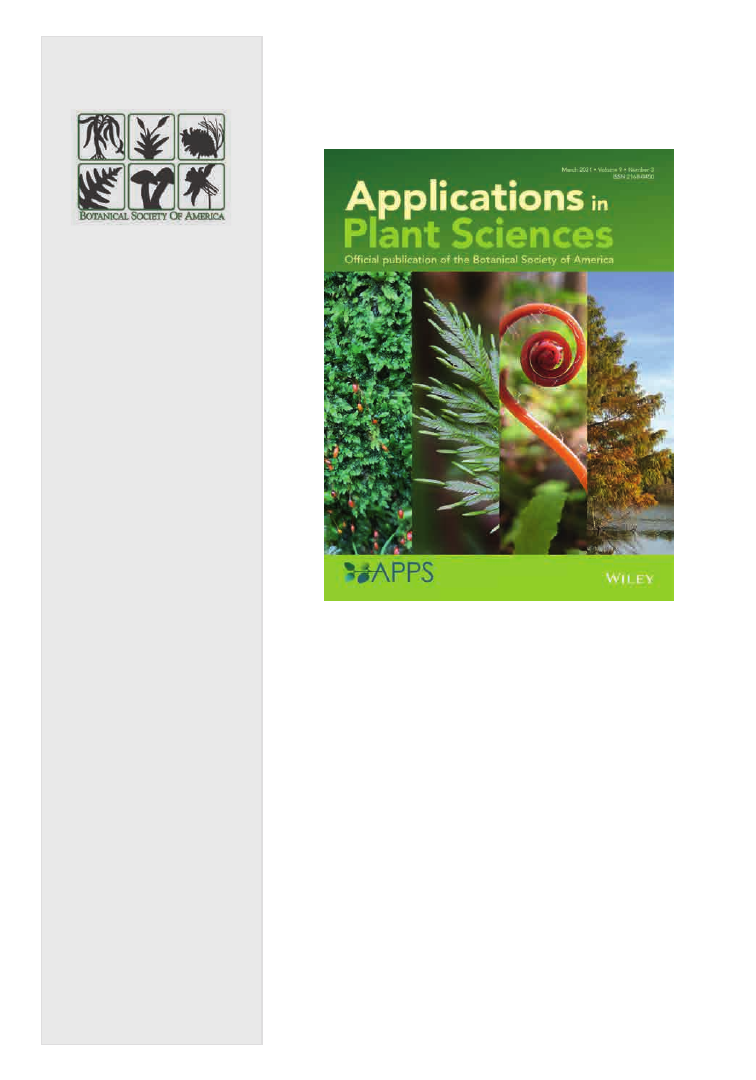
Plant Science Bulletin
The Botanical Society of
America is a membership soci-
ety whose mission is to: pro-
mote botany, the field of basic
science dealing with the study
& inquiry into the form, func-
tion, development, diversity,
reproduction, evolution, & uses
of plants & their interactions
within the biosphere.
ISSN 0032-0919
Published 3 times a year by
Botanical Society of America, Inc.
4475 Castleman Avenue
St. Louis, MO 63166-0299
Periodicals postage is paid at
St. Louis, MO & additional
mailing offices.
POSTMASTER:
Send address changes to:
Botanical Society of America
Business Office
P.O. Box 299
St. Louis, MO 63166-0299
bsa-manager@botany.org
The yearly subscription rate
of $15 is included
in the membership
Address Editorial Matters (only) to:
Mackenzie Taylor, Editor
Department of Biology
Creighton University
2500 California Plaza
Omaha, NE 68178
Phone 402-280-2157
psb@botany.org
Plant Science Bulletin
Spring 2021 Volume 67 Number 1
The March issue of Applications in Plant Sciences launched a
new cover design, which features an image that corresponds
to an article from a current or recent issue. The inaugural
cover image highlights an article published in the January
2021 issue by Breinholt et al.: “A target enrichment probe
set for resolving the flagellate land plant tree of life.” This
article introduces GoFlag 451, a new target enrichment
probe set to help resolve phylogenetic relationships and
unravel evolutionary history across the flagellate land plant
taxa. With over 30,000 extant species, flagellate plants
contain several diverse lineages, including the spore-
bearing bryophytes, lycophytes, and ferns, along with two
lineages of seed plants within the gymnosperms, illustrated
here (from left to right). Image credit: Emily Sessa. Image
design: Jerald Pinson.
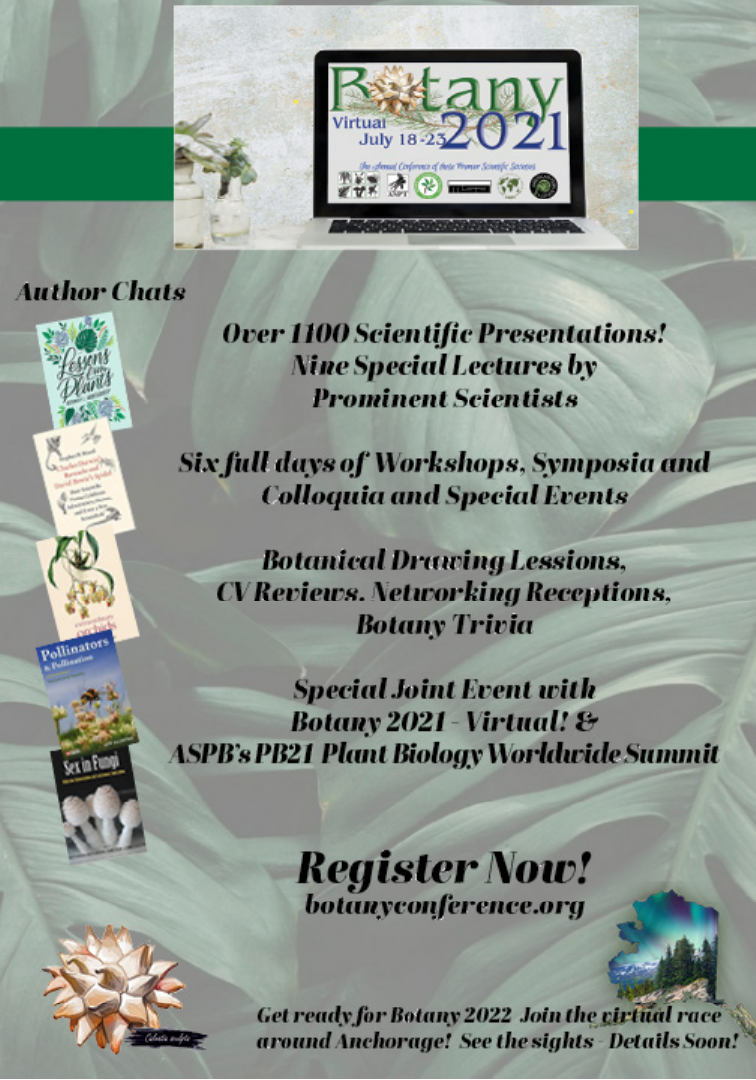
PSB 67 (1) 2021
78
Register Now!
botanyconference.org